

How to Visit Amazon Jungle Peru – Everything You Need to Know
The Amazon Rainforest, often called the Amazon Jungle, is the largest rainforest on Earth.
It spans multiple countries in South America, including Brazil, Peru, Colombia, Venezuela, Ecuador, Bolivia, Guyana, Suriname, and French Guiana.
Hi, we’re Rach & Marty!
We’ve visited every country in the world and want to help you get the most out of your travels!
Whether you need an expertly planned itinerary , some experienced hints and tips , or just craving a delicious food adventure , we’ve got you covered!
We may earn affiliate commissions from websites we link to, at no cost to you. Click here for details.
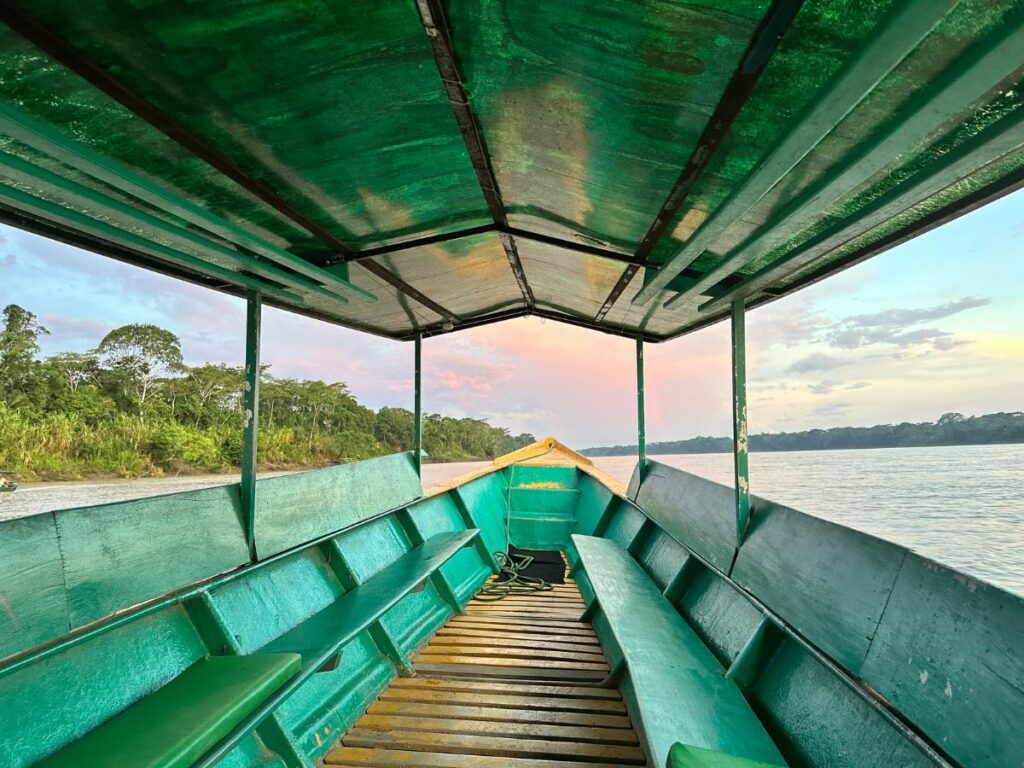
Visiting the Amazon Jungle had been on our bucket list for quite some time, so after spending the best 2 days in Lima , we arranged a side trip to the Amazon Jungle Peru.
To help you plan a visit to the Amazon, I’ve compiled this guide that includes our best travel tips, prices and details on visiting the Amazon Jungle in Peru.
Table of Contents
The Best Time to Go
Exploring the Amazon Rainforest is a year-round possibility, given its consistent weather conditions throughout the seasons. Anticipate warm, rainy, and humid weather, regardless of the time of year.
The wet season spans from January to June, featuring temperatures ranging from 23 to 30ºC (73 to 86ºF). Daily showers are a common occurrence, sometimes with substantial intensity.
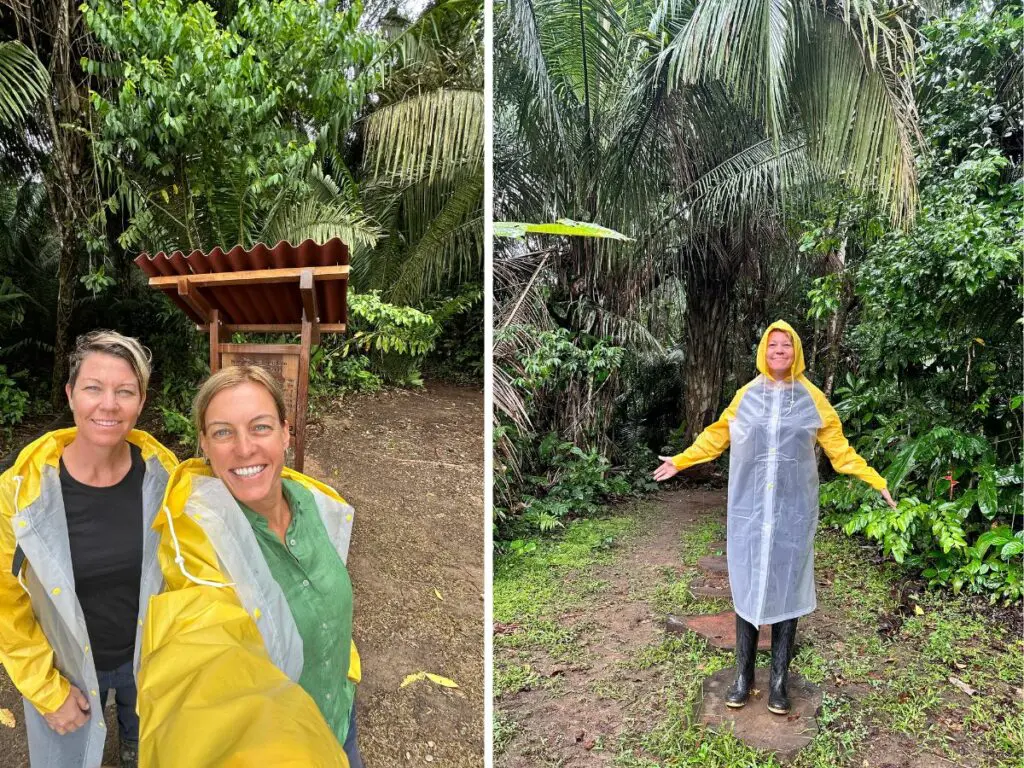
However, it’s important to note that the higher humidity during this period results in more mosquitoes.
The dry season, from July to December, includes the latter half of the year. During this period, temperatures average around 26 to 40ºC (78 to 104ºF). While there is less rain, occasional heavy showers can still occur. Reduced rainfall results in a drier atmosphere in the jungle and lower river levels.
This creates advantageous conditions for exploration on foot and provides an excellent chance to spot caimans as they contend for diminished food supplies.
The most popular time to visit the Amazon is in July and August. The height of water in the jungle is reasonable, and you have a higher chance of spotting more wildlife.
Where to Go And How to Get There
Two notable areas in the Peruvian Amazon jungle are popular for ecotourism and wildlife experiences.
- Iquitos, the largest city along the Amazon River in the Peru jungle, is the northern gateway to the Peruvian Amazon basin.
- Puerto Maldonado is a city in southeastern Peru in the Madre de Dios region, part of the Amazon rainforest. It serves as a gateway to the Tambopata and Manu National Reserves, two of the most biodiverse areas in the Amazon rainforest.
When planning your journey, there’s no rule on choosing the best area of the Amazon to visit, but you should consider your itinerary.
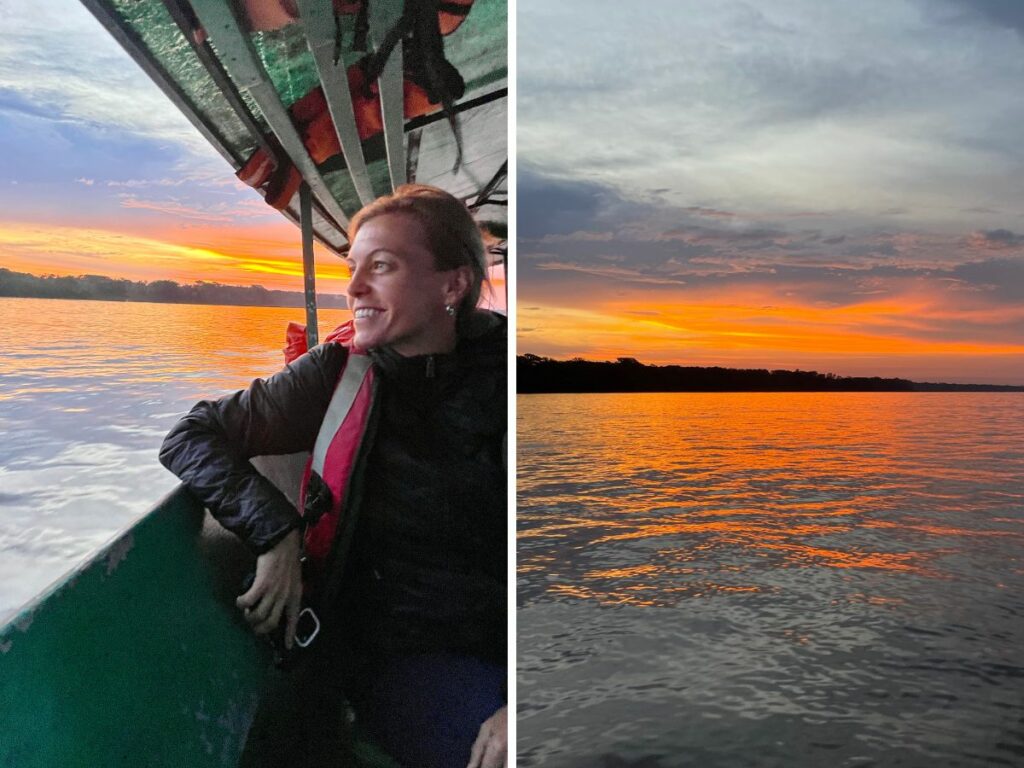
For instance, diverting to Iquitos might be impractical if you travel to Cusco or Lima. Instead, destinations like Manu National Park or Puerto Maldonado, the entry point to the Amazon rainforest, are closer and logistically make sense.
You can book a flight to Iquitos or Puerto Maldonado from Lima or Cusco. You can also take a bus from Cusco to reach these cities to begin your Amazon Jungle experience; this is the most affordable option.
While visiting Lima, we booked this 3 Day Jungle Tour to explore the Tambopata National Reserve.
We started our Amazon Jungle trip by booking a flight from Lima to Puerto Maldonado on Skyscanner and found the price of flights to be very reasonable.
The Perfect Itinerary for 2 Days in Lima
How Many Days Do You Need in the Amazon Jungle Peru
We’d recommend setting aside a minimum of three days to visit the Amazon Jungle in Peru.
In this timeframe, you can embark on several excursions that provide a glimpse into the captivating offerings of this region.
The most popular Amazon Jungle packages are 3 or 4 nights
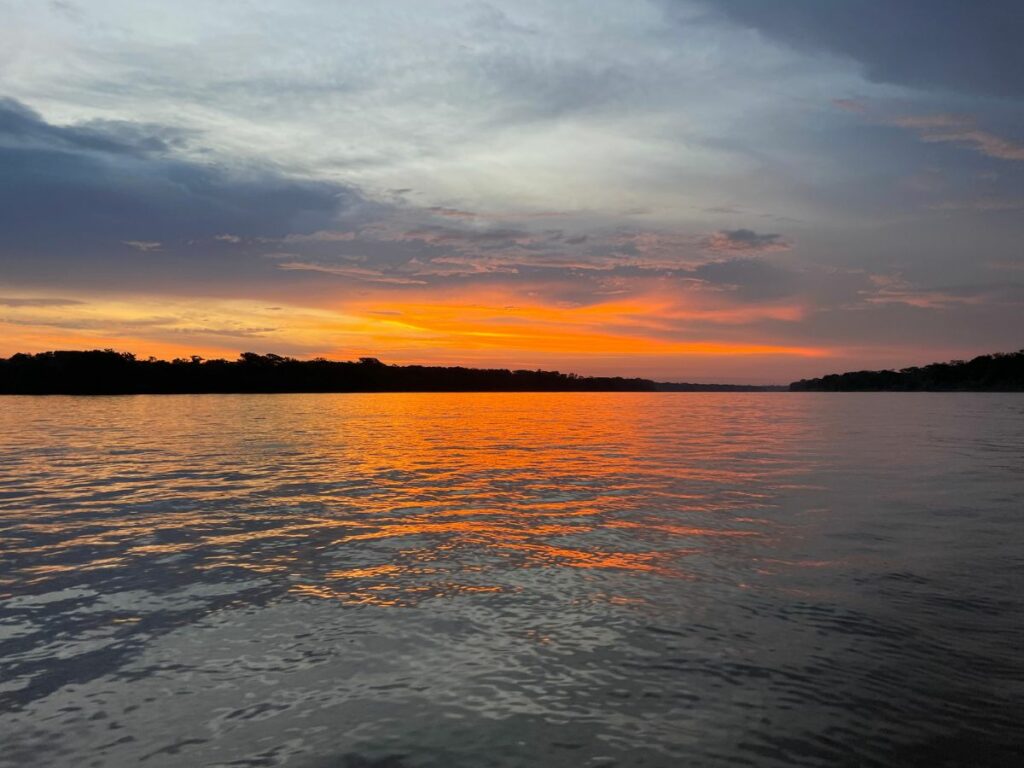
Travelling to a country with a different currency? Avoid ATM transaction fees and pay in local currency with a Wise Card . We love this card; it has saved us so much in fees.
Book A Tour or Travel Independently
We usually travel independently and book logistics as we go; however, after crunching numbers and working out the logistics of getting around in the Amazon Jungle in Peru, we found that it was much easier and more economical for us to book a packaged tour.
There are many tour operators to choose from online. After comparing many options, we decided to book this 3 Day/2 Night Amazon Jungle trip as it’s a Peruvian-owned company with excellent reviews from past guests.
For this complete package, including airport transfers, 2 nights’ accommodation in a bungalow Garden Lodge (with private ensuite facilities), all meals, drinking water, activities and a local guide, we paid approximately USD 350 per person, as we booked a nicer room with private facilities.
VIEW this 3D/2N Amazon Jungle Tour
- 🔥 Hot Tip: Book accommodation on Booking.com
- 🎟 Book your tickets online: We use Viator and GetYourGuide
- 🔋 Stay charged: This Belkin Power Bank is essential!
- 📸 Join a Group Tour: View our tours OR search Tourradar
- ✅ Get Connected with eSIM: Easy and affordable! View eSIM
Where To Stay
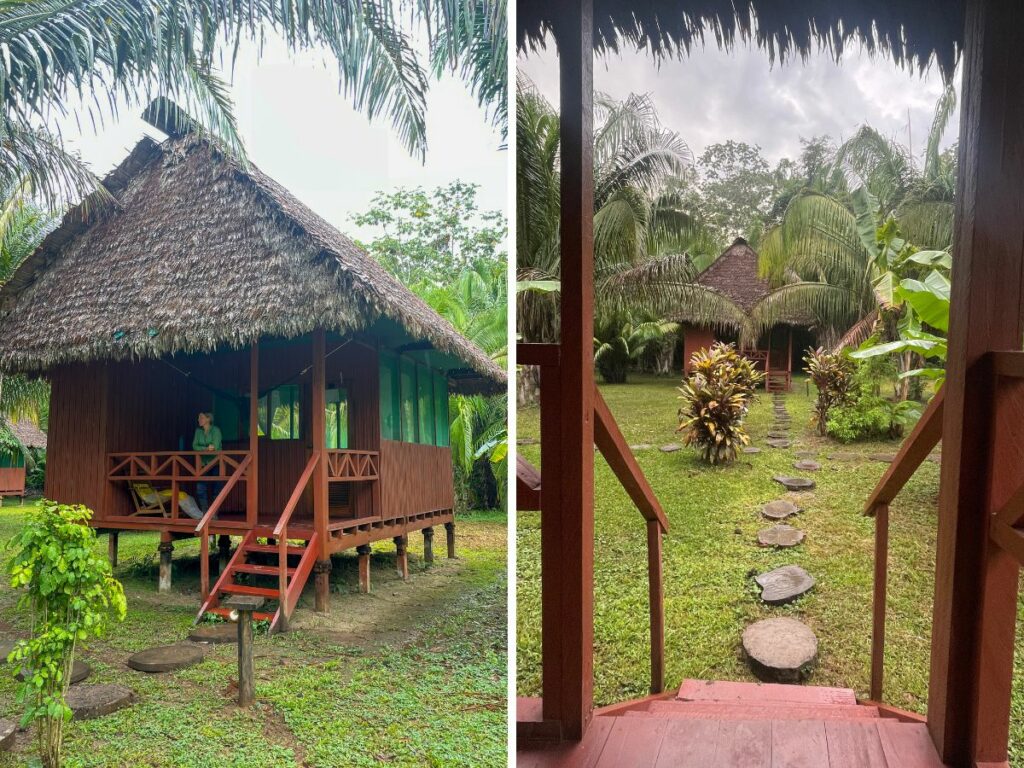
The overall accommodation style in the Amazon Jungle Peru is typically jungle lodges in various regions.
The choice is up to you whether you opt for a remarkably luxurious or more basic option. You can expect comfortable accommodations in these lodges, usually in twin-share or double cabins with attached ensuite bathrooms.
It’s important to remember that your lodge is in a remote location, so electricity may only be available for specific hours during the day. This was the case with our lodge, so whenever electricity was available, take the opportunity to charge your phone, cameras etc.
The rooms have mosquito nets and fans to ensure a cool and protected night’s sleep.
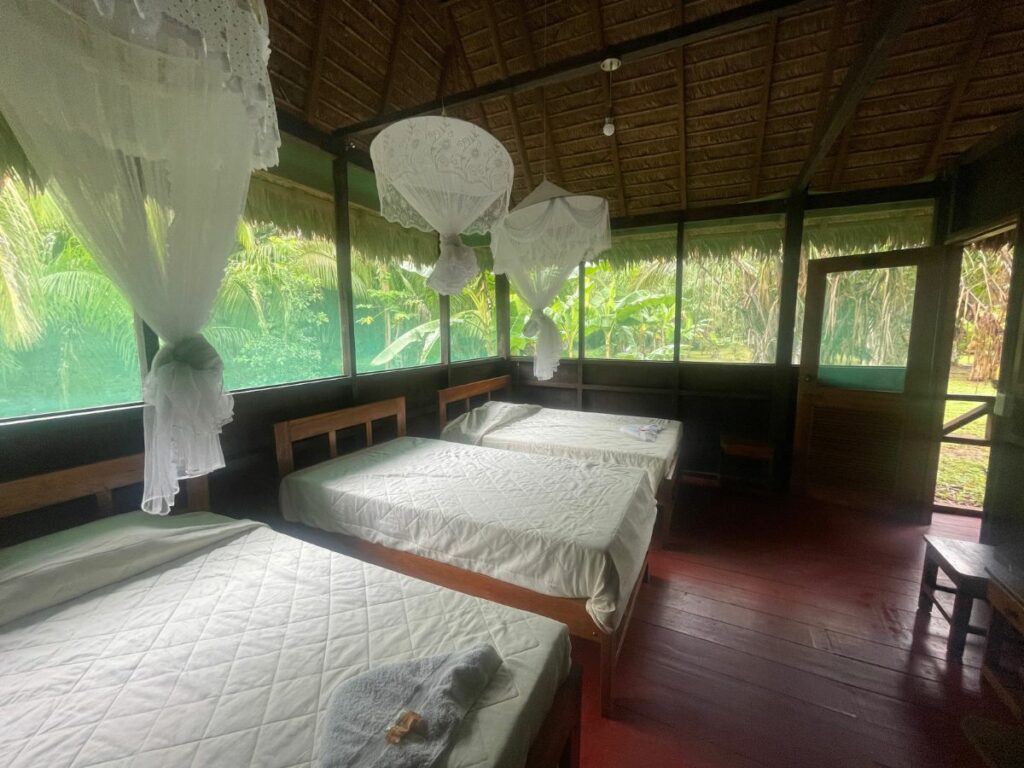
You may choose a bungalow accommodation with shared bathroom facilities for those travelling on a budget.
Most of the lodges are within a 1-1.5 hour boat ride from Puerto Maldonado Boat Pier.
Accommodation providers usually offer all-inclusive packages that include transfers from Puerto Maldonado airport, accommodation, all meals, and several daily excursions.
Amazon Jungle Lodges in Peru
Numerous jungle lodges are situated along the river, ranging from inexpensive ones with very basic amenities to more stylish lodges with comfortable bungalows.
Here are my top picks for Amazon jungle lodges for varying budgets:
BUDGET: Hacienda Herrera Tambopata – Offering garden views, this property provides accommodation, a garden and a terrace. Pick up and drop off from airport or bus station is provided for free, has to contact property for arrengments. Is a 20 min boat ride from El Triunfo Port to the lodge.
MID-RANGE: Amazon Planet – A true ecolodge within a protected area surrounded by rainforest and wild animals in their natural habitat. Free airport transfers, river transfers, all meals are included. Jungle excursions and adventure activities in the area such as treking, biking, fishing, and boat rides can be arranged.
Full program itineraries are available for an add-on rate. The rooms in Amazon Planet feature private bathrooms and terraces. Breakfast is served daily. The on-site restaurant offers a daily menu and can cater to special diets upon request.
LUXURY: Inkaterra Reserva Amazonica – Located in the Peru Amazon Jungle, this hotel features tours to the rainforest, a massage spa overlooking the Madre de Dios forest and rooms with hammocks and balconies. Breakfast, lunch, and dinner are included in the rates.
There are eco-friendly bathroom amenities and private bathrooms. The hotel is a 45-minute boat ride from Puerto Maldonado. Cusco is a 25-minute flight away.
View ALL Lodge Accommodation in Tambopata National Reserve
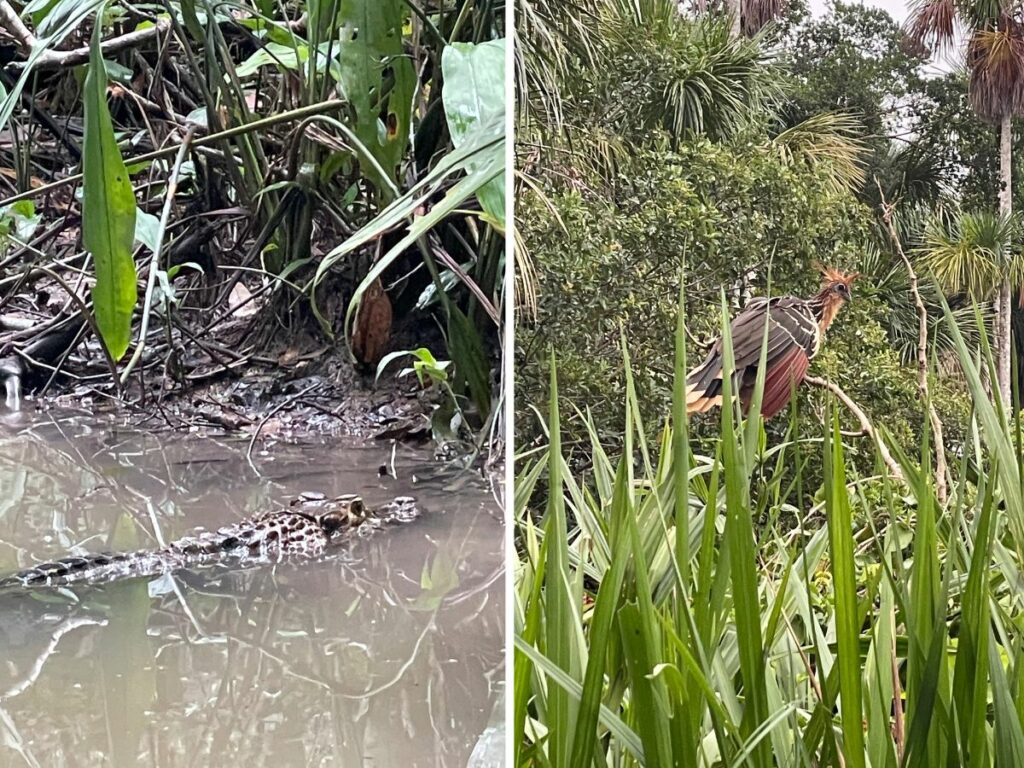
The Perfect 2 Days in Lima Itinerary
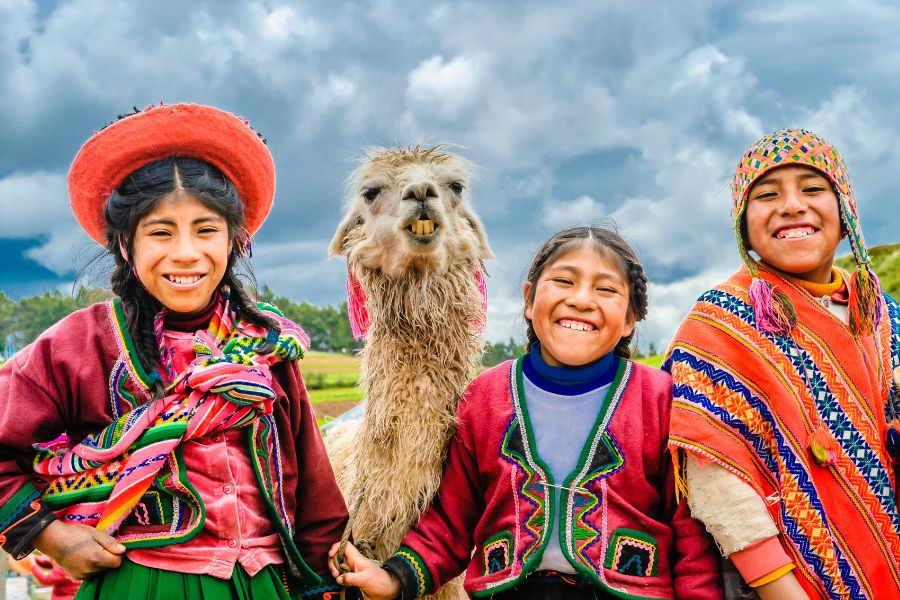
5 Cheapest Countries to Visit in South America
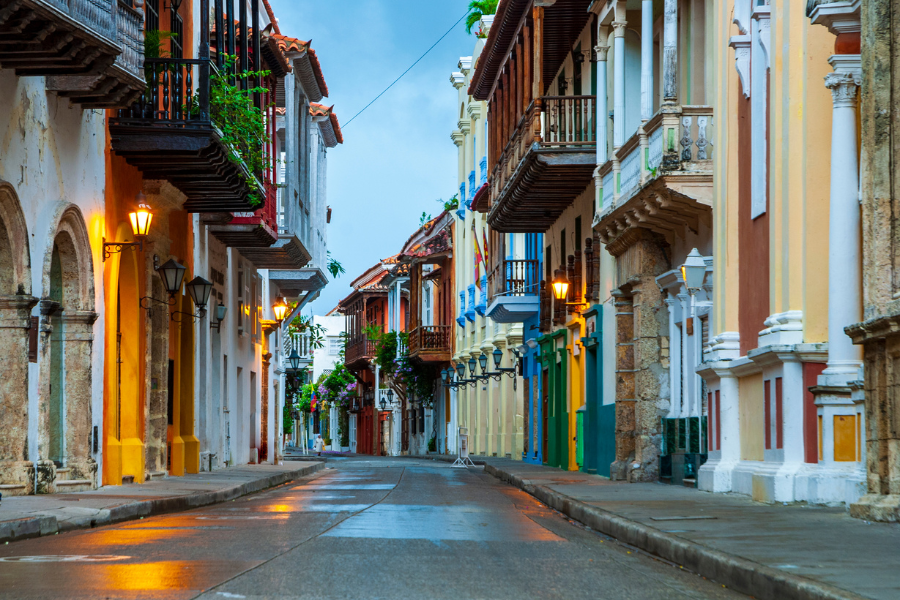
15 of The Best Places to Visit in South America
What You Can See in the Amazon Jungle in Peru
The Amazon jungle in Peru is like a vast garden with many plants. You’ll find towering trees, like the Ceiba and Kapok, that stand really tall. Some trees, like the rubber tree, have been essential for making rubber.
There are plants that people have used for medicine for a long time, like the Cinchona tree, which helps treat malaria, and the Cat’s Claw, which indigenous communities have used traditionally.
On the trees, you’ll see colourful plants called bromeliads and orchids. Palms, like the Açaí and Assai, give us tasty fruits.
Vines and climbers, such as the vanilla orchid and passionflower, make the forest look even more beautiful. All these plants create a rich and amazing environment in the Peruvian Amazon rainforest.
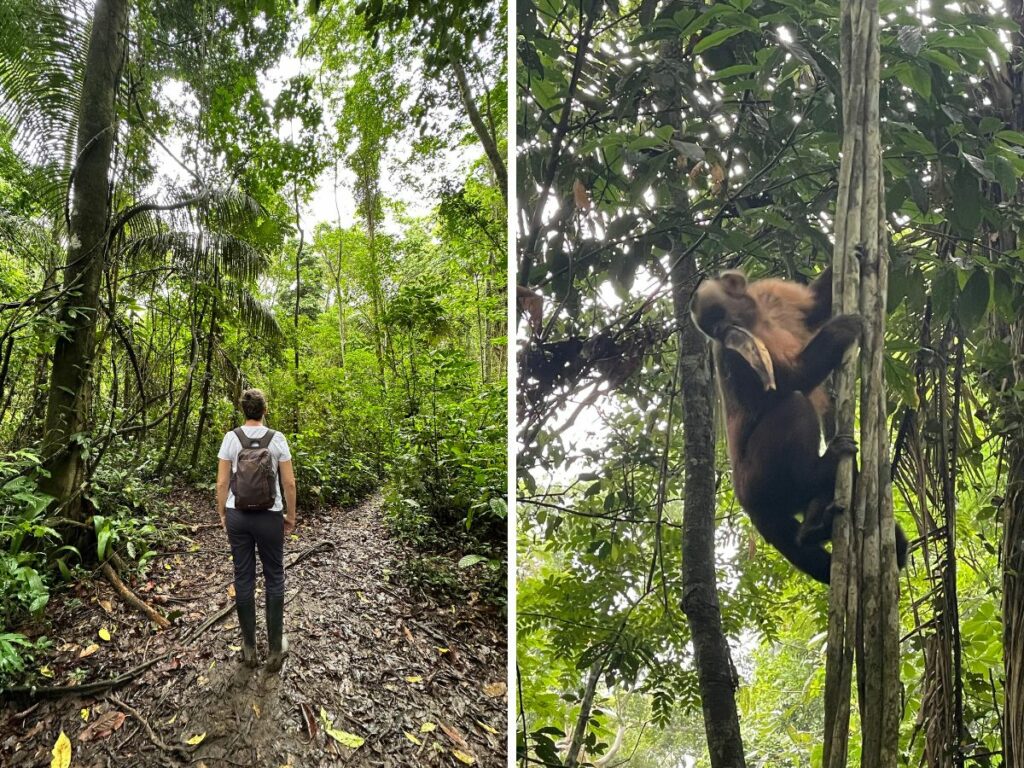
The most commonly seen animals in the Amazon jungle are monkeys (squirrel monkeys and howler monkeys), caimans, sloths, frogs, tarantulas, piranhas, and birds such as herons, and the hoatzin (stink bird).
If you’re fortunate, you may see the endangered giant otter.
Of course, the frequency and proximity of wildlife sightings often depend on luck when exploring the Amazon Jungle.
Nonetheless, it remains a fantastic destination with ample opportunities to encounter and observe various forms of wildlife.

Activities in the Peruvian Amazon Jungle
With its distinctive geography and captivating flora and fauna, the Amazon Jungle in Peru offers some incredible places to visit and activities to engage in.
Here are some of the best ways to explore and appreciate this region and its wonders.
Jungle Walk: Take a trek through the rainforest accompanied by your guide, who will showcase and educate you about a diverse array of exotic plants and wildlife.
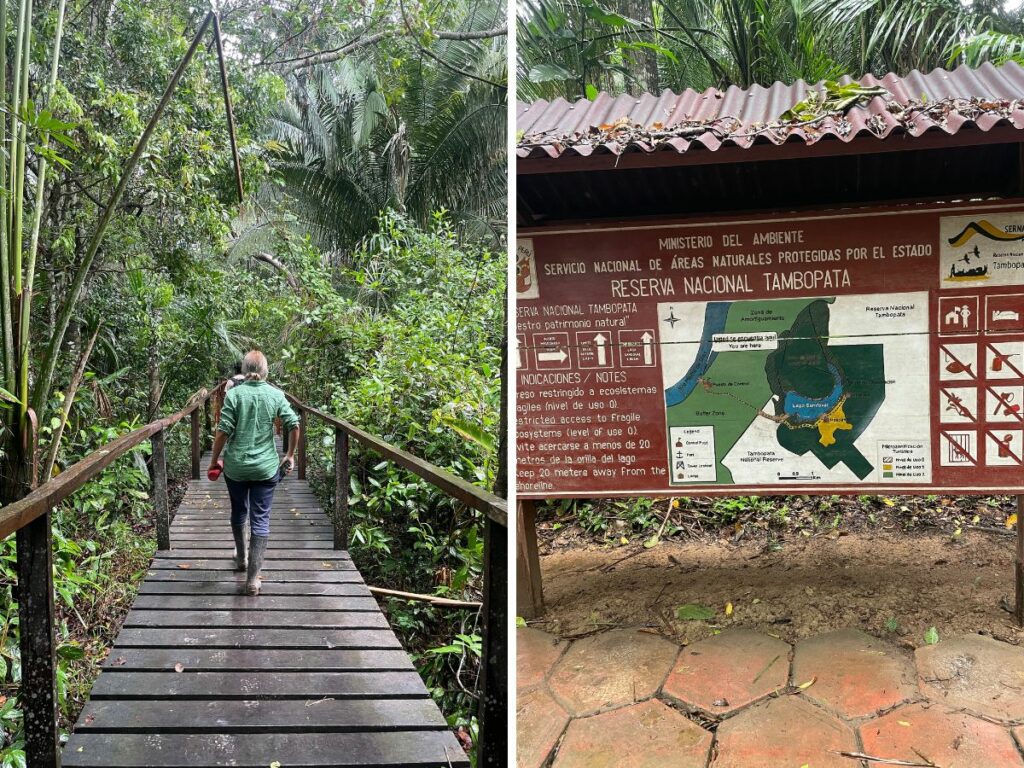
Go Kayaking on the River: Explore the calm waters of small rivers and lakes with a kayak, offering opportunities to observe caimans and various birds.
Go Fishing: Drop in a line and see if you can catch dinner! Don’t expect to catch a large fish, but it’s a fun activity, and you can enjoy a spot of birdwatching at the same time.
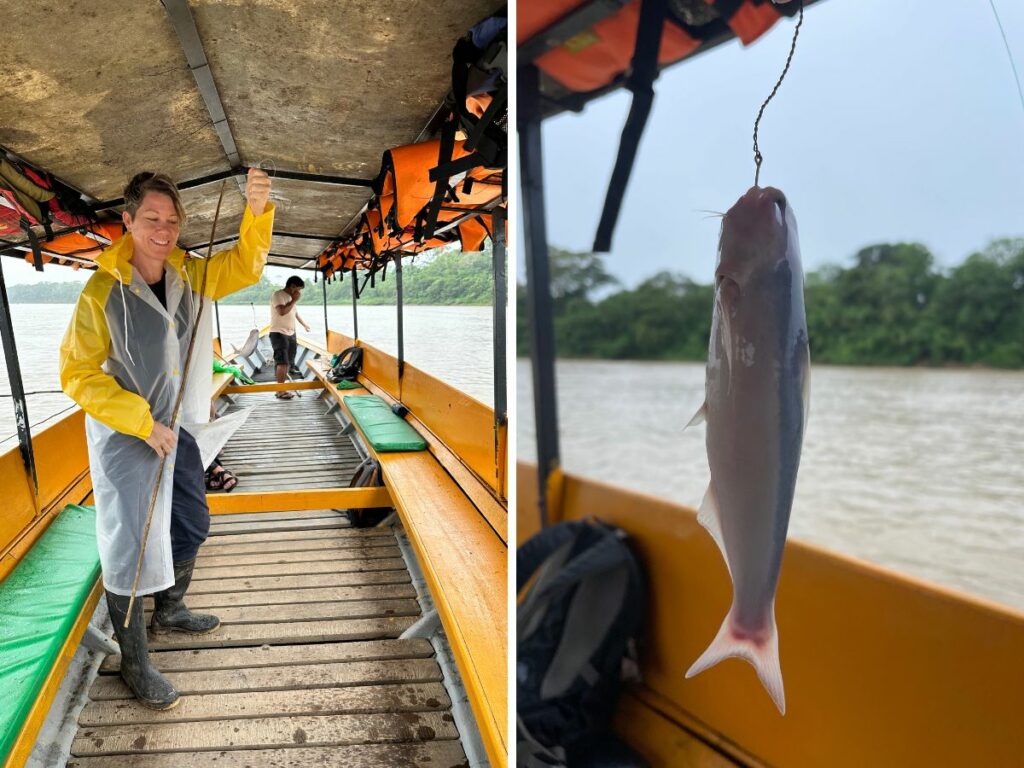
Discover Lake Sandoval: Visit Lake Sandoval, which is located in the Tambopata National Reserve. Hike 3 km through the park to reach the shores of Lake Sandoval.
Ride on a paddle boat on the lake and look for birds such as hoatzins, monkeys, and various flora. This activity was a real highlight of our trip to the Amazon Jungle in Peru.
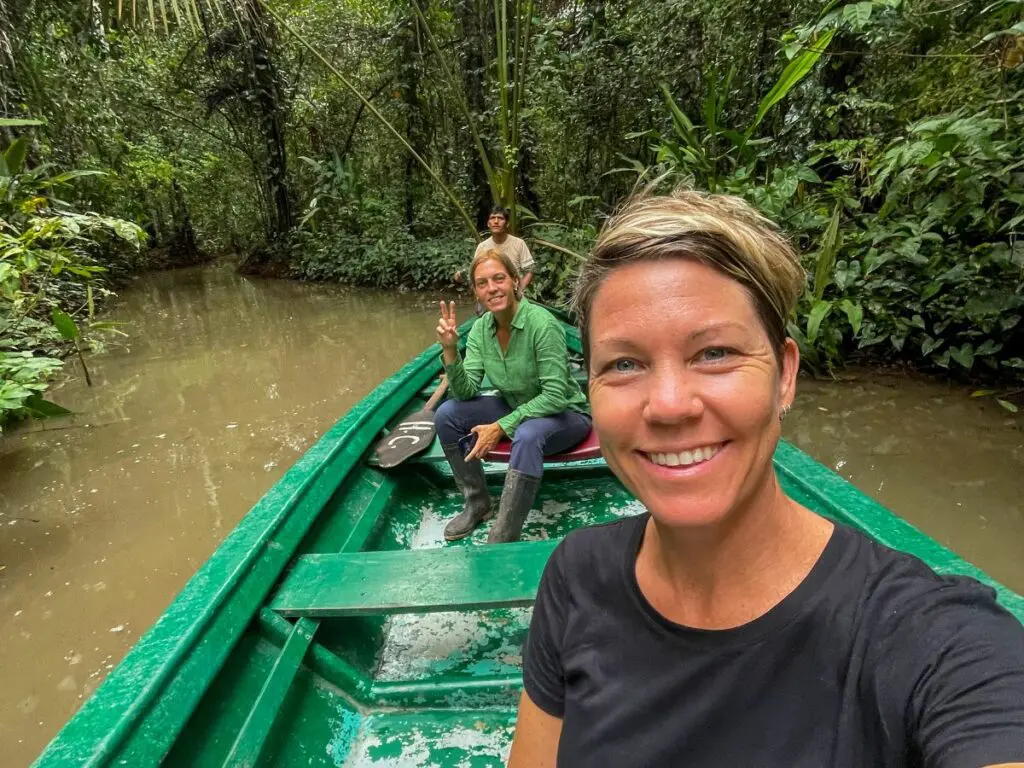
Make sure you get Travel Insurance before hitting the road. We recommend Heymondo & SafetyWing
Click here and get 5% off Heymondo from us!
What to Pack for Amazon Jungle in Peru
We recommend packing some lightweight, moisture-wicking clothing, and you will need a waterproof jacket (or poncho ); plus, it’s worth considering waterproof pants .
TIP: Dress in light, neutral colours to avoid mosquitoes.
Trousers and long sleeves are necessary when taking jungle walks to protect yourself from mosquitoes and spikey plants.
Add the following items to your packing list:
- A head torch for night walks through the jungle.
- Binoculars for a closer look at the Amazon wildlife.
- A good power bank to charge your electronics, as electricity is limited.
- Mosquito repellent is essential whether you travel in the wet or dry season.
- Practical walking or trekking shoes , although rubber gumboots are usually provided.
- A wide-brimmed hat to protect your head from the sun during river cruises.
- Sunscreen – it gets scorching in the Amazon Jungle.
- A reusable water bottle to keep hydrated. Your accommodation provider will provide drinking water during your stay.
- A good book – View our recommendations for great travel books .
Get Connected with eSIM

Get connected easily on your travels—buy an eSIM! It works like an app: buy it, download it, and get connected in minutes! It’s easy, affordable, and convenient. Keep your original phone number, too!
Use our code: RACHEL5045 to get $3 off your first purchase!
Recommended Tours to the Amazon Jungle in Peru
Check out these top-rated tours below for those who prefer to reserve everything in advance.
We hope you enjoyed reading more about how to visit the Amazon Jungle in Peru. Have you visited the Peruvian Amazon? Would you add any tips to this guide? Please let us know in the comments below.
If you’re heading to Buenos Aires in Argentina (and we highly recommend you do), this 2 Days in Buenos Aires Itinerary is essential to read.
Don’t forget to check out these 16 Best Restaurants in Buenos Aires ; what an excellent food city!
Travel Tips for South America
We have many travel guides and tips for South America—a colourful and vibrant continent!
We believe these are the 15 best places to visit in South America.
Are you travelling on a budget? These five cheapest countries in South America will help you plan an itinerary that lets you see as much as possible.
Furthermore, if you plan to travel long-term (or at least until the money runs out), these 21 cheapest countries to visit will help you make your hard-earned dollars stretch a bit further.
Delicious cuisine can be enjoyed across South America. There’s Colombian cuisine , Venezuelan food , the food in the Dominican Republic , Brazilian cuisine , and even Guyanese cuisine to inspire you on your culinary journey.
For food lovers, don’t miss our top 10 best countries for food.
Would you like some suggestions for packing for your South American adventure? Our ultimate packing list for travellers has you covered for the essentials.
These top 6 travel hacks to save money are great to read when planning your travels. Try these 5 popular foods in South America ; they’re delicious!
You’ll need to stay connected while travelling in South America. We recommend eSIM. It’s easy, reliable and affordable. View eSIMs for individual countries , or consider a regional eSIM for Latin America (which covers 19 countries).
If your travels in Latin America are part of a much larger global adventure, then a Global eSIM may be the answer. It connects you in 124 countries , offering data-only eSIM and data/call/text eSIM . The Global eSIM has been a game-changer; we couldn’t imagine travelling without it now.
If you want to travel with like-minded travellers, consider joining a group tour. Check out our Group Tours first for any upcoming departures in Latin America, or view Tourradar deals on group tours in Latin America .
Check out our best-ever travel tips compiled from more than twenty years of experience.
Travel Planning Resources
✈️ Flights : We use Skyscanner to book cheap flights worldwide.
🏨 Accommodation : Booking.com is our preferred platform for booking hotels and accommodation. We use Vrbo to book apartments and long-term stays.
🏥 Travel Insurance : We recommend Heymondo ( Get 5% off Heymondo) & SafetyWing
🚌 Transportation : Trainline is the best website to reserve trains. We use Omio to book transport worldwide. For travel in Asia, we use 12Go.
🚘 Car Rental : We use DiscoverCars to book rental cars worldwide.
👫 Group Tours : We now offer Group Trips; check them out here . Alternatively, we recommend G Adventures OR Tourradar .
📸 Day Tours & Trips : GetYourGuide & Viator are the only two platforms you need.
📚 Lonely Planet: The Best Range of Travel Guides & Ebooks , and FREE Shipping! (use code RACHELDAVEY10 for a 10% discount)
🎒 Luggage : Osprey Farpoint 40L Backpack or Samsonite Luggage Range.
🛄 What to Pack: Don’t forget your Universal charger and a good power bank . To help you pack the essentials, here is our ULTIMATE Packing List for all Travellers .
🐶 Become a House Sitter: Join Trusted Housesitters and enjoy FREE accommodation worldwide. Use our invite to receive 25% off your new membership.
💰 Send Money Anywhere: WISE & Revolut are the best online accounts that let you send money, get paid, and spend money internationally. Both are so easy to use and way cheaper than any bank transfer.
📶 Stay Connected: Airalo eSIM allows you to get connected the moment you land at your destination, and you can avoid those expensive data roaming charges. We LOVE this product! Use promo code NOMAD15 for 15% off ALL eSIMs (new Airalo users only) OR use NOMAD10 for 10% off ALL eSIMs (for existing Airalo users)
✅ Check out our Travel Gear and Travel Resources for more valuable tips to save you money!
Tasty Food Adventures

25 Popular Foods From Morocco – A Morocco Food Guide

25 Most Popular Foods from Bangladesh

Food in Rome You Need to Try – 10 AMAZING Dishes

20 Delicious Foods From Portugal You Need to Try
See all Food Adventure blogs
Expert Travel Guides
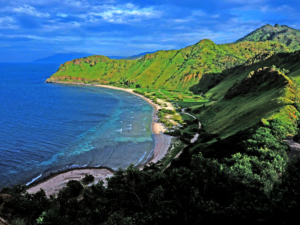
How to Get an East Timor Visa on Arrival
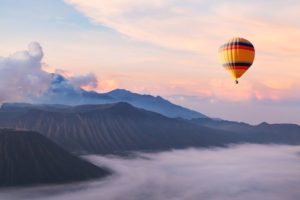
99 Quotes About Adventures That Will Ignite Your Wanderlust

5 Reasons To Love Kuala Lumpur
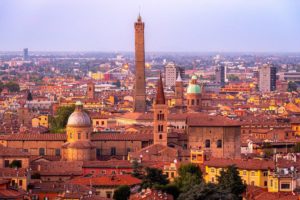
12 Amazing Things to Do in Bologna Italy
See all our Travel Guides
Trusted Hints & Tips

How to Start a Travel Blog: A Step-by-Step Guide

Should you Fly with Scoot? An Honest Review

Bad Travel Days – The Downside Of Travel

5 Things I Really Hate About Air Travel
See all our expert Hints & Tips

Top 5 Popular Foods in South America
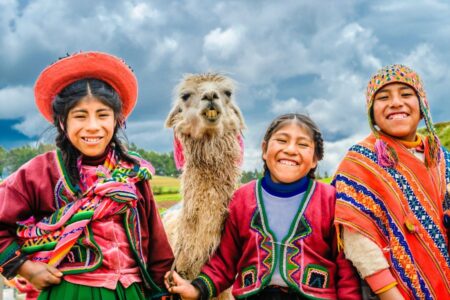
eSIM Peru – The Best SIM Card for Peru (2024)
Leave a reply cancel reply.
Your email address will not be published. Required fields are marked *
Post Comment

Ultimate Guide to Visiting the Amazon in Peru: Iquitos, Manu National Park & Puerto Maldonado
Embarking on the adventure of a lifetime begins with the promise of immersing yourself in the awe-inspiring wonders of nature. Visiting the Amazon in Peru is not just a journey; it’s a rendezvous with the heart of the world’s largest rainforest, an ecosystem teeming with unparalleled biodiversity. In this comprehensive guide, we unveil the secrets of three exceptional destinations— Iquitos, Manu National Park, and Puerto Maldonado— each offering a distinct tapestry of experiences in the Peruvian Amazon. From the vibrant rhythms of Iquitos to the pristine wilderness of Manu and the gateway to the extraordinary Tambopata Reserve in Puerto Maldonado, prepare to unlock the mysteries of this mesmerising realm. This is your ultimate passport to the untamed beauty of visiting the Amazon in Peru.
This article contains affiliate links from the Amazon Associate and Travelpayouts programs. Wild Travel Tales will earn from qualifying purchases, at no extra cost to you .
The Peruvian Amazon: A Breathtaking Tapestry of Diversity
The vastness of the Peruvian Amazon, covering 7,000,000 km², with 5,500,000 km² as pristine rainforest, makes it a jewel in South America’s crown. A staggering 13% of this ecological wonder belongs to Peru, ranking second only to Brazil. Despite this vast expanse, a mere 5% of Peru’s population calls the Amazon home, underscoring the untamed nature of this jungle paradise.
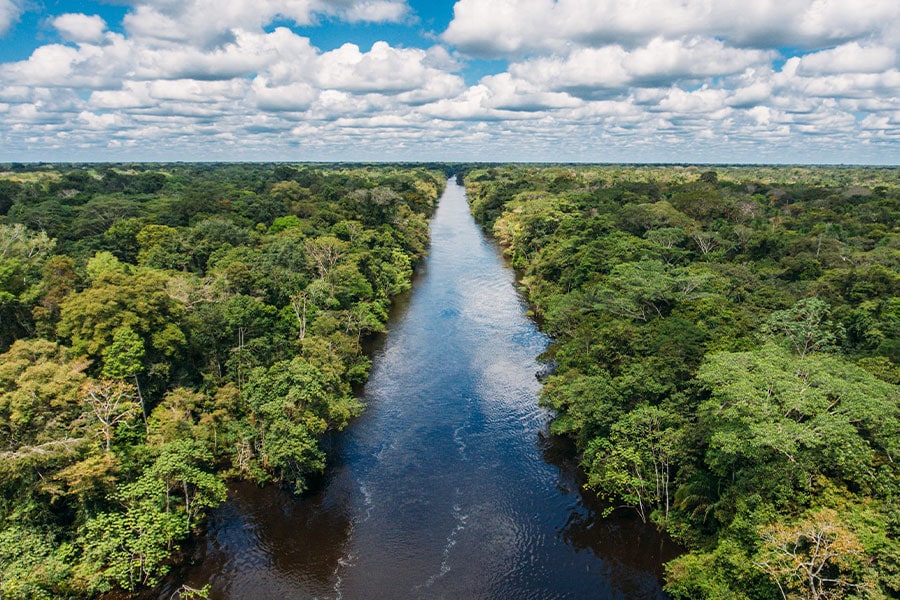
Navigating the Amazonian Tapestry: A Guide to Your Expedition
Where to go & how to get there.
Selecting the perfect destination in the Peruvian Amazon requires strategic planning. Whether you choose the verdant landscapes of Pacaya Samiria, the cultural richness of Chachapoyas, the vibrant cityscape of Iquitos, or the accessibility of Central Selva, each promises an immersive experience. Travel logistics play a crucial role, and we guide you on how to navigate the rivers, roads, and airways to reach your chosen haven.
The Peruvian Amazon caters to both adventure enthusiasts and luxury travelers, offering a wide range of destinations with suitable infrastructure. Ensuring a seamless match with your budget and travel preferences is easily achievable. As you plan your journey, it’s valuable to note that the term “selva,” meaning jungle, is commonly employed in the region.
Carefully curated, our selection includes popular destinations where travelers commonly embark on their jungle adventures. While accessibility and locations may vary, the allure of the Peruvian Amazon lies in the consistent wonders of its flora and fauna, creating a truly magnificent experience across the board.
Visiting the Amazon from Iquitos
As the world’s largest city inaccessible by road, Iquitos stands as a unique gateway to the Amazon. Nestled along the banks of the Amazon River, this vibrant city offers a distinctive starting point for your Amazonian adventure. Visiting the Amazon from Iquitos is the best way to fully immerse yourself in the jungle.
Explore the bustling markets, immerse yourself in local culture, and embark on river journeys that unveil the rich biodiversity of the Peruvian Amazon. This is the perfect way to get deeper into the Amazon, particularly if you spend more than two days immersed in the jungle. Iquitos is only accessible via boat or air. You can get affordable flights to Iquitos airport from Lima.
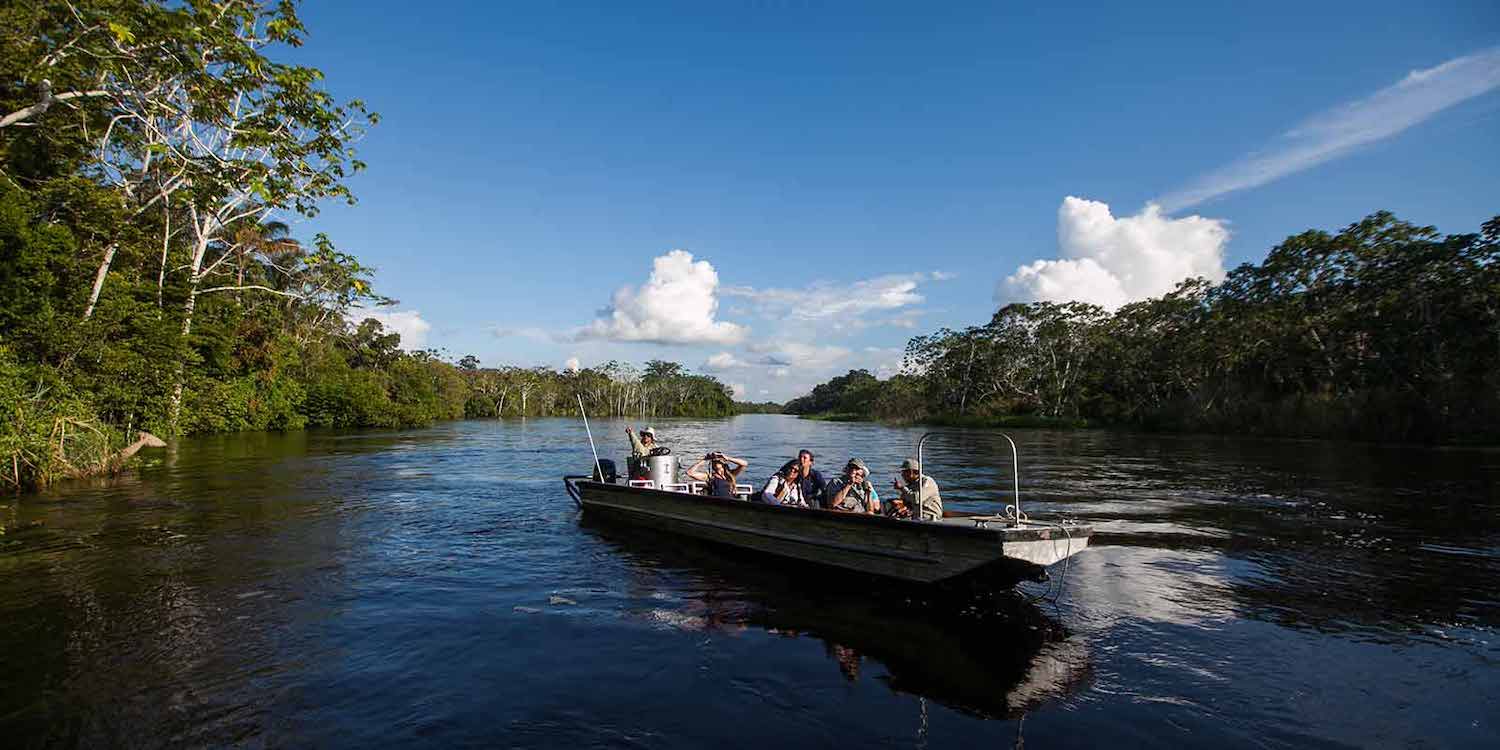
Chachapoyas
Northern Peru often escapes the radar of international travelers, yet, in our perspective, it boasts a plethora of attractions, including the pre-Incan Kuelap ruins, the majestic Gocta Waterfall, the stunning Sonche canyon, and numerous burial sites.
Serving as the gateway to this region is Chachapoyas, a city frequently regarded as perched on the edge of the Amazonas region. While the humidity and abundant flora and fauna provide a jungle-like ambiance, those seeking a more immersive experience may opt to venture further inland, embarking on a day-long journey to the town of Tarapoto—an intriguing option.
Central Selva
Exploring the jungle in central Peru brings the advantage of excellent connectivity from the capital city, Lima. Though the journey may still be challenging, improved roads and remarkable wildlife, especially for birdwatching enthusiasts, make it a worthwhile venture.
Consider the Chanchamayo Province for your adventure, which, in our view, resembles an average cloud forest akin to those seen in Mindo, Ecuador. Alternatively, expand your itinerary to include Oxapampa, Pozuzo, or Pucallpa.
Manu National Park: UNESCO’s Crown Jewel
Explore the wonders of Manu National Park, a UNESCO World Heritage site, conveniently accessed from Cusco. Dive into the diverse ecosystems, each revealing a unique facet of the Amazon’s biodiversity. Navigate through the park’s zones, from the cultural to the reserved, for an unparalleled encounter with nature.
While the cultural zone, where local communities reside, offers high chances of wildlife spotting, we recommend the reserved zone for a deeper exploration. Note that not all travel agents have permission to access the reserved zone, underscoring the importance of a wise choice.
Puerto Maldonado: Gateway to Tambopata’s Riches
Puerto Maldonado beckons with its diverse offerings, accessible by air or an adventurous bus journey. Discover the famed Reserva Nacional Tambopata and unveil the treasures it holds. We provide insights into budget-friendly accommodations like Hostal Tropical Inn and opulent retreats like Hotel Enai.
Is it Worth Visiting the Amazon in Peru?
Embarking on a journey to the Amazon in Peru is a decision that promises an unparalleled adventure, but is it truly worth the trek into this vast and diverse region? The resounding answer is a definitive yes. The Peruvian Amazon, encompassing approximately 60% of the entire country, beckons with its awe-inspiring natural wonders and cultural richness.
Unique Biodiversity: One of the primary reasons to venture into the Peruvian Amazon is its unparalleled biodiversity. Home to almost 1900 bird species, about 500 mammal species, and a myriad of other flora and fauna, this region stands as a paradise for nature lovers. From iconic pink dolphins to elusive jaguars, the Amazon unfolds a captivating tapestry of wildlife that is sure to leave you in awe.
Cultural Enrichment: Beyond its biological diversity, the Peruvian Amazon offers a unique cultural experience. Indigenous communities call this rainforest home, and a visit provides an opportunity to engage with their traditional way of life. From learning about medicinal plants to experiencing indigenous rituals, the cultural aspect of the Amazon adds a layer of depth to your journey.
Adventurous Activities: For those seeking an adrenaline rush, the Amazon doesn’t disappoint. From challenging jungle walks and night canoeing under the starlit sky to venturing into remote areas, the adventurous activities in the Peruvian Amazon cater to various tastes. Whether you choose to explore on foot or navigate its intricate waterways, the Amazon presents a playground for intrepid explorers.
Environmental Significance: Often referred to as the “Lungs of the World,” the Amazon rainforest plays a crucial role in maintaining the planet’s ecological balance. Visiting this natural wonder allows you to witness firsthand the environmental significance of preserving this ecosystem. It instills a sense of responsibility for the conservation of the Amazon’s unique and fragile environment.
Unforgettable Experiences: While the journey may not be the most budget-friendly, the experiences garnered from a trip to the Amazon are priceless. Be it camping in the heart of the rainforest, encountering wildlife in its natural habitat, or connecting with local communities, the memories forged in the Amazon become indelible imprints on your travel chronicles.
In conclusion, the Peruvian Amazon is not merely a destination; it’s an immersive journey that offers a transformative travel experience. Whether you’re a nature enthusiast, cultural aficionado, or adventure seeker, the Amazon in Peru beckons with open arms, promising a sojourn that transcends the ordinary and leaves an indelible mark on your wanderlust-filled soul.
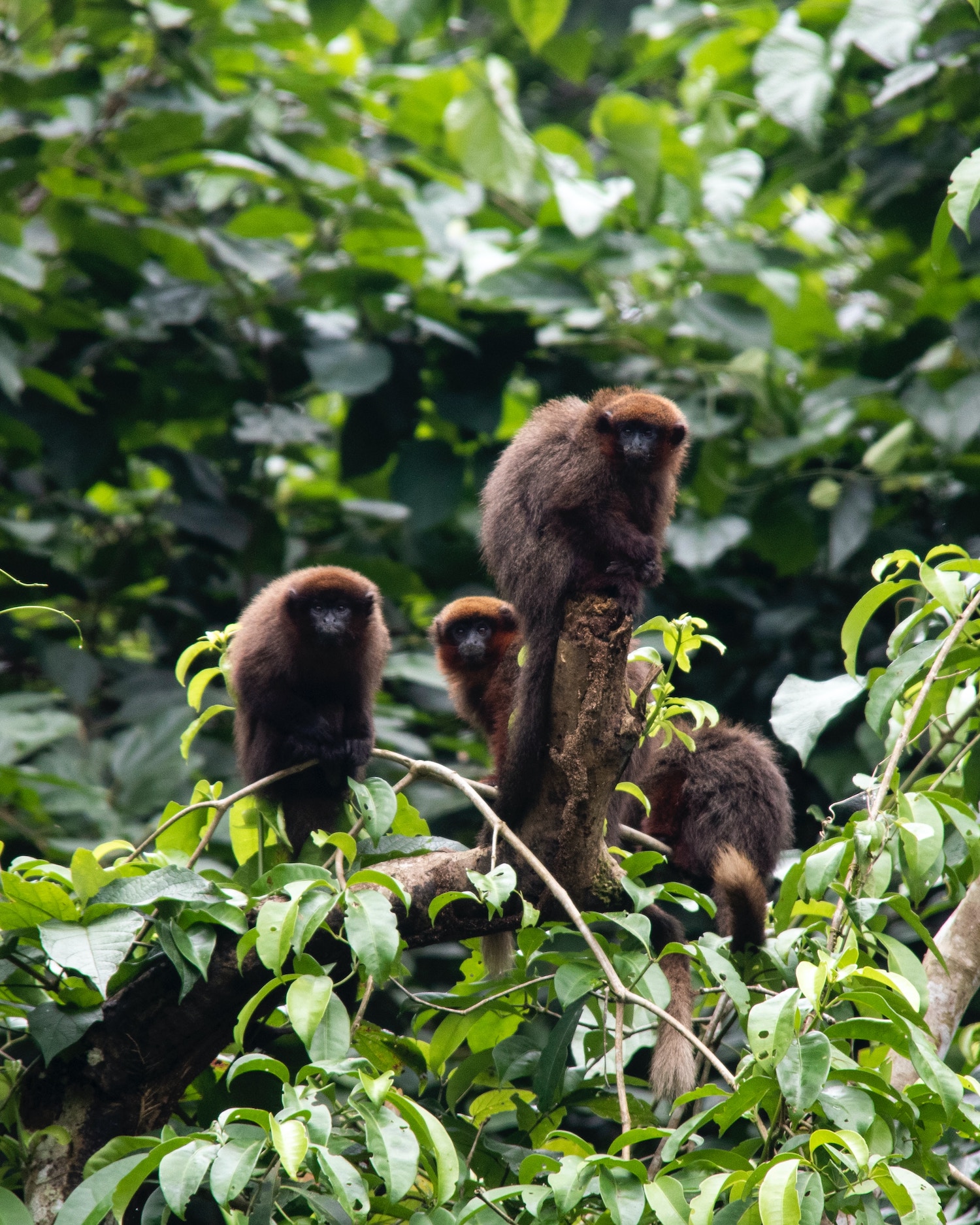
When Is the Best Time to Visit the Amazon?
The Peruvian Amazon is a captivating destination that offers a unique experience year-round, but choosing the best time to visit can enhance your adventure. The region has two distinct seasons: the dry season from May to October and the rainy season from November to April. While both seasons showcase the breathtaking beauty of the Amazon, each offers a slightly different experience.
During the dry season, from May to October, the weather is relatively stable, with lower chances of rain, making it an ideal time for hiking and exploring the jungle trails. On the other hand, the rainy season, from November to April, transforms the landscape into a lush, vibrant haven. Although rainforest excursions may be more challenging, this season presents an opportunity to witness the Amazon in its full splendor, with swollen rivers and a burst of greenery.
Wildlife enthusiasts may find the rainy season particularly rewarding, as the increased water levels facilitate boat excursions, offering a unique perspective on the flourishing ecosystem. Ultimately, the best time to visit depends on your preferences and the type of experience you seek, whether it be the dry season’s accessibility or the rainy season’s lush, vibrant ambiance.
Wildlife in the Peruvian Amazon
Delve into the mesmerizing world of the Peruvian Amazon’s wildlife. With nearly 1900 bird species and 500 mammal species, the region unfolds as a paradise for nature enthusiasts. From pink dolphins to elusive jaguars, our narrative paints a vivid picture of the Amazon’s diverse inhabitants.
As you traverse this ecological marvel, be prepared to encounter a rich tapestry of wildlife that calls this region home. Here’s a glimpse into the diverse fauna that awaits you:
- Birds: With almost 1900 bird species, the Amazon is a paradise for bird watchers. Look out for vibrant macaws, toucans, hoatzins, and the iconic camungo.
- Mammals: From elusive jaguars and playful river otters to howler monkeys and capuchins, the Amazon shelters around 500 mammal species.
- Aquatic Life: The Amazon River teems with diverse aquatic life, including pink dolphins, piranhas, caimans, and the elusive black armor fish.
- Insects and Invertebrates: The rainforest floor is a microcosm of life, featuring an array of colorful butterflies, spiders, and insects, some with remarkable medicinal properties.
Each region of the Peruvian Amazon offers unique opportunities to witness specific wildlife:
- Manu National Park: Ideal for a deeper wildlife experience, Manu’s reserved zone provides opportunities to spot elusive species. Be explicit about your preferences when booking a tour.
- Iquitos & Pacaya Samiria National Reserve: Known for its biodiversity, especially during longer expeditions, this reserve near Iquitos offers encounters with diverse flora and fauna.
- Puerto Maldonado: The gateway to the Tambopata National Reserve, this region is famed for its diverse bird species, including toucans and parrots.
- Chachapoyas and Central Selva: Northern regions boast attractions like the Gocta Waterfall and diverse cloud forests. The Central Selva, well-connected from Lima, is excellent for birdwatching, including spotting rare species.
In essence, the Peruvian Amazon is a living, breathing spectacle of nature. The choice of your expedition destination can shape the array of wildlife encounters you’ll experience. Whether it’s the lush jungles of Manu, the aquatic wonders of Pacaya Samiria, or the diverse birdlife in Central Selva, each region unfolds a unique chapter in the captivating narrative of the Amazon’s wildlife.
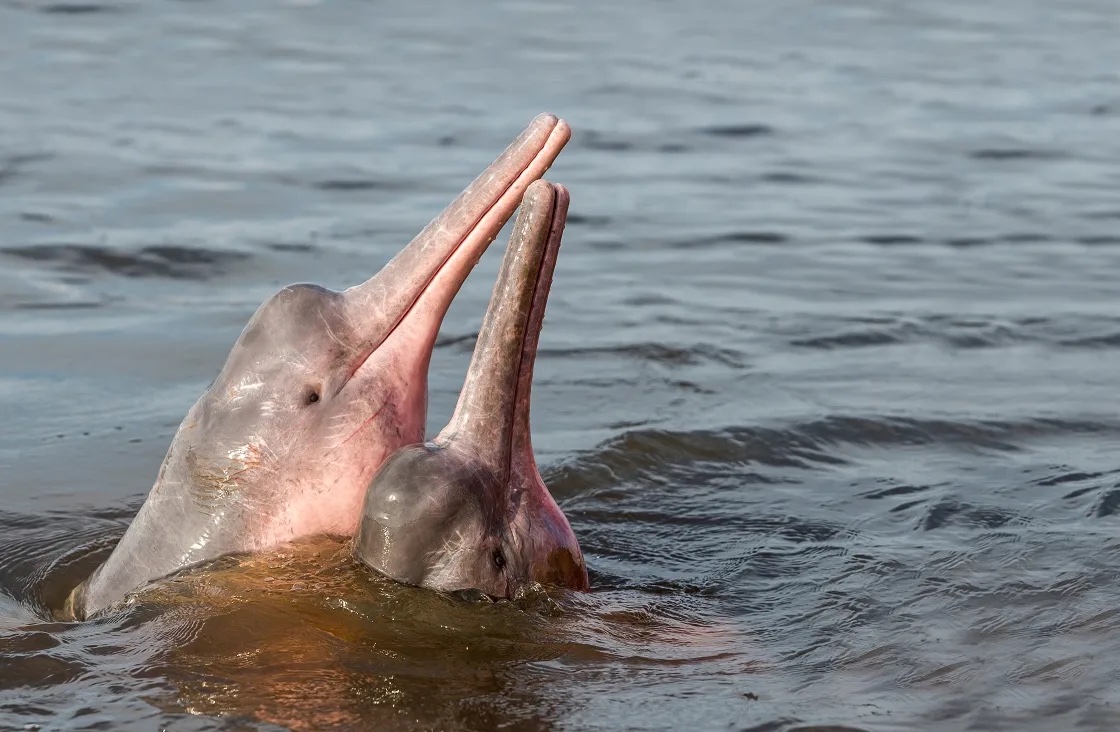
Activities to Do When Visiting the Amazon in Peru
Embarking on an adventure in the Peruvian Amazon is not just a journey. It’s an immersive experience into the heart of one of the world’s most diverse ecosystems. As you delve into this lush paradise, a myriad of activities awaits, promising encounters with unique wildlife and a deep connection with the rainforest. Here are some must-try activities to make your Amazon expedition truly unforgettable:
Jungle Walks
Explore the heart of the Amazon on foot with guided jungle walks. Traverse well-maintained trails or venture into more challenging terrains. You will experiencing the tranquility of the rainforest while keeping an eye out for diverse flora and fauna. The deeper you go, the more enchanting the wildlife encounters become.
Night Canoeing
Embark on a nocturnal adventure with night canoeing. As darkness envelops the river, navigate through the Amazon waters under the stars. The immersive experience allows you to connect with the environment in a unique way. You will be surrounded by the mysterious sounds of the jungle and the glittering night sky.
Indigenous Village Visits
Engage in cultural exchanges by visiting indigenous villages scattered throughout the Amazon. Accompanied by your guide, you can:
- Experience the authenticity of local communities
- Partake in traditional activities
- Gain insights into their way of life
The vibrant celebrations and warm hospitality make these visits truly memorable.
Fishing Excursions
Try your hand at fishing in the Amazon’s pristine waters. Whether you’re releasing fish back into the river or aiming for the catch of the day, fishing excursions provide a hands-on experience with the aquatic life of the Amazon. It’s a peaceful yet exciting way to connect with the natural rhythms of the river.
Wildlife Spotting
The Amazon is renowned for its diverse wildlife. Take part in wildlife spotting activities, especially during the early morning, late afternoon, or night. From rare bird species and playful monkeys to the iconic pink dolphins, each wildlife encounter adds a layer of fascination to your Amazon journey.
Nature Walks
Beyond the dense vegetation, pay attention to the unique plants and trees. Guided nature walks not only showcase the fascinating flora but also introduce the medicinal uses of various plants. Your guide’s stories about traditional remedies and the rainforest’s healing properties add depth to your nature exploration.
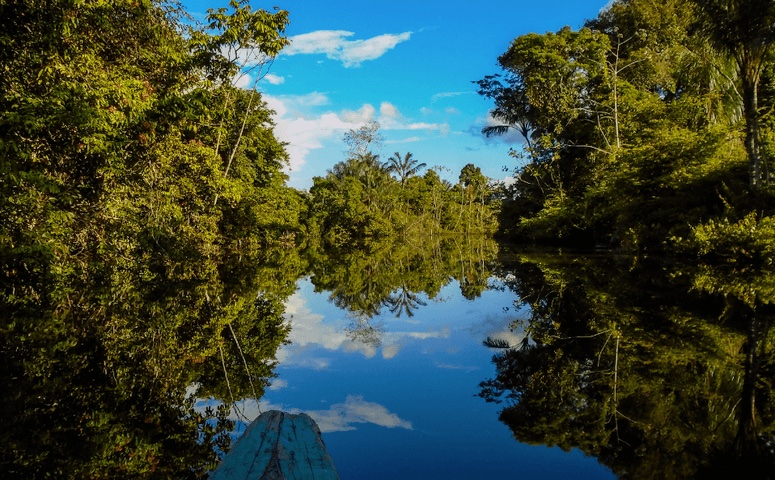
Packing Essentials When Visiting the Amazon in Peru
Equip yourself for the Amazonian challenges with our detailed packing list . Tailored to your chosen mode of exploration, whether lodge or tent, our comprehensive guide ensures you have the essentials for a comfortable and memorable journey.
Embarking on a journey to the Peruvian Amazon is an adventure unlike any other, but venturing into this lush and diverse ecosystem requires careful preparation. From protection against insects and the elements to staying hydrated and capturing unforgettable moments, here are 10 key essentials you simply can’t explore the Amazon without:
- Lightweight, quick-drying clothing : Long-sleeve shirts, lightweight pants, and shorts made of moisture-wicking materials. Light colours are preferable to deter mosquitoes.
- Jungle strength insect repellent : A strong insect repellent containing DEET or picaridin to protect against mosquitoes, sandflies, and other insects.
- Wide brimmed hat : A high-quality hat is essential to protect against the intense Amazonian sun. Pair with a high SPF sunscreen (preferably eco-friendly) and good pair of sunglasses !
- Sturdy outdoor hiking boots : Sturdy, waterproof hiking shoes or boots with good traction to navigate through muddy trails and protect against insect bites.
- Lightweight, breathable rain jacket : A lightweight, waterproof jacket and pants to stay dry during frequent rain showers in the Amazon rainforest.
- Binoculars : Quality binoculars to observe wildlife up close, as many animals in the Amazon are high in the canopy. It might seem like extra weight and space in your pack, but it’s worth it!
- Water purification tablets : A refillable water bottle and water purification tablets to ensure access to safe drinking water.
- Headlamp : A reliable flashlight or headlamp for nighttime jungle treks and power outages. Most lodges have unreliable electricity, often turned off in the evenings. You’ll be grateful to have a good headlamp!
- First aid kit : A basic first aid kit including bandages, antiseptic wipes, pain relievers, diarrhoea medication, and any prescription medications you may need.
- Waterproof pouch for your smartphone : Capture your Amazon adventure with a waterproof camera or a protective case for your smartphone or camera to guard against rain and humidity.
Embark on your Amazonian expedition with this comprehensive guide, where every paragraph unfolds a new chapter in your journey. Discover the Peruvian Amazon’s wonders, from the depths of Pacaya Samiria to the cultural richness of Chachapoyas, the vibrant cityscape of Iquitos, and let the adventure begin!
The Peruvian Amazon can be visited year-round, but understanding the distinct dry and rainy seasons aids in planning. The dry season from May to October offers different wildlife experiences compared to the rainy season from November to April.
The Peruvian Amazon boasts a rich tapestry of wildlife, including pink dolphins, various monkey species, jaguars, and a myriad of bird species. However, wildlife spotting is nature-dependent, and sightings are not guaranteed.
Planning your Amazonian adventure on a budget is feasible. Opt for local travel agencies, consider bus travel, and explore budget-friendly accommodations. Flexibility in your schedule allows for on-the-spot tour arrangements, often at lower costs.

Lucas is a travel writer with deep experience exploring South America. He enjoys hiking through mountain ranges, cycling across deserts and paddling down rivers.
Peruvian Amazon: How to Visit the Amazon from Iquitos, Peru
Best travel sim cards for international mobile data in 2024, get our best tips direct to your inbox.

Everything you need to know about visiting the Amazon
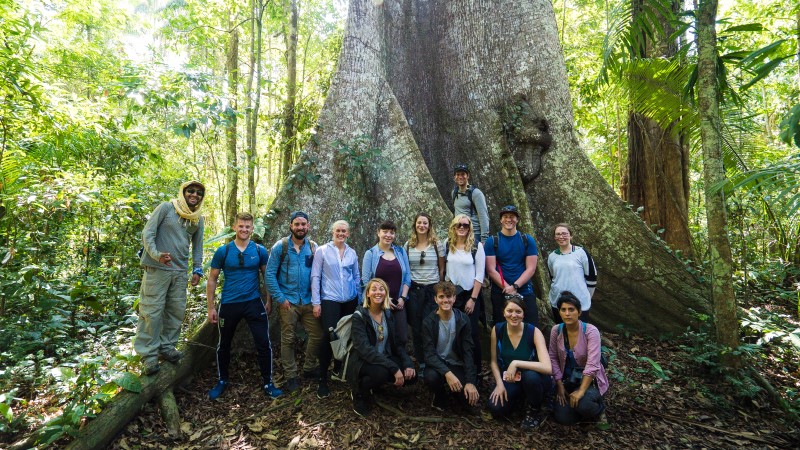
Spanning a mind-blowing 5.5 million square kilometres, the Amazon is the largest rain forest on the face of the Earth.
This untamed wilderness is home to as many as 40,000 species of plant, several thousand species of birds, over four hundred mammals and 2.5 million different insects.
That handful of numbers alone is probably enough to make you feel overwhelmed! To help ease your mind, I’ve compiled all the information you need so that you can start planning your Amazon trip today.
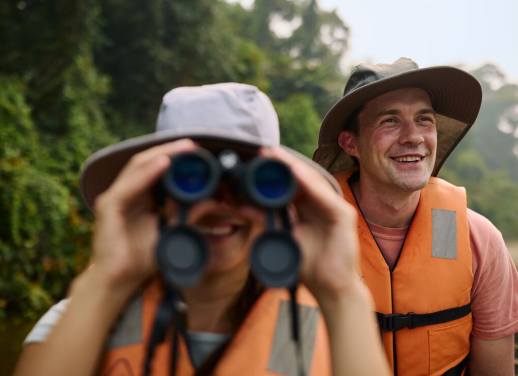
The best time to go
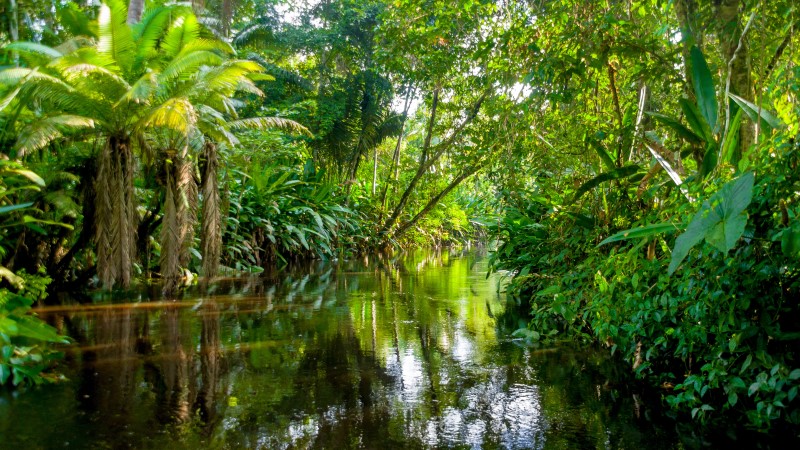
Fotos593/Shutterstock
In truth, the Amazon jungle can be explored all year round. Even in spite of its enormity, the weather conditions here don’t really vary between seasons – expect it to be warm, rainy and humid.
January to June marks the wet season, with temperatures sitting between 23 and 30ºC (that’s 73 to 86ºF). Throughout this half of the year, daily showers are common and can sometimes be heavy. Increased rainfall makes the rain forest feel cooler and the river levels higher. This makes accessing the river easier and swimming more plausible. It’s also worth mentioning that the greater humidity means there are more mosquitos about.
The second half of the year, July to December, marks the dry season. During this time temperatures average around 26 to 40ºC (or 78 to 104ºF) and although there’s less rain, heavy showers are still not unheard of. Decreased rainfall makes jungle feel drier and the river levels lower. This makes exploring on foot easier and offers a great opportunity to spot caimans as they compete for shorter food supplies.
SUBSCRIBE TO OUR NEWSLETTER FOR OUR LATEST NEWS, OFFERS AND COMPETITIONS
Getting there
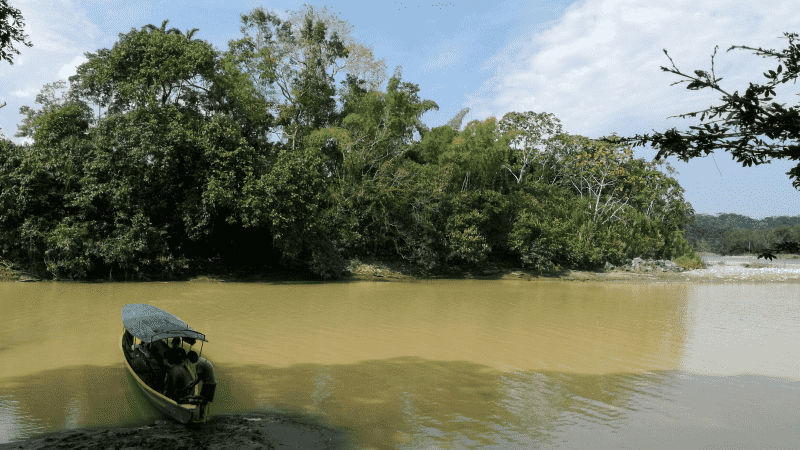
Photo captured by Eduardo Mora
The vast rainforest spans nine different South American countries including Peru , Colombia , Ecuador and Bolivia – although it’s most prominent in Brazil .
Planning to visit the Peruvian Amazon? Flights can be arranged into Iquitos, Puerto Maldonado from Cusco. Hoping to experience the Brazilian Amazon? Flying into Manaus in the north is your best option. If it’s the Ecuadorian Amazon you’re after, then you can take a bus from Quito into Tena City (five hours) where you can hop in a pickup truck. Or, if you’re eager to explore the Bolivian Amazon, fly from La Paz to Rurrenabaque (around 45 minutes) and then ride a motor-boat upriver to Madidi.
Joining a short, escorted, group tour is an easy way to escape the trouble of organisation!
Intrepid trips to the Amazon:
- 4-day Peru Amazon
- 4-day Ecuador Amazon Jungle
- 12-day Inca Trail & Amazon
What you can see
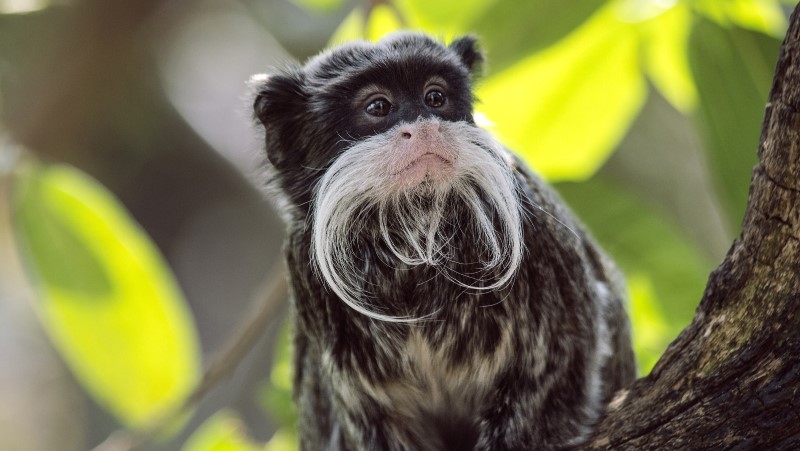
Will Howe/Shutterstock
The Amazon Rainforest houses 10% of the planet’s known species, so there’s plenty for wildlife enthusiasts to get excited about. Hiding high in the canopy you might spot slow-moving sloths and all manner of monkeys including howler, spider, tamarin, capuchin and squirrel – to name but a few. Bring along your binoculars too for a closer look at brightly-billed toucans and scarlet macaws.
Lurking on the rainforest floor and on the leaves of lower lying plants you might see sinister-looking snakes such as green anacondas, boa constrictors and eyelash vipers. Also, look out for tiny poisonous dart frogs and cleverly camouflaged insects like the leaf-mimic katydid and moss-mimic stick insect.
Living on the river banks you might find capybara families playing, caimans looking for their next meal and tapirs nibbling on low-hanging branches. Whilst in its murky waters, you may see pink river dolphins coming up for air and giant otters tucking into their fish suppers.
LOVE WILDLIFE? CHECK OUT INTREPID TRAVEL’S FULL RANGE OF ANIMAL-FILLED TOURS
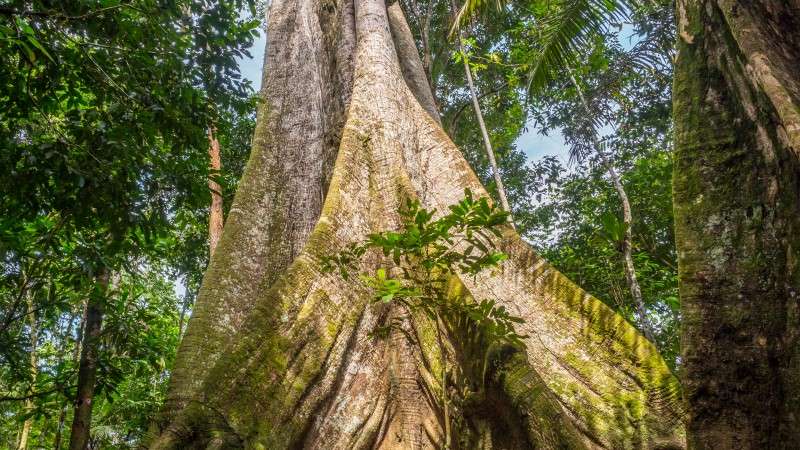
Nowaczyk/Shutterstock
If you’re more of a plant person, the Amazon offers up lots for green-fingered explorers too. Some of the most fascinating and unusual species include giant water lilies (or Victoria Amazonica), spaghetti passion flowers and monkey brush vines. It’s a brilliant destination for tree lovers too. You won’t be able to walk through the jungle without coming across the humungous roots of the kapok tree. These giants can reach over 60 metres in height!
And, for the foodies amongst us, you’ll also be able to spot the plants that some of our favourite foodstuffs come from including coffee, cacao and bananas.
Where you’ll stay
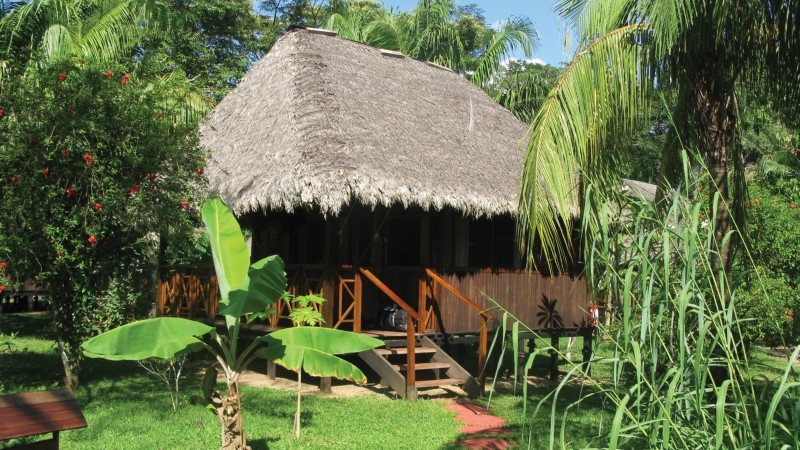
Photo captured by Barbara Glanz
The most prominent style of accommodation you’ll come across in the Amazon is jungle lodges, regardless of which section you’re visiting. And whilst you can get some incredibly luxury or extremely basic ones, most sit around the 3-star mark. In these lodges, you’ll usually stay in a comfortable twin share or double cabin with an ensuite bathroom. Rooms will be kitted out with mosquito nets and a fan to keep you cool and protected at night.
READ MORE: 5 AMAZON LODGE PHOTOS THAT WILL HAVE YOU PACKING YOUR BAGS IMMEDIATELY
Activities on offer
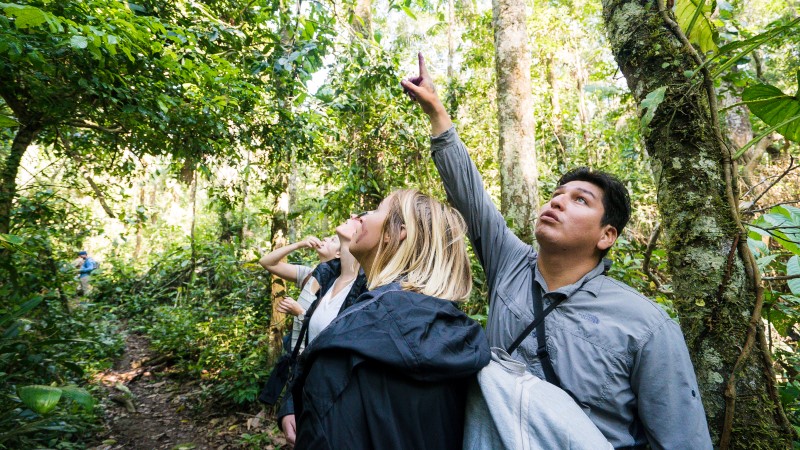
Photo captured by Stephen Parry
During your time in the Amazon, the days will be filled by jungle walks and river cruises. These will likely happen at varying times each day to give you an insight into how your surroundings can change. On some nights you’ll have the option to take part in an after-dark jungle walk, offering you the opportunity to spot some nocturnal animals. But if you’re not keen, no worries, you can choose to simply kick back in a hammock. Bear in mind that the day’s schedule can change depending on the weather. Other activities that are sometimes available include rafting, canoeing and swimming.
BOOK NOW: CHOOSE FROM 30+ INTREPID TRAVEL ITINERARIES FEATURING THE AMAZON
Packing essentials
Aside from lightweight, waterproof and moisture-wicking clothing, here are a few more items to pop on your packing list:
- A head torch for night walks through the jungle.
- A pair of binoculars so you can get a closer look at the amazing Amazonian animals.
- Mosquito spray regardless of whether you’re travelling in the wet or dry season.
- Sensible walking shoes, although rubber boots will be provided in most cases.
- A hat to protect your head from the sun when cruising down the river.
- High factor sun cream as you don’t want sunburn putting a downer on your experience.
- A camera as you’ll be presented with an abundance of photo opportunities.
READ MORE: 10 EASY WAYS TO BE A RESPONSIBLE TRAVELLER
5 tips for exploring the Amazon responsibly
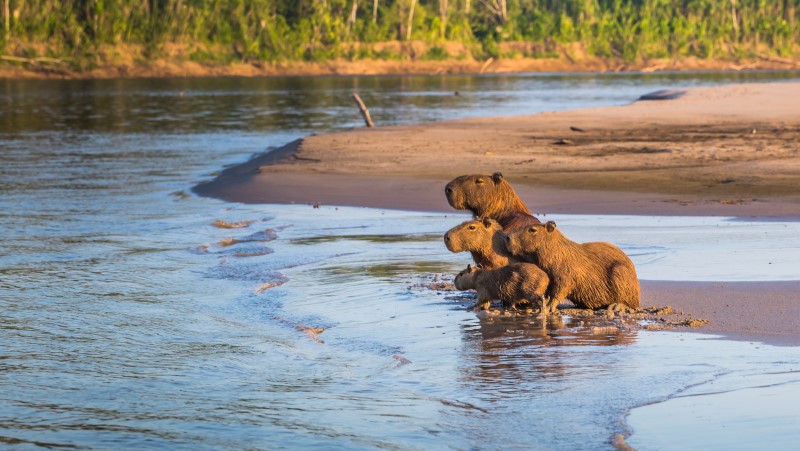
RPBaiao/Shutterstock
1. Adopt a ‘take in, take back out approach’ with your rubbish when exploring the jungle.
2. Keep a respectful distance from the local wildlife, particularly those species that are poisonous.
3. Choose a lodge that invests money back into the local community.
4. Carry a reusable water bottle so that you’re able to refill it from the larger water bottles at the lodge.
5. Listen to your guide and follow the routes they lay out for you.
LEARN MORE ABOUT RESPONSIBLE TRAVEL
What to do in the Amazon Rainforest?
- Enjoy a Junge walk through the world’s biggest Rainforest, the amazon rainforest, discovering the unique and vibrant wildlife, as well as the abundance of amazing plant species on offer.
- Kayak down the Amazon River, exploring the remote, hard to reach areas. Spot the amazing marine life as you navigate down the river and through the dense jungle.
- Get up high and amongst the 70% of the Amazon wildlife which live in the canopy. The Canopy bridge walk is a fantastic way to explore the jungle and must for your Amazon trip.
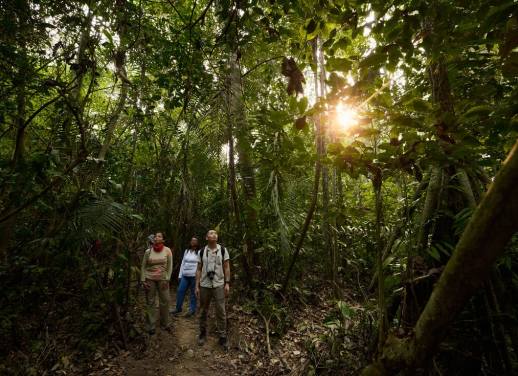
I'm a firm believer in the saying: "you'll always regret what you didn't do, not what you did". So, even after people told me I'd never get a job again if I left London to travel, I did it anyway. 29 countries later, and it will always be one of the best decisions I've ever made (corny maybe, but true). Life's short, the time to get out there and see the world is now!
You might also like
Best places to travel in march, best places to travel in may, best places to travel in february, best places to travel in april, best places to travel in june, how to secure your inca trail permit the..., best places to travel in july, best places to travel in january, best places to travel in november, best places to travel in october, best places to travel in september.

How to visit the Amazon rainforest in Brazil: A complete guide
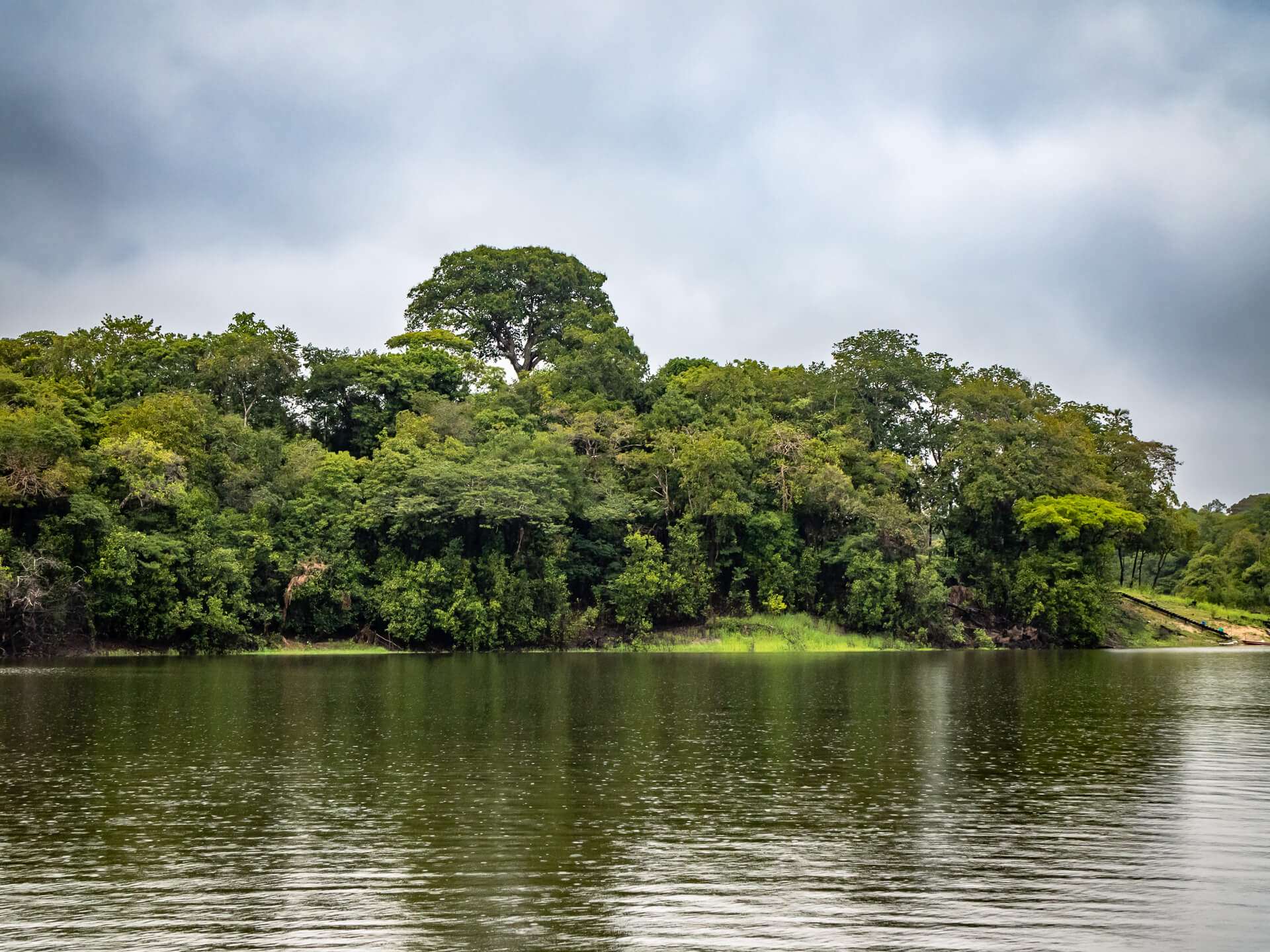
On my latest trip to Brazil, I had the opportunity to tick off a major bucket list item of mine – to visit the Amazon rainforest. It’s a destination that had fascinated me since I was a child, so it was a dream come true to finally see this mystical place with my own eyes.
Due to the immense size of the Amazon, planning a trip here can feel confusing and overwhelming. Therefore, I’ve put together this guide where I’m sharing my best travel tips on how to visit the Amazon rainforest in Brazil.
Covering an area of 6.7 million km2 (2.6 million sq mi), the Amazon spans 40% of South America and is by far the largest rainforest in the world. The Amazon basin is one of the most biodiverse places on the planet and is believed to be home to 10% of all known species.
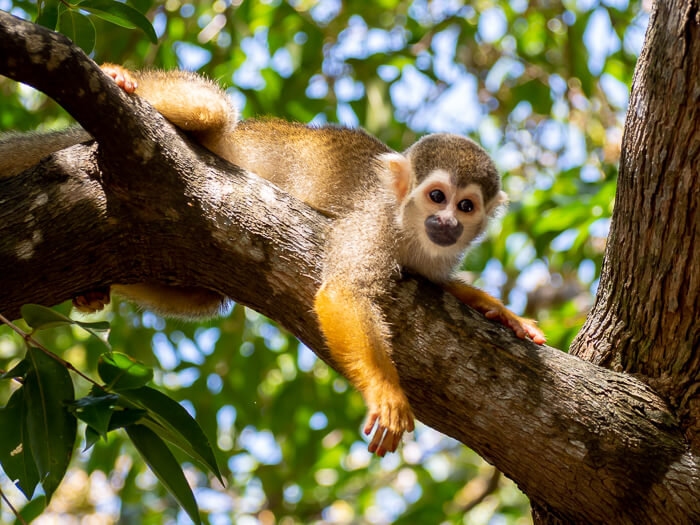
Known as the Lungs of the Earth, the Amazon tops the wishlist of many travelers from around the globe and is an ideal destination for those looking to connect with nature.
Whether you want to explore the depths of Brazil’s jungles, lock eyes with wild animals, taste wonderful exotic fruits, relax on unspoiled beaches or cruise down the Amazon River – you will make memories that will last a lifetime! And this Amazon rainforest travel guide will show you exactly how to do that.
Without further ado, let’s dive into all the things you need to know for planning a trip to the Amazon rainforest in Brazil.
Disclosure: This article contains affiliate links from which I may make a commission at no additional cost to you if you make a purchase.
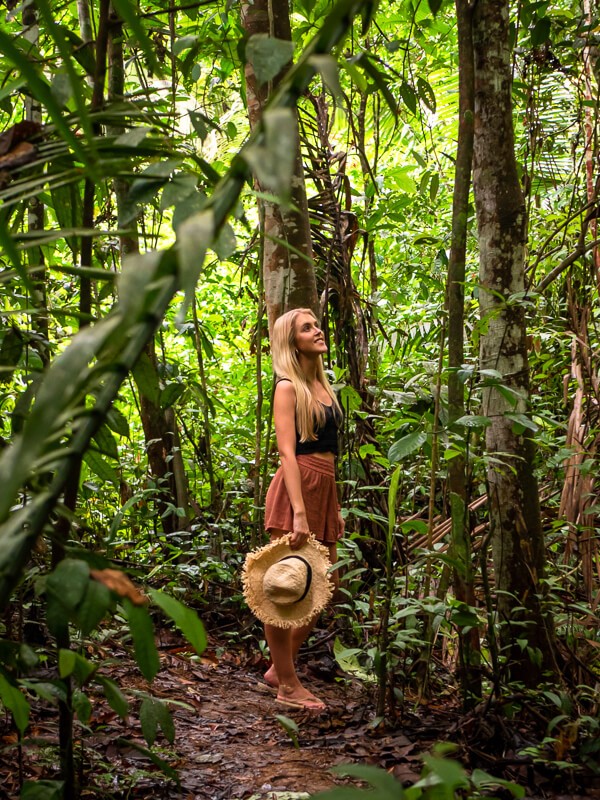
How to get to the Amazon rainforest in Brazil?
The best way to get to the Amazon rainforest in Brazil is to fly to Eduardo Gomes International Airport in the city of Manaus. Known as the gateway to the Brazilian Amazon, Manaus is the main tourist hub in the region and the capital of the Amazonas state.
You can take a direct flight from Sao Paulo to Amazon rainforest (Manaus), which takes about four hours. There are also direct flights to Manaus from other major cities in Brazil, such as Rio de Janeiro and Brasilia, as well as from Miami, Panama City and Bogota.
Alternatively, you could also fly to Santarem, which is a smaller town about 600km (370 mi) east of Manaus.
We started our Amazon trip by flying to Manaus and finished it by flying out of Santarem. To get from Manaus to Santarem, we took a ferry down the Amazon River. I’m explaining more about why we did this further below.
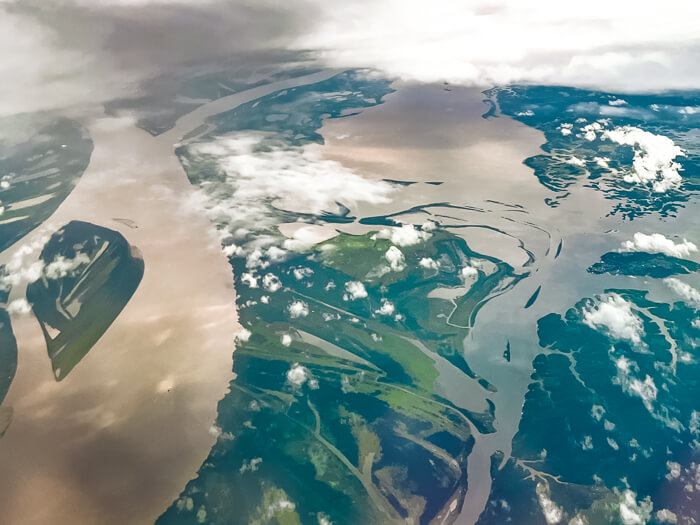
How many days do you need?
I would say three days is the minimum amount of time that you should set aside for visiting the Amazon rainforest in Brazil. In three days, you can do a handful of excursions, which will give you a glimpse of what this enchanting region has to offer. However, you’d only be skimming the surface.
I highly recommend spending a week or even 10 days exploring the Amazon rainforest if you can. This way, you’ll have enough time to visit several different areas of the Amazon region and enjoy a wider variety of experiences – from exploring jungles and rivers to relaxing on beaches and visiting waterfalls.
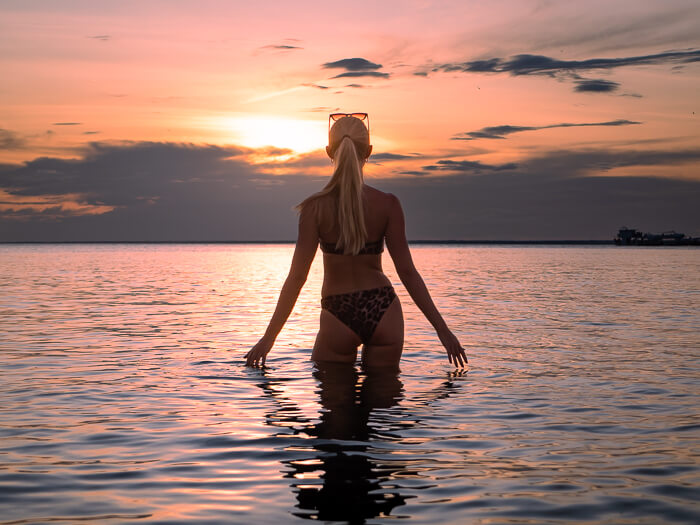
It’s also a good idea to have a few extra days as a buffer in your Amazon rainforest itinerary in case the weather turns out to be bad and prevents you from doing some of the activities you had planned (happened to us on a few occasions). In total, we spent 9 days in the Amazon but I wish we had a few more days.
If you’re interested in seeing more of Brazil (which I hope you are since there are countless amazing places to explore!), check out my post on 3 Brazil itinerary options to find inspiration for planning out the rest of your trip.
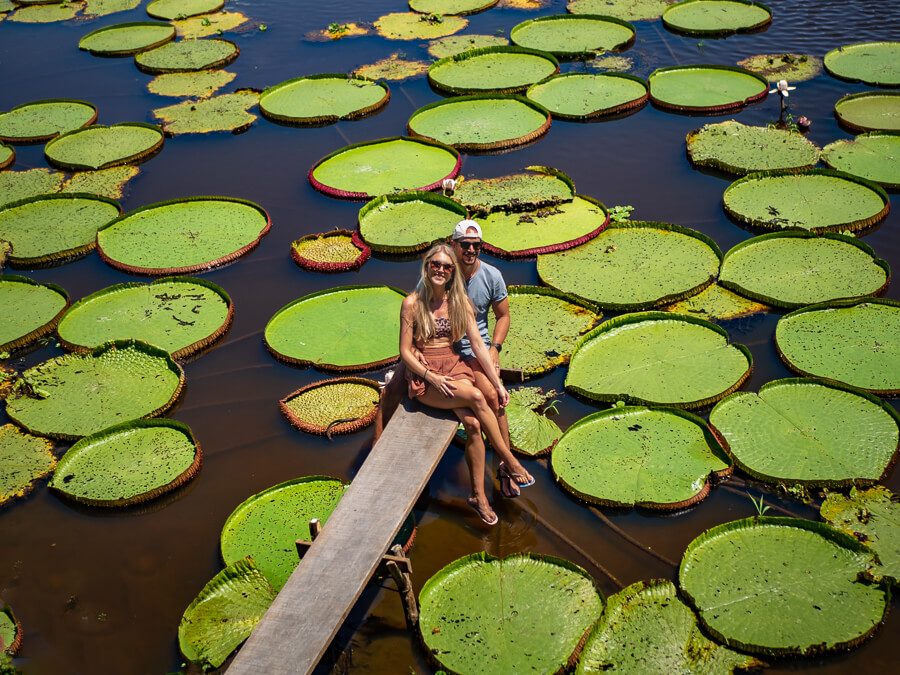
Best time to visit the Amazon rainforest in Brazil
There are two distinct seasons in the Amazon – the dry season and the rainy season. They are also known as the low water season and the flood season. Don’t let the word ‘dry’ fool you though. Remember that it’s still a tropical rainforest so you should expect to see some rain every day regardless of when you visit.
There’s no clear ‘best’ time to visit the Amazon rainforest in Brazil since there are pros and cons to both seasons. The rainy season typically runs from January to July and the dry season from August to December. The temperature remains hot throughout the year (around 27-30°C or 80-86°F).
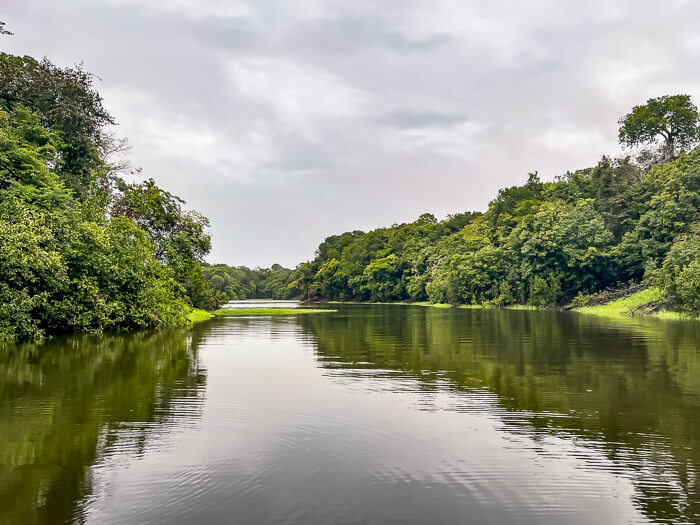
The advantages of visiting during the dry season are less rain, fewer mosquitoes, better access to the river beaches and better trekking options since the jungle won’t be flooded.
The main advantage of visiting during the rainy season is that you’ll have better opportunities for boat/canoe tours. Higher water levels make it possible to access smaller canals and get deeper into the flooded forests, which are locally known as igapó .
Be aware though that once the rainy season has kicked in and the water levels have risen (February-July), you won’t be able to enjoy the white sand beaches along the river banks, as they will be fully flooded.
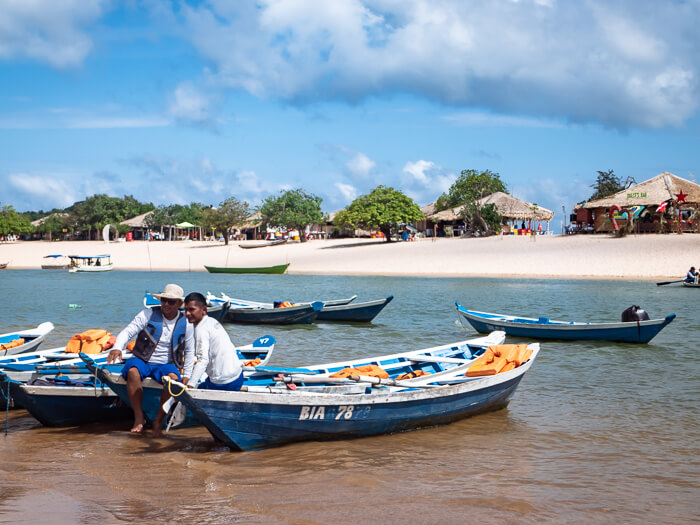
In some parts of the Amazon, the water level in the rivers rises by a whopping 12 meters (40 ft) by the peak of the rainy season. I find this absolutely mind-blowing!
We visited the Amazon from the end of December until the beginning of January, which is a transitional period from the dry to the rainy season. We experienced a lot of rain in the Manaus area but only a little rain in the Santarem-Alter do Chão area. This shows that the weather in the Amazon can be quite unpredictable.
How to visit the Amazon rainforest in Brazil?
One of the best ways to visit the Amazon rainforest in Brazil is to stay at a jungle lodge in the region around Manaus. The majority of the lodges are within a 2-3 hour drive or boat ride from Manaus and usually offer all-inclusive packages that include transfers from Manaus, all meals and several excursions on each day.
During the excursions, you’ll be accompanied by local guides who take you on jungle walks and boat tours and share their knowledge of the flora and fauna of the Amazon.
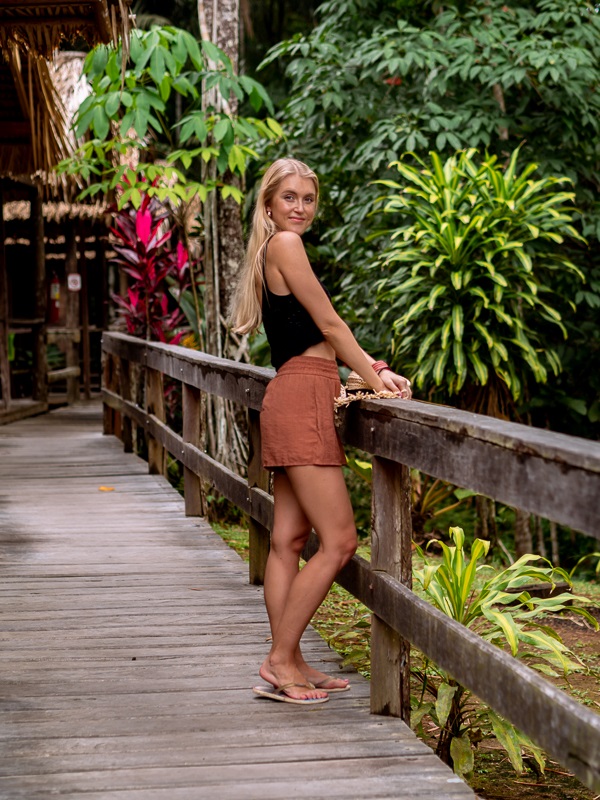
As an alternative to a lodge, you could take an Amazon cruise where you’d stay on a liveaboard riverboat and go on daily rainforest tours. You could also base yourself in Manaus and take day trips, which is probably the cheapest option.
Besides staying at an Amazon jungle lodge or taking a river cruise, I also recommend visiting Alter do Chão for a totally different experience. This small town has a laid-back bohemian atmosphere and is known as the Caribbean of the Amazon thanks to its fabulous white sand river beaches. Be sure to read my Alter do Chão travel guide for more tips on what to expect when visiting this cool little town.
To get to Alter do Chão from Manaus, you’d need to either fly or take a ferry down the Amazon river to Santarem. We chose the latter option. From Santarem, it’s just a 35km (22 mi) drive to Alter do Chão.
To give you an idea of how to plan your Amazon rainforest trip and how many days to allocate to each place, here’s an outline of our Amazon itinerary:
- Day 1-3: Flying to Manaus and staying at a jungle lodge
- Day 4-5: Taking a ferry from Manaus to Santarem
- Day 6-8: Exploring Alter do Chão
- Day 9: Flying out of Santarem
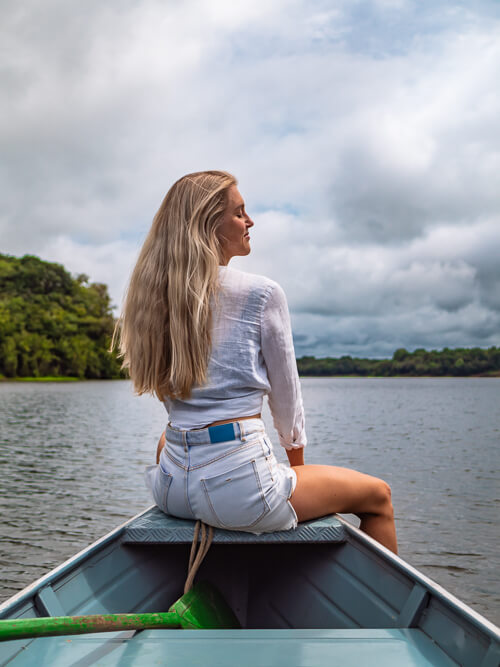
Amazon rainforest lodges in Brazil
There are numerous jungle lodges to choose from around Manaus, ranging from more affordable ones with very basic amenities to more stylish lodges with comfortable bungalows.
Here are my top picks for Amazon rainforest lodges for varying budgets:
BUDGET: Amazônia Exxperience One of the cheaper Amazon lodges. The rooms are rustic and very simple but apparently, the excursions and the food are wonderful!
MID-RANGE: Dolphin Lodge This is the lodge where we stayed for two nights and I think it’s one of the best mid-range options you can find. It’s a small rustic family-owned lodge in a tranquil location overlooking a river and surrounded by the rainforest. We stayed in a private bungalow perched on stilts high above the forest floor and took daily tours with our knowledgeable guides to explore the surrounding jungle, lakes and rivers.
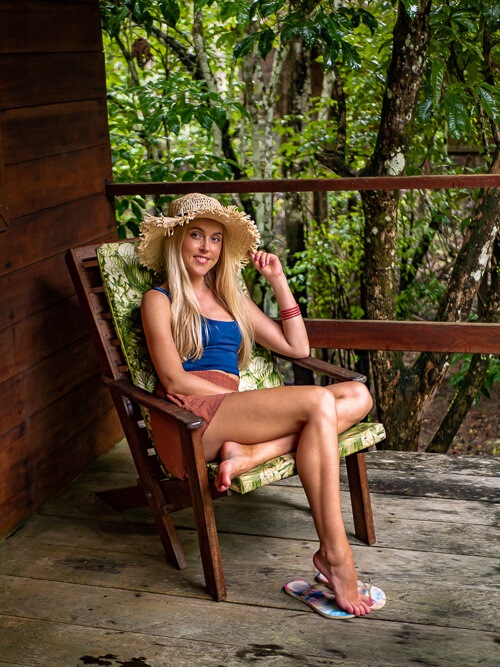
LUXURY: Juma Lodge If you’re looking for a little more comfort, Juma Lodge is the place for you. It is one of the most famous lodges in the area and has a swimming pool and spacious bungalows with hot water showers.
Which vaccines are needed for a trip to the Amazon?
You are not required to have any vaccinations to visit the Brazilian Amazon. However, vaccinations against hepatitis A, typhoid and yellow fever are recommended.
Some people also choose to take pills against malaria, a disease transmitted by mosquitoes. Alternatively, you could do your best to protect yourself from mosquito bites by wearing long sleeves and trousers when in the jungle, using a mosquito repellent and sleeping under a mosquito net.
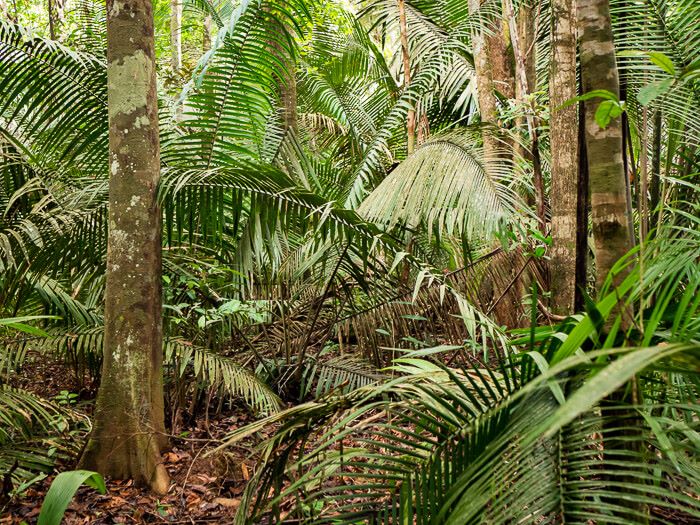
Which animals can you expect to see?
The Amazon jungle is home to countless species of wild animals that inhabit its rivers, treetops and forest floor. It’s one of the most biodiverse places in the world after all!
With that said, many of the animals are extremely well camouflaged or hiding deep in the jungle, far from the curious eyes of tourists. Therefore, you definitely shouldn’t expect to see jaguars, anacondas and tapirs around every corner.
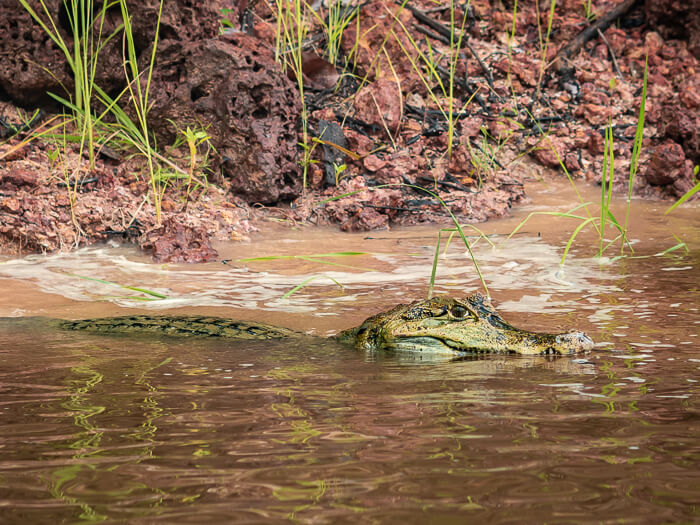
The most commonly seen animals in the Amazon rainforest are monkeys (howler monkeys and squirrel monkeys), caimans, freshwater dolphins (pink and grey ones), sloths, frogs, tarantulas, piranhas, and birds such as herons, macaws and toucans. During our 9 days in the Amazon, we saw all of these animals, though some of them were either very far or revealed themselves only for a brief second.
Seeing this adorable sloth (pictured below) from such a close distance was definitely one of the highlights of my Amazon trip in Brazil:
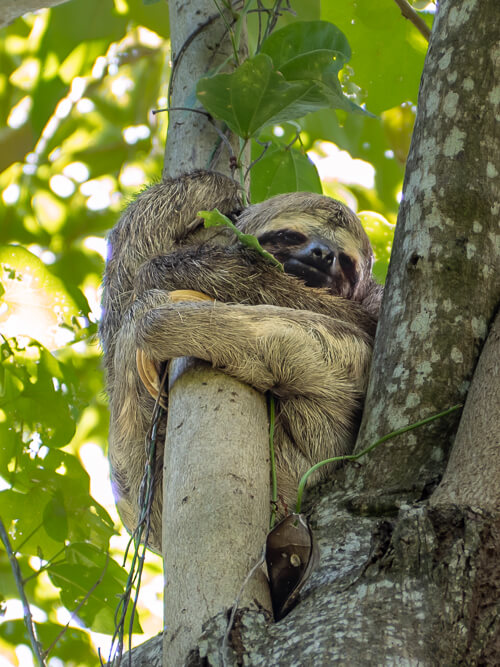
In terms of wildlife spotting, I’d say I’ve had a better experience in Costa Rica , the Galapagos Islands and Bonito (in Brazil) than in the Amazon. But the number of animals you see and how close you see them often comes down to luck! Nevertheless, I think the Amazon is a fantastic place to explore and still offers great chances of seeing wildlife.
A problem with wildlife tourism in the Amazon
While exploring the Amazon region, it became clear to me that unfortunately unethical wildlife tourism is extremely widespread there. The vast majority of the Amazon rainforest tours on offer include direct interactions with wildlife, which is problematic.
These are activities like petting and swimming with pink river dolphins, hugging sloths and monkeys, taking photos with a baby caiman in your hands, feeding wild animals and so forth. This article by National Graphic explains pretty well why such interactions are harmful to wildlife. Wild animals should stay wild and we shouldn’t treat them as our pets or photo props.
Sustainable and responsible ecotourism in the Amazon still has a long way to go. Therefore, I encourage you to choose your tour operators and lodges wisely.
I was happy to see that the tours we did with Dolphin Lodge didn’t involve any direct contact with wild animals.
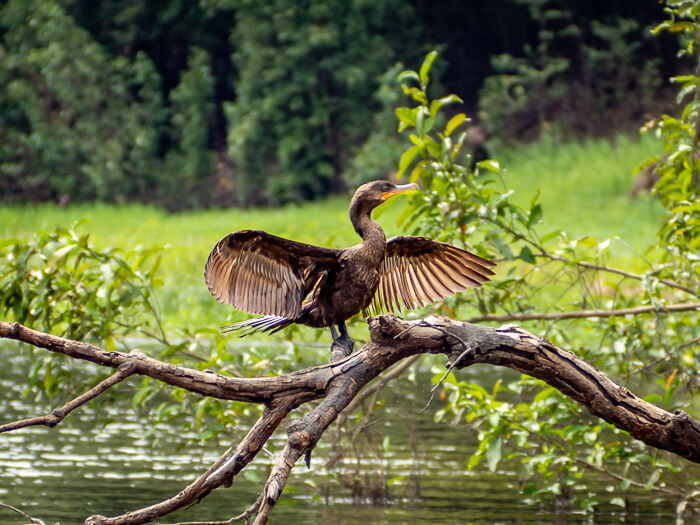
Best things to do in the Amazon rainforest
Thanks to its unique geography and fascinating flora and fauna, there’s no shortage of amazing places to visit and things to do in the Amazon rainforest. Here are some of the best ways to get to know this region and its wonders.
Jungle walk: Go on a trek in the rainforest with expert naturalist guides who will show you and educate you about a variety of exotic plants and wildlife. This was one of my favorite activities in the Amazon.
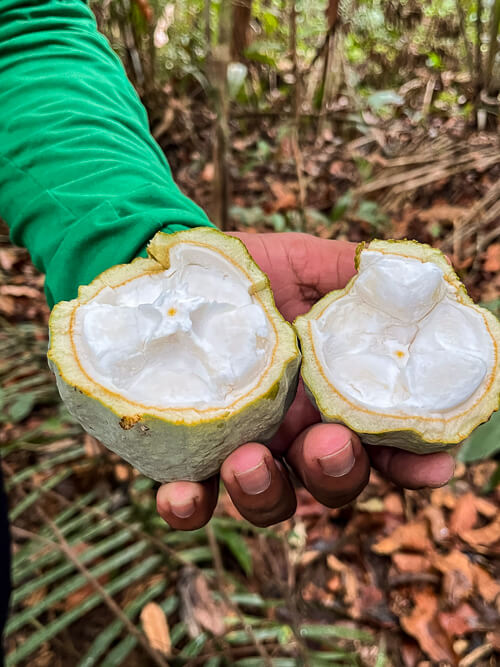
Canoe or boat tour: Take a tour on the calm waters of small rivers and lakes, where you’re likely to spot caimans, river dolphins and numerous birds. There are also piranha fishing tours and nighttime boat tours for spotting nocturnal animals.
Giant Amazon water lilies: Locally known as Vitoria Regia, these aquatic plants are the icon of the Amazon and can be found in ponds and lakes. They’re famous for their enormous leaves, which can reach up to 3 meters in diameter and can apparently hold the weight of a child or a small adult!
The beaches of Alter do Chão: Relax on beautiful sandy beaches along the Tapajós River, in an area nicknamed the Caribbean of the Amazon. Unlike the brown and murky Amazon River, the Tapajós boasts clear blue waters perfect for swimming.
Ferry on the Amazon River: Hop on an authentic ‘no-frills’ ferry used by the locals and sail 740km (460 mi) down the Amazon River to reach Santarem. You won’t see much wildlife on this journey since it’s a transportation ferry but it’s a unique experience nevertheless. Watching the sunset on the Amazon River is something I’ll never forget.
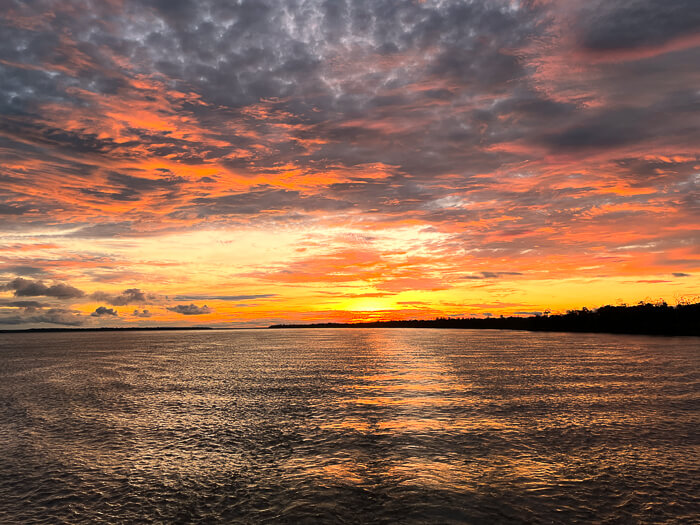
Survival tour: On a survival tour in the jungle, you’ll learn about medicinal plants, fishing techniques, how to build camps, make fire etc. There are one-day tours (such as this one ) as well as multi-day tours where you’ll camp in the rainforest.
Waterfalls at Presidente Figueiredo: This area is known for its waterfalls, caves and natural pools surrounded by gorgeous lush jungle. You can visit it on a day tour from Manaus . I would have really loved to explore this area but unfortunately couldn’t fit it into my Amazon itinerary.
Meet a local community: Take a tour to an indigenous community to learn about their way of living, their customs and agricultural practices.
Meeting of the waters: A unique phenomenon where the black waters of Rio Negro and the light brown waters of the Solimões River meet and run side by side for several kilometers before mixing.
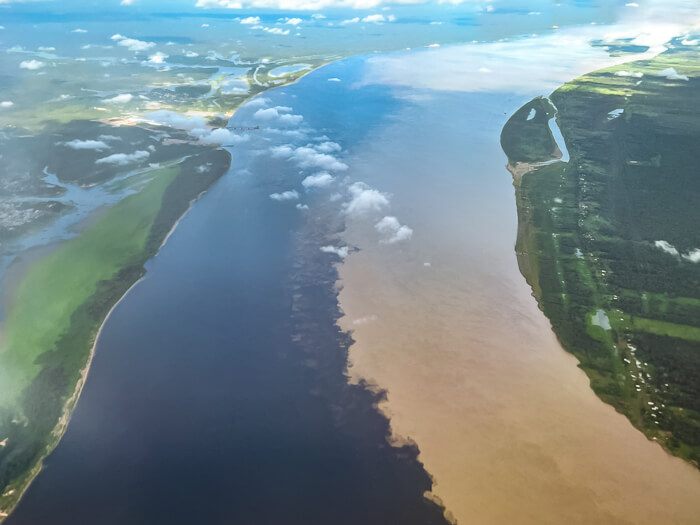
Map with the main points of interest
On the map below, I’ve marked the main points of interest that I mentioned in this Amazon rainforest travel guide as well as the lodges I recommended. Click on the icon in the top left corner of the map for more details.
Is it safe to visit the Brazilian Amazon?
Yes, the Brazilian Amazon is safe to visit. I can say that I felt totally safe throughout our entire Amazon trip. However, there are still some risks and dangers that you should be aware of.
Your biggest threat is mosquitoes that might carry malaria or yellow fever, which are both serious diseases. Always take precautions to protect your skin from mosquito bites.
Another common risk is getting an upset stomach due to the different kinds of bacteria in local food and water, which foreigners’ stomachs are not used to. To reduce your chances of getting sick, avoid drinking tap water during your Amazon trip in Brazil.
Also, it goes without saying that you shouldn’t wander into the depths of the jungle on your own when visiting the Amazon in Brazil. Always go with an official guide. Without one, it’s easy for tourists to get lost or wander into unsafe territories.
In terms of wildlife, there definitely are some dangerous animals in the Amazon but it’s unlikely that they’d attack you unless you provoke them or get too close. To avoid potentially dangerous encounters with animals, do your jungle hikes and river explorations with a guide.
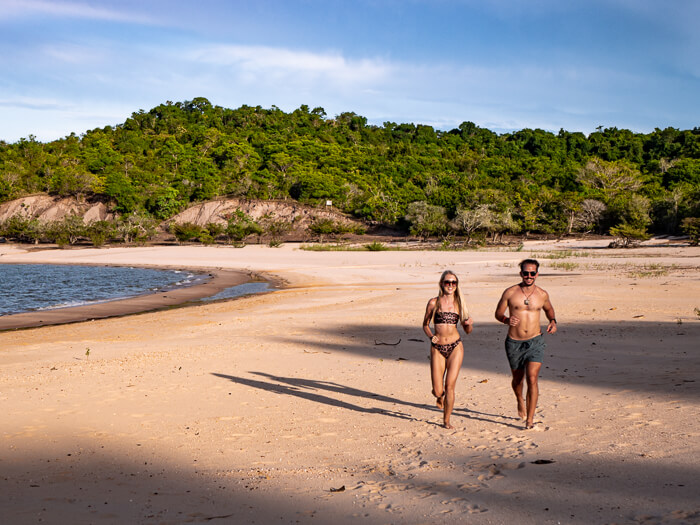
What to wear in the Amazon rainforest?
Since it’s going to be hot and humid, shorts, T-shirts, flip-flops, a swimsuit and a hat to protect yourself from the sun are a must. It’s also going to rain so it’s a good idea to bring a rain jacket.
Trousers and long sleeves are necessary when going on jungle walks in order to protect yourself from mosquitoes and sharp plants. Also, it’s apparently better to dress in light, neutral colors to avoid mosquitoes.
Remember to also bring sneakers or hiking boots. Alternatively, your lodge might provide you with rubber boots if you’re going to walk in particularly muddy areas.
I wore long leggings, a linen shirt and sneakers during our hike in the jungle and I think it was a great choice – I wasn’t feeling too warm and I didn’t get any mosquito bites.
In terms of fabrics, aim for light and breathable ones because it’s almost impossible to dry your clothes in the humid rainforest.
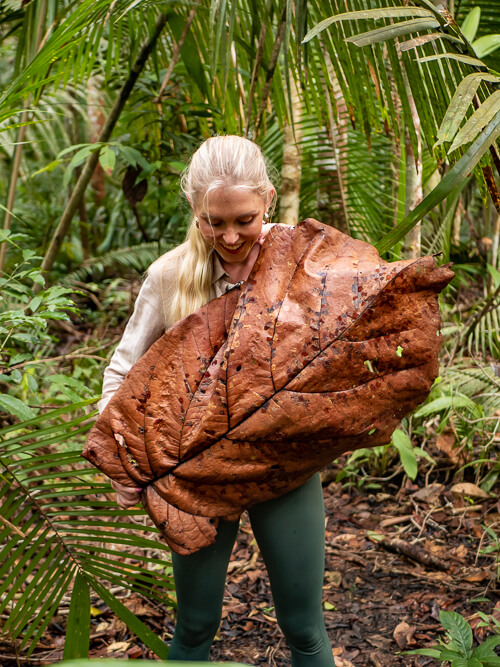
Final thoughts on visiting the Amazon rainforest in Brazil
And there you have it! These were my recommendations on how to visit the Amazon rainforest in Brazil. I hope this travel guide inspired you to explore this fantastic one-of-a-kind region and that you will find it useful for planning your own perfect trip!
If you have any questions about traveling to the Amazon rainforest, drop them in the comments and I’ll do my best to answer them.
For more photos and videos of my Amazon trip in Brazil, check out my Instagram account (look for the highlight called Amazonas).
Be sure to also check out my other Brazil travel guides for more tips on spectacular ecotourism destinations, gorgeous beaches and fun cities to visit:
- 10-day Brazil itinerary – 3 different options
- Visiting Alter do Chão, a hidden gem in the Amazon
- Visiting Iguazu Falls, one of the 7 Wonders of the World
- Best things to do in São Paulo
- Fun things to do in Rio de Janeiro
- Hiking in Brazil: Chapada Diamantina
Disclosure: I was invited to stay at Dolphin Lodge but as always, all opinions are my own.
Enjoyed reading this Amazon rainforest travel guide? Pin it!
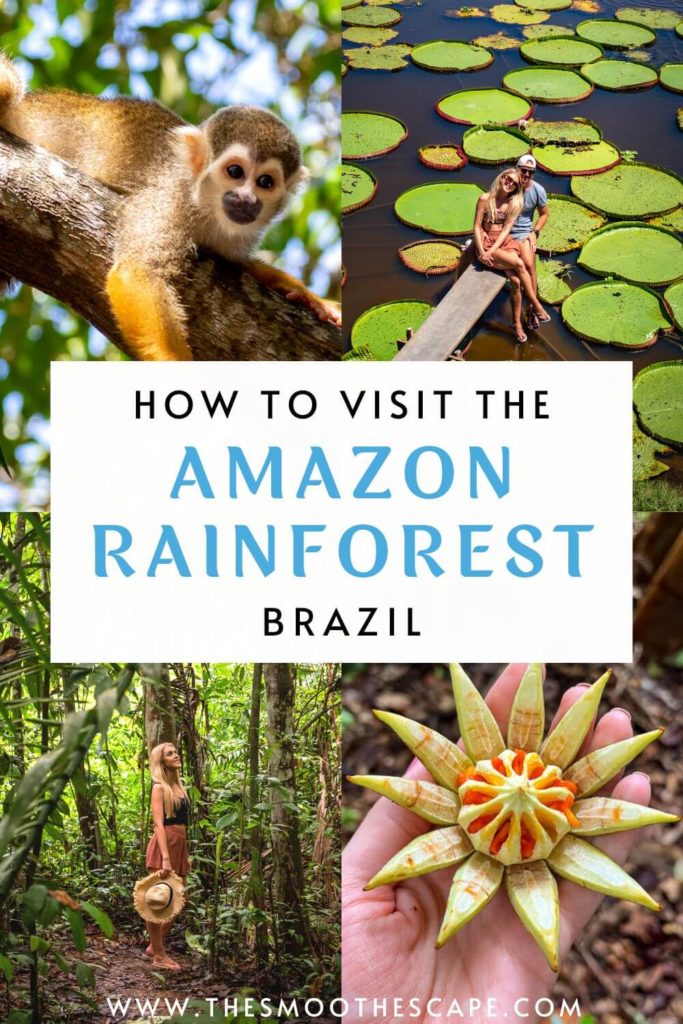
Visiting Alter do Chão, Brazil: A hidden gem in the Amazon region
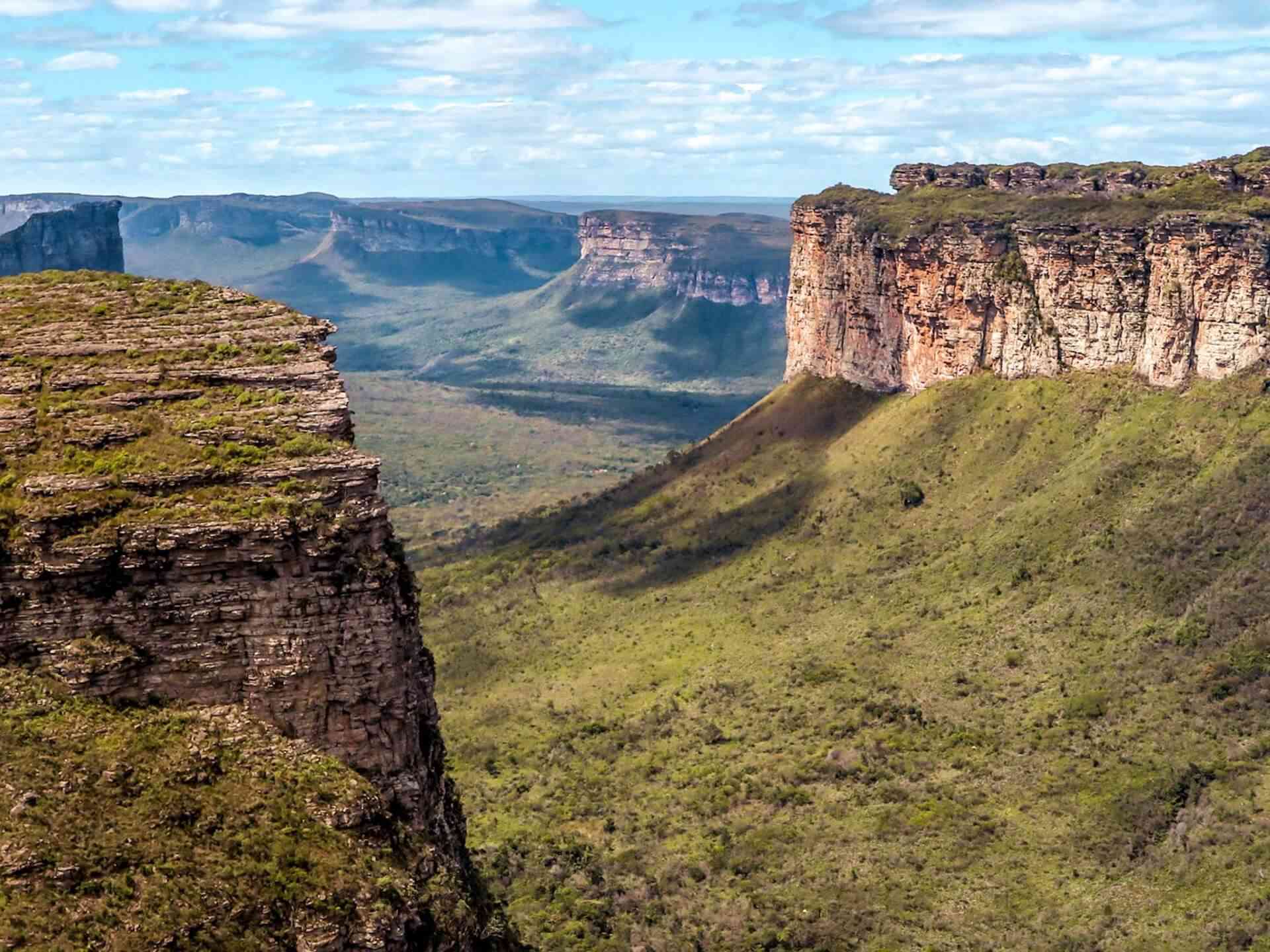
Things to do in Chapada Diamantina besides hiking

How to visit Iguazu Falls in Brazil: Everything you need to know
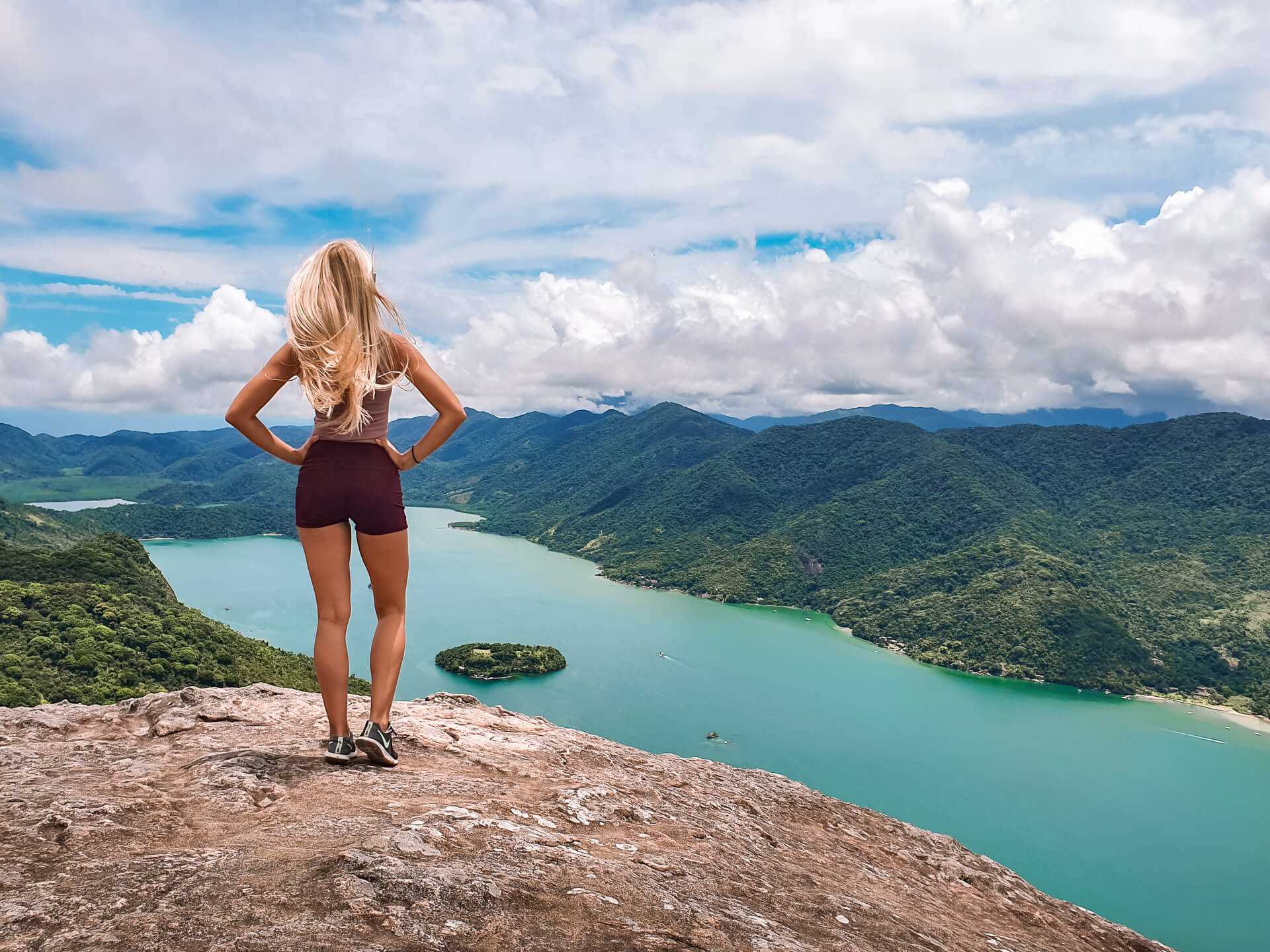
How to spend 10 days in Brazil – 3 epic itineraries
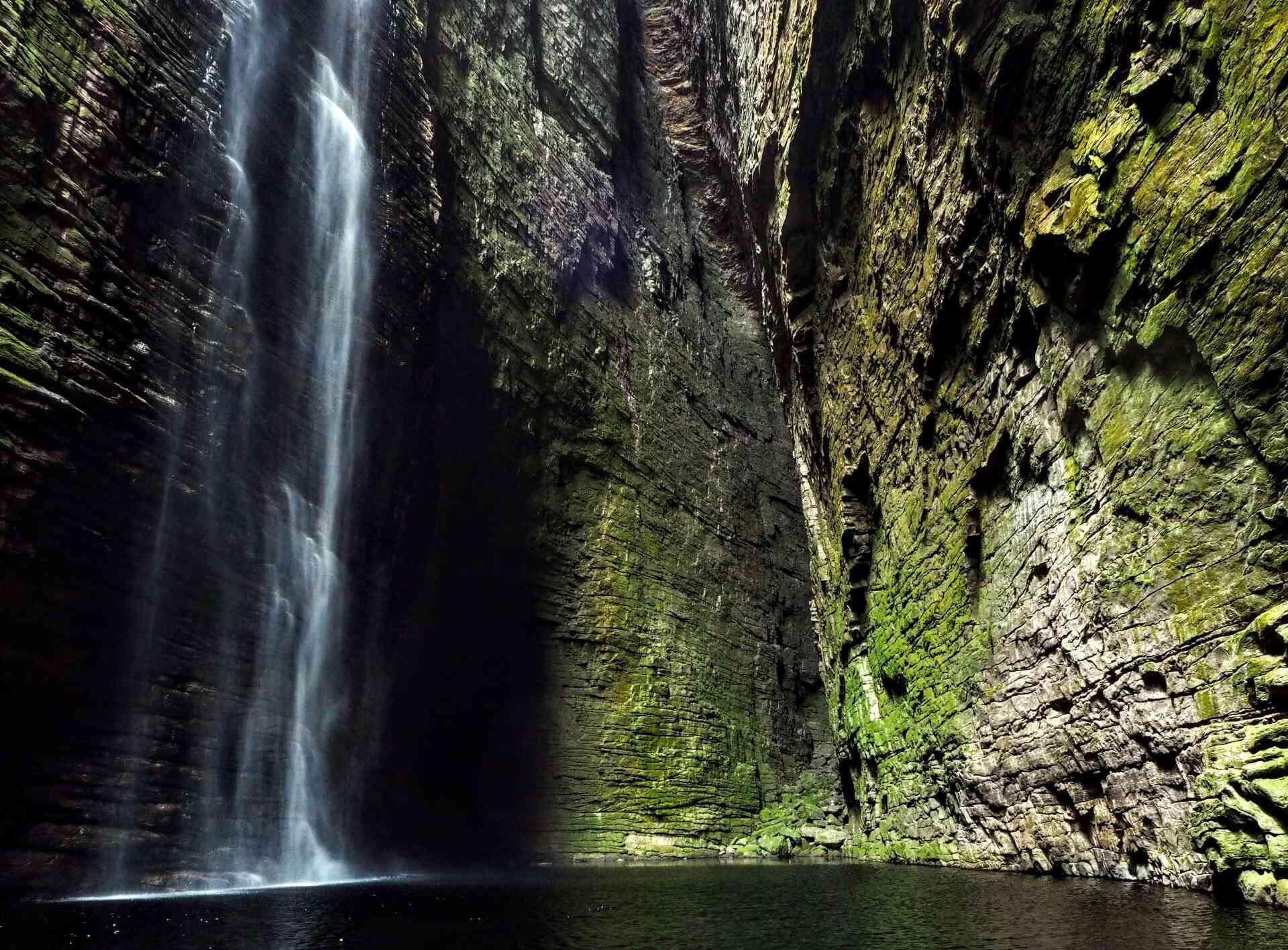
Hiking in Brazil: getting off the beaten path in Chapada Diamantina
11 comments.
Hey! Can you tell me what the cruise was you booked from Manaus to Santarem? How was it and how was the price? Thanks! Michael
Hi! It wasn’t really a cruise what I took. It was a very basic old transportation ferry used by the locals. We just went to Manaus port the day before and bought our ferry tickets there from the ticket booth. The price for a cabin was around 470 BRL but if you’re willing to sleep in a hammock like most people do, it’s much cheaper.
Hi! I would like to visit Manaus and visit the Amazon rainforest. Can I take an uber to the Amazon? If yes, how long it takes? Can I spend just two hours there? Are there bathrooms there? Thanks.
Hi Javier. Manaus is already in the Amazon rainforest. I don’t think taking an Uber to a random place on your own is a good idea. I recommend taking a guided tour instead. This usually involves getting on a boat, sailing along the rivers and hiking in the jungle not driving around in an Uber.
Can you send me an email of your Brazil trip with hotel info etc. what you posted is something we as a family can probably do. Thanks in advance.
Hi Daniel. The info about where I stayed is in the blog post 🙂
Thanks for the post, very useful info. I’m curious to know, how do you get to these hotels on the river. From Manaus is there just a bunch of boat-taxi services which will take you where you need to go?
Do most people rely on their hotel to buy excursion packages from? From Manaus do people advertise their packages by the (presumably) boat launch? Going to Mexico I remember the moment you get into the city there are hundreds of people advertising their tours. Is it similar? If so would you expect them to pick you up from your hotel?
Thanks in advance.
Hi Dwayne. If you’re staying at a hotel in the jungle or on the river, transfers are usually included in your stay. Excursions are usually also included but in case they’re not, it would makes sense to do them with the hotel you’re staying at. There are lots of tour operators in Manaus but I’d only recommend buying tours from them if you’re staying in the city not in a hotel out in the jungle or on the river. These hotels are usually so remote that it wouldn’t make sense traveling back to Manaus each day and do the excursions from there.
thank you, we are plannin our vacation trip.
Somebody described ferry cabin conditions as “dreadful”. How’s your experience? Did AC and flush toilet work? Is there any hygiene issue?
I think it depends on what your expectations are. It’s definitely not luxurious but I found it to be tolerable. The toilet and AC worked fine and the bed looked clean. There were some bugs on the bathroom floor though.
Leave a Reply Cancel reply
Your email address will not be published. Required fields are marked *

- Peru Tour Packages
- Customized Tours
- Destinations
- EN EN ES DE
- +51932671370
- Machu Picchu Tours
- Inca Trail Tours
- Salkantay Trek
- Amazon Jungle Tours
- Machu Picchu
- Sacred Valley
- Rainbow Mountain
- Humantay Lake
- Huacachina Oasis
- Huacachina & Paracas
- Lake Titicaca
- Amazon Jungle
- Machu Picchu Guide
- Peru Travel Tips
- Things to do in Cusco
- Things to do in Lima
- Peru Amazon Guide
Home » The Complete Peruvian Amazon Travel Guide
The Complete Peruvian Amazon Travel Guide
- 25 February, 2022
- by Oliver Eberlein
- Reading time: 6 minutes

With amazing wildlife, vibrant flora, and unique local jungle communities, the Peruvian Amazon beholds exciting adventures for any traveler.
Let’s take a deep dive into the lush Amazon rainforest and discover areas to explore, best time to visit, travel essentials, and top multi-day tours.
How Big Is the Peruvian Rainforest?
The Amazon rainforest stretches across 2.1 million m² (5.5 million km²) and about 13% of that area is found in Peru.
While this makes up 60% of the entire country, only 5% of its population lives there. Getting to know the unique culture of the indigenous people in the Peruvian Amazon, however, is one of the top 10 things to do in Iquitos , and an overall great reason to add the rainforest to your travel itinerary.

Here’s a walkthrough of our most exciting tours in Peru’s Amazon rainforest.
3-Day Tour in Iquitos
After meeting with your guide and putting your luggage in storage, you’ll head out to the port of Iquitos where you will take a scenic boat ride through the Amazon River. You’ll make a stop at Monkey Island before heading off to your lodge.
In the afternoon you’ll get to visit the beautiful Yanamono Reserve and witness diverse flora and fauna.
Back at the lodge, you will have some time to rest before catching your first Amazon sunset.
Later in the evening, you get the chance to take a magical open boat tour through the Amazon River. Once it’s dark and all lights are shut off, you can indulge in the incredible experience of simply listening and enjoying the enhancing sounds of the jungle.

LucHogaMav1
Tours in Iquitos.
Tamarah 12 October, 2023 at 6:54 am
What is the best time to discover the jungle in Iquitos?
Konsti from Exploor Peru 14 October, 2023 at 8:42 am
Hi Tamarah, Konsti from Exploor here and thanks for your comment. Please have a look at our blog post about the weather in Iquitos . After that, you should know all about the dry and rainy season and when the best time for your adventure is.
In case you have any other questions, then feel free to contact us via email: [email protected]
Best, konsti
Richard K 10 March, 2022 at 1:52 pm
Hi Guys, I have heard that the mosquitos and bugs are just TERRIBLE in the jungle. How is the accommodation that you are offering? Is it well protected?
Konsti from Exploor Peru 12 March, 2022 at 10:11 am
Hello Richard, great to hear from you! Yes, the mosquitos are terrible and make sure to have enough insect repellent with you! No worries, you get to sleep in comfortable beds in rooms that are entirely protected by mosquito nets so the bugs don’t bother you at night. Therefore you will get enough rest and no Mosquito bites. 🙂
Best, team exploor
Leave a comment
Related posts, all you need to know about iquitos.
- 15 August, 2021
- by Oliver Eberlein
The Top 10 Things to Do in Iquitos
- 11 November, 2021
- by Konsti Sobon
Weather in Iquitos: The Best Time to Visit
- 10 August, 2021

Let’s plan your dream trip to Peru
All of our tour itineraries are 100% customizable . Just let us know your preferences below and we’ll get back to you within 24-48 hours.
- First name* Last name*
- Starting Date* Number of travelers* 1 2 3 4 5 6 7 8 9 10
- Hotels (Optional, multiple choices possible) Luxury Superior Best Value
- Trip Length 3-5 Days 6-8 Days 9-11 Days 12-15 Days 16+ Days Not sure yet
- Comments* 2500 characters remaining

Ultimate Guide: Best Time to Visit the Amazon in Peru
Picture this: A vast jungle teeming with vibrant wildlife, where a single square mile of rainforest can house more species of trees than all of North America combined. In this guide on the best time to visit the Amazon in Peru, we’ll make sure you know what you need to know, when exploring the Amazon in Peru. Disclaimer: This post may include affiliate links. If you click one of them, I may receive a small commission at no extra cost to you.
Table of Contents
Tambopata National Reserve, Amazon Basin
Tambopata National Reserve, located in the southeastern part of Peru, is an area renowned for its breathtaking biodiversity and stunning natural landscapes. This area is where the Madre de Dios River intersects with the Tambopata River.
Tambopata is a haven for wildlife enthusiasts, housing an incredible variety of flora and fauna. It’s home to 630 bird species, including the iconic macaws, as well as 160 mammals like jaguars, capybaras, peccaries and several monkey species. You can also find over 100 reptile species, 179 species of fish and 1200 butterfly species.
The area is inhabited by several indigenous communities who maintain a deep connection with the land and its resources, living in harmony with the rainforest. Visitors to Tambopata have the opportunity to learn about these communities’ traditions, knowledge, and sustainable practices .
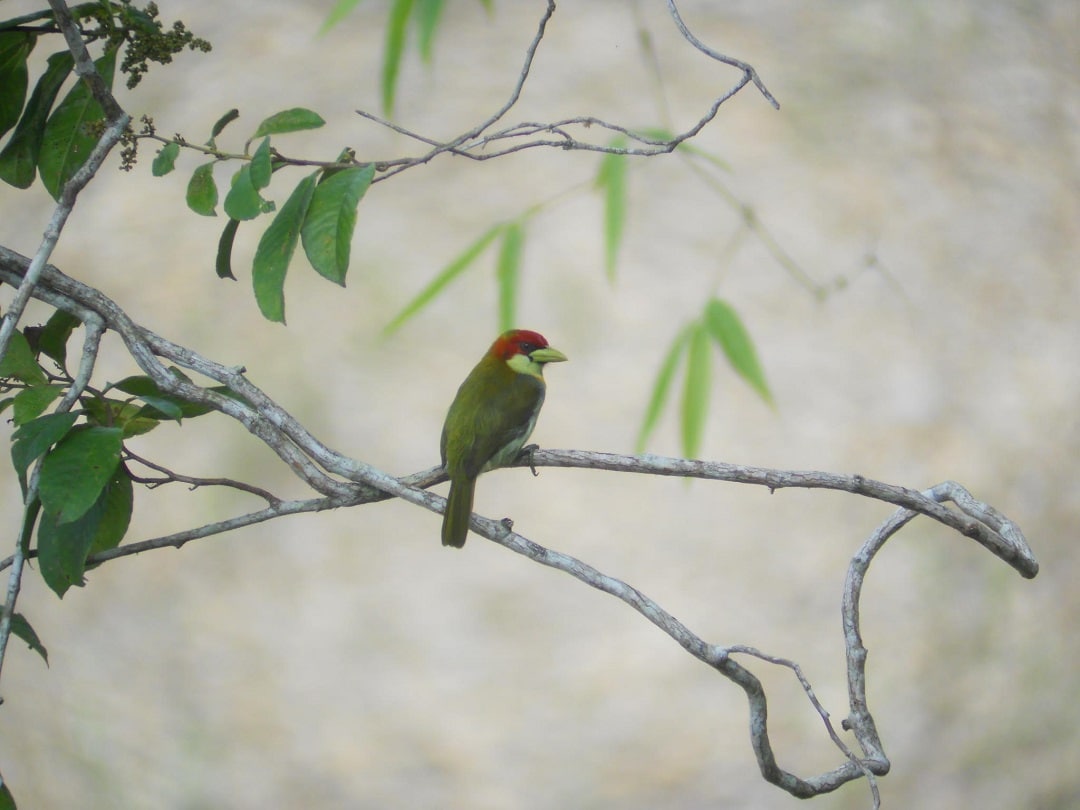
Why Visit Tambopata?
This is the best place to see the Amazon in Peru for many reasons. I honestly thought it was one of the best areas of Amazon jungle to visit.
Biodiversity : The Amazon is home to an incredible array of wildlife, including jaguars, giant river otters, macaws, monkeys, and numerous amphibians and reptiles. It’s also known for its extraordinary insect diversity, including colorful butterflies.
Rainforests : The area boasts extensive, pristine rainforests that are vital for maintaining the health of the Amazon ecosystem. Visitors can explore these lush jungles on guided hikes and nature walks.
Birdwatching : Tambopata is a paradise for birdwatchers, with over 600 species of birds recorded in the region. It’s particularly famous for its large macaw clay licks, where these colorful parrots gather to feed on clay.
River Adventures : The Tambopata River offers opportunities for river excursions, canoeing, and wildlife spotting. You can also take boat tours to explore the waterways and spot riverine species.
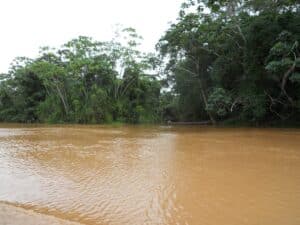
Eco-Tourism : Several eco-lodges and research centers in the area provide sustainable and responsible accommodation options for visitors who want to experience the rainforest while minimizing their impact on the environment.
Research and Conservation : The Tambopata National Reserve is significant for scientific research and conservation efforts aimed at protecting the Amazon Rainforest and its unique biodiversity.
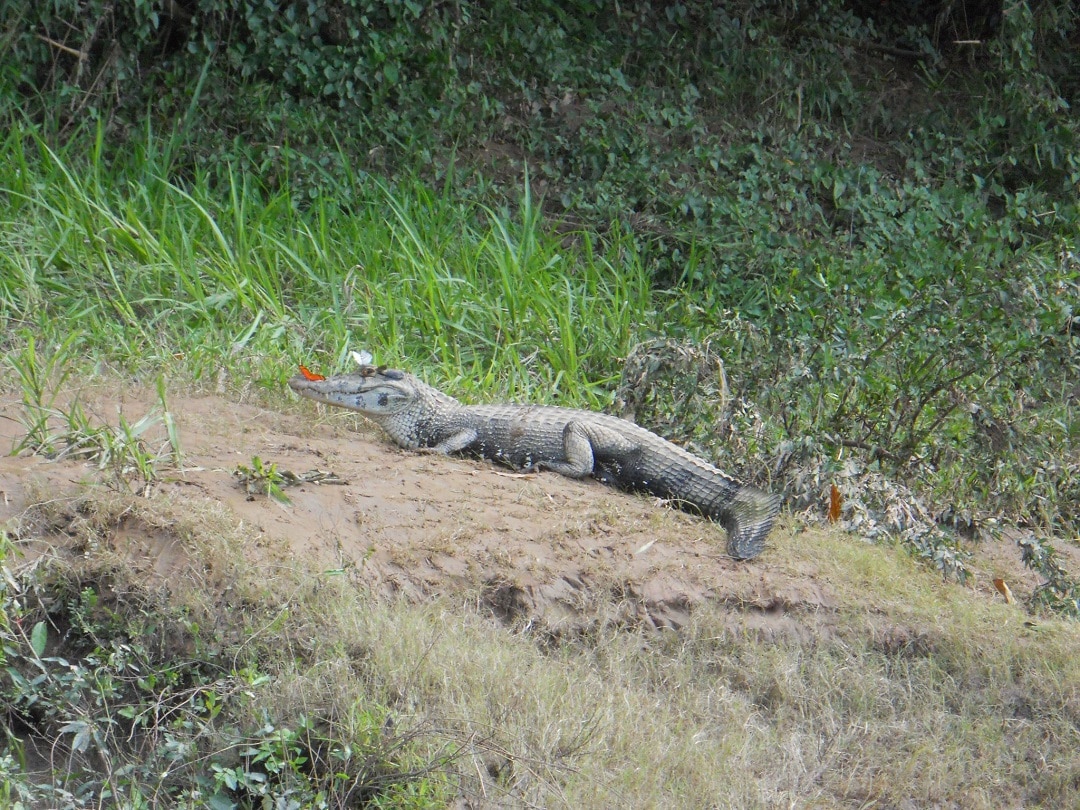
Best Time to Visit the Amazon in Peru
The best time to visit the Amazon in Peru, specifically Tambopata, is during the dry season, which runs from May to September. This period offers more stable weather conditions with less rainfall, making it easier to explore the rainforest, go on wildlife excursions, and enjoy outdoor activities. Additionally, the lower water levels in the rivers make it ideal for wildlife spotting. Daytime highs can go down to 50°F (9°C) and the nighttime lows to 43°F (5°C).
The Amazon in Peru is a year-round destination, and the wet season (from November to March) has its own unique appeal, as it brings lush, vibrant greenery and the opportunity to witness some aquatic species more easily. Around 80% of the annual average of rainfall occurs during this season.
Ultimately, the best time for visiting the Amazon in Peru depends on your preferences, but the dry season is generally recommended for a more comfortable and wildlife-rich experience.
How to Visit the Amazon in Peru (south)
Before you embark on your rainforest adventure, you’ll need to reach Puerto Maldonado, a vibrant town in southeastern Peru that serves as the gateway to the Amazon. Most travelers choose to fly into Jorge Chavez International Airport in Lima, the capital of Peru, and then take a connecting flight to Puerto Maldonado . The journey offers breathtaking aerial views of the Andes mountains as they give way to the Amazon basin.
All lodges in the Amazon provide transportation by either van or bus and then by boat to their remote jungle location. It definitely adds to the experience when you travel on the river. It was a very cool experience for me when I was visiting the Amazon in Peru.
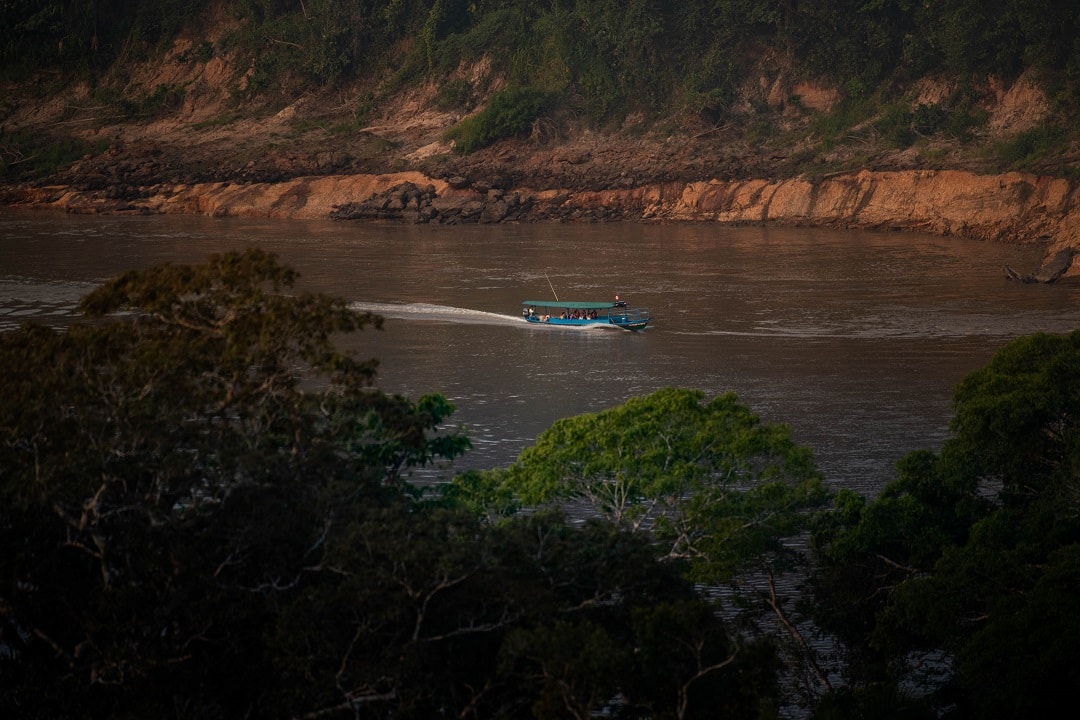
Choosing the Right Amazon Tour
Visiting the Amazon in Peru offers a myriad of exhilarating experiences, with various types of tours to choose from. Jungle lodges provide an immersive experience, allowing you to stay deep within the rainforest and explore its rich biodiversity. River cruises offer a unique perspective as you navigate the winding waterways, providing opportunities for wildlife sightings and relaxation. If you’re seeking a more adventurous excursion, consider adventure tours, which often include activities like hiking, kayaking, and canopy walks, allowing you to delve deeper into the jungle’s secrets.
When selecting the right tour operator, it’s crucial to research their reputation, safety records, and commitment to sustainable and responsible tourism. Reading reviews and seeking recommendations from fellow travelers can be immensely helpful. Ensure that the operator is licensed, follows ethical wildlife interaction practices, and prioritizes environmental conservation. I highly recommend tours with Rainforest Expeditions .
The ideal tour duration can vary depending on your interests and schedule. A short 3-4 day tour can provide a taste of the Amazon’s wonders, while a week-long expedition allows for more in-depth exploration. Keep in mind that travel to and from the Amazon can be time-consuming, so consider how many days you’re willing to devote to the adventure. You will find there are a few options of tours that might interest you.
My recommendation is to stay for at least 4 days to make the most of your visit to the Amazon in Peru. If possible, visiting more than one lodge will enable you to experience different areas of the Amazon. The further you go from Puerto Maldonado, the more remote it gets. This really is the best place to see the Amazon in Peru. You will not be disappointed, I promise!
When I planned my visit to the Amazon in Peru, I stayed between two different lodges for 5 days. I traveled a total of 7 hours up the Tambopata River to the most remote lodge in Peru. The tour that I did included stays at both Refugio Amazonas and Tambopata Research Center .
I have a partnership with Rainforest Expeditions and I would be more than happy to help you plan and book your amazing Amazonian jungle experience. Contact me today to get started.
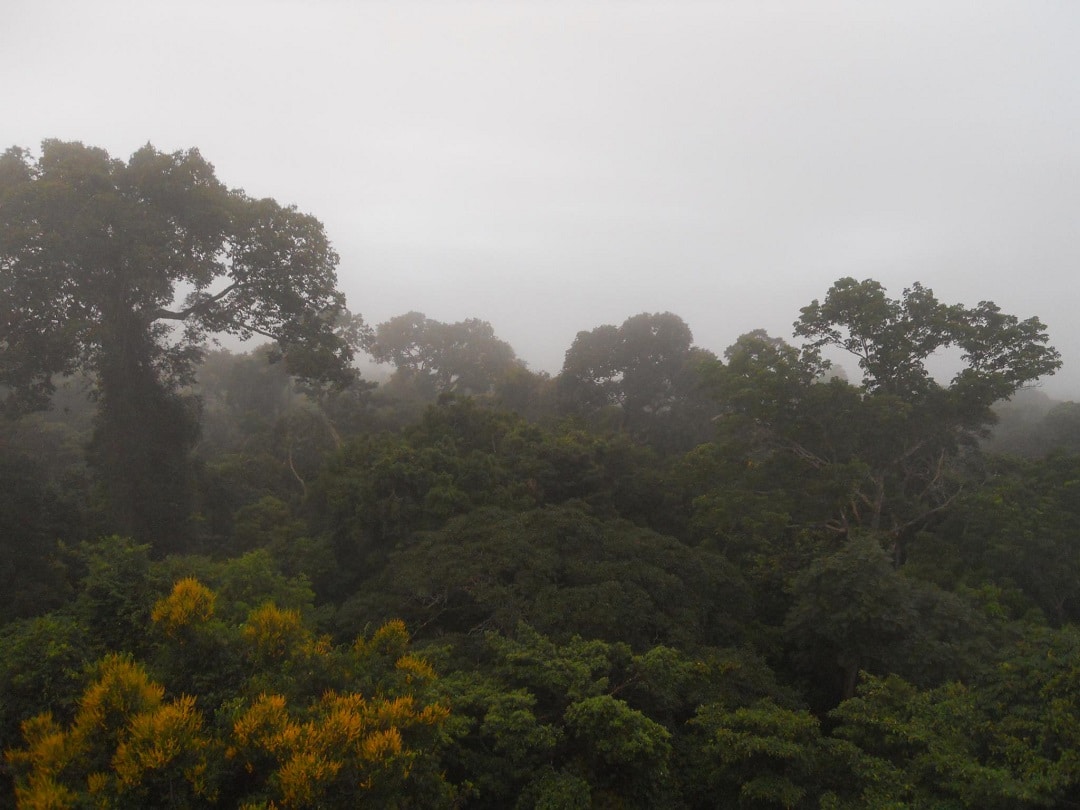
The Adventure Down the River
Any way you look at it, you will travel down the Tambopata river by boat. Your rainforest expedition truly begins when you journey deep into the heart of the Amazon. The Tambopata River, which snakes its way through the rainforest, is a very neat adventure. You can expect to navigate through beautiful scenery, spotting exotic birds and perhaps even an elusive jaguar if you’re lucky. Keep your camera ready, as opportunities for wildlife and bird photography can be anywhere.
Accommodations
There are quite a few different lodges in Tambopata that you could choose. You can read about some of the best Amazon lodges in Peru , but I will provide a brief summary here of my two favorite lodges that I personally experienced and thought they were the best places to see the Amazon in Peru.
Refugio Amazonas
If you are short on time or do not want to venture too far into the Amazon, then you can find shorter options to stay only at Refugio Amazonas.
The Refugio Amazonas Eco-lodge is part of the Wired Amazon program allowing for the promotion of sustainability through its collection of science projects. You can read more about this lodge in the post about the best Amazon lodges .
This lodge has an open wall facing the Amazon rainforest, limited electricity at certain times of the day, and provides eco-friendly toiletries. One of the best things about this hotel is being able to go up a 25 meter canopy tour. The view from the top is amazing! I would go here if only for that view.

Tambopata Research Center (TRC)
If you want a more amazing experience, you can travel further into the dense Amazon jungle, and end up at the Tambopata Research Center (TRC), which is one of the most remote lodges in South America. It was very cool to stay here – especially being so far away from civilization.
This lodge also has an open wall to the Amazon rainforest. It was a creepy yet cool experience!
You have the ability to explore the trails in the area, learn about the Macaws and see the Colorado and Chunco Clay licks and so many more activities to truly connect with nature. There are so many activities you can do here.
Please feel free to contact me to help you plan your stay at one of these lodges!
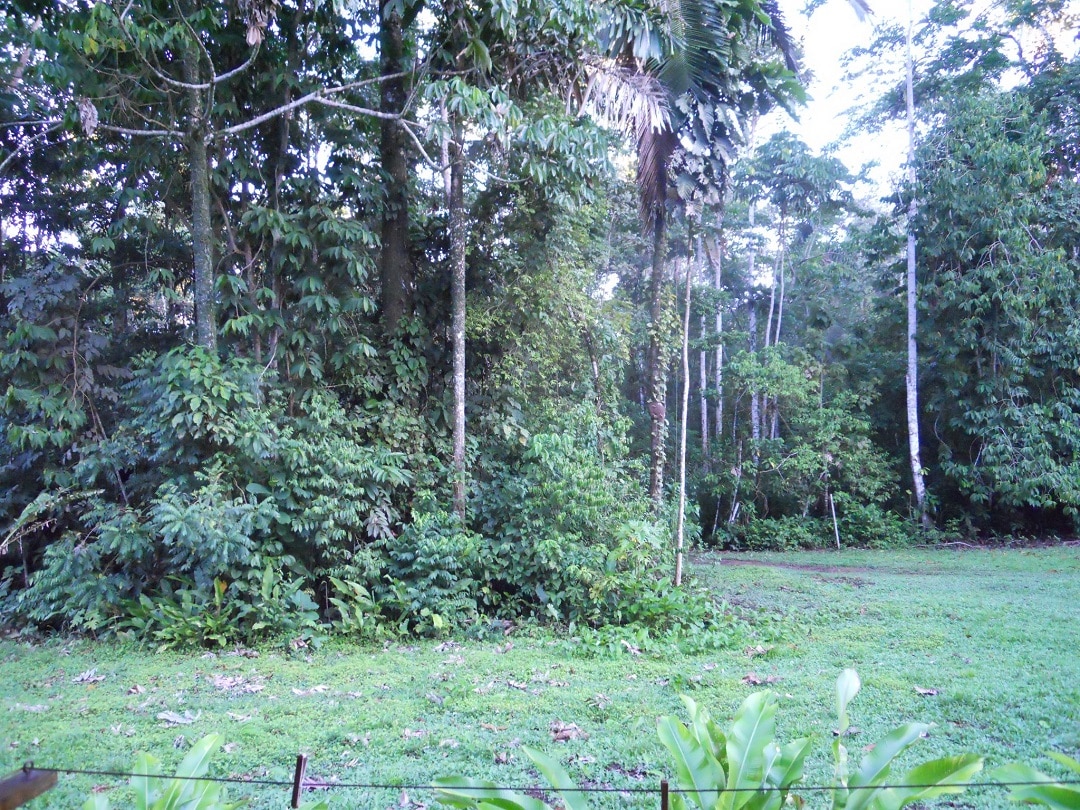
What to Expect When You Visit the Amazon in Peru
Now that you’ve arrived at your accommodations, let’s explore the incredible experiences waiting for you in the Peruvian Rainforest:
Wildlife Encounters
The Amazon is a treasure trove of wildlife, and you’ll have numerous opportunities to spot fascinating creatures. Keep an eye out for iconic species like macaws, toucans, sloths, and capybaras. Guided nature walks and night hikes will bring you face to face with the rainforest’s nocturnal inhabitants, including tree frogs, tarantulas, and brilliantly colored insects.
Canopy Walks
One of the highlights of your journey will undoubtedly be the canopy walks. Suspended high above the forest floor, these walkways provide a unique perspective on the rainforest’s diverse flora and fauna. Stroll amidst the treetops and witness the forest from a bird’s-eye view.
Nighttime Symphony
As day fades into night, the rainforest transforms into a different world. The jungle comes alive with the sounds of nocturnal creatures, from the haunting calls of night monkeys to the chirping of insects. Don’t forget to stargaze; the clear, unpolluted skies of the Amazon reveal a dazzling celestial display.
When I stayed at the TRC, I woke up in the middle of the night to hearing a ‘crunching’ of leaves outside my ‘room’. I had no idea what it was, but I wasn’t going to look and find out what it was!
River Expeditions
Exploring the waterways of the Amazon is an adventure in itself. Glide through narrow tributaries on small boats, searching for caimans, river otters, and the rare pink river dolphins. You can also partake in a sunset cruise to truly enjoy the beauty of the Amazon.
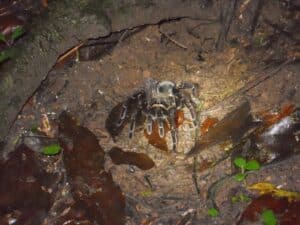
What Should You Bring To The Amazon?
Travel Insurance: Ensure your insurance includes cancellation, curtailment, damage/theft/loss of luggage and medical coverage. I recommend SafetyWing Travel Insurance for all your needs.
Currency: Most lodges accept credit cards for payments of services and goods. Bring small denominations of cash for gratuities. Tipping is not compulsory but is always suggested if you receive good service.
Travel Documents: All visitors to Peru must have a passport that is valid or at least 6 months from the date they will be leaving the country. NOTE: Travel visas are not required for residents of Canada, USA, UK and New Zealand.
Pack Light: When venturing into the rainforest, it’s essential to pack light, focusing on comfortable, moisture-wicking clothing, sturdy hiking boots, and insect repellent. Don’t forget a good-quality raincoat and a compact, waterproof backpack for excursions.
Make sure you download your FREE Amazon Rainforest Packing List below, to ensure you have everything you need for your trip to the Amazon. (You’ll also be subscribing to my newsletter)
Do I Need to Get Vaccinated?
While there are no required vaccinations for travel to Peru, the United States Center for Disease Control and Prevention (CDC) has the following recommendations:
Hepatitis A : Vaccination is recommended to all travelers to Peru.
Hepatitis B : Vaccination recommended to all travelers to Peru, especially those who may have exposure to blood or body fluids through the giving or receiving of medical care, drug injections, tattooing, or sexual contact with the local population.
Typhoid Fever : Vaccination is recommended to all travelers to tropical South America especially those who may be staying in rural areas where exposure through food or water could occur.
Yellow Fever : Vaccination is highly recommended for travel to the Amazon. The shot should be given at least 10 days before your arrival and at 10-year intervals if you decide to stay.
Rabies : Vaccination is ONLY recommended to travelers with an increased risk of exposure.
Tips for Visiting the Amazon in Peru
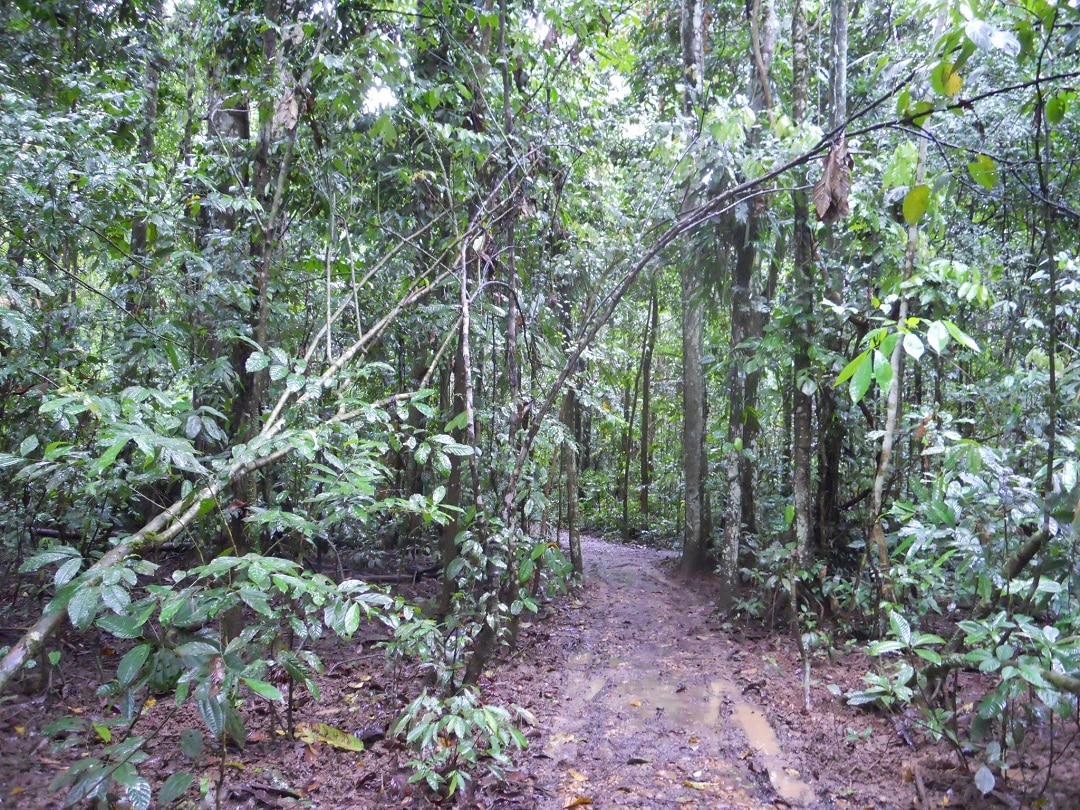
Sustainability in the Amazon
Did you know that more than 20% of the world’s oxygen is produced in the Amazon, and Amazon rainforest animals make up more than half of the plant, animal, and insect species in the world?
This pristine ecosystem is home to an incredible diversity of flora and fauna, including many endangered species. Efforts to promote sustainability in Tambopata focus on responsible ecotourism, reforestation initiatives, and protecting indigenous communities’ rights and lands.
Tambopata National reserve is well known for its abundance of clay licks frequented by macaws and parrots and being one of the most biodiverse areas in the world.
By supporting eco-friendly tourism practices that minimize environmental impact, conserving natural resources, and respecting the indigenous peoples’ traditional knowledge and territories, we can ensure the long-term health and vitality of this crucial part of the Amazon rainforest while contributing to global conservation efforts and addressing climate change challenges.
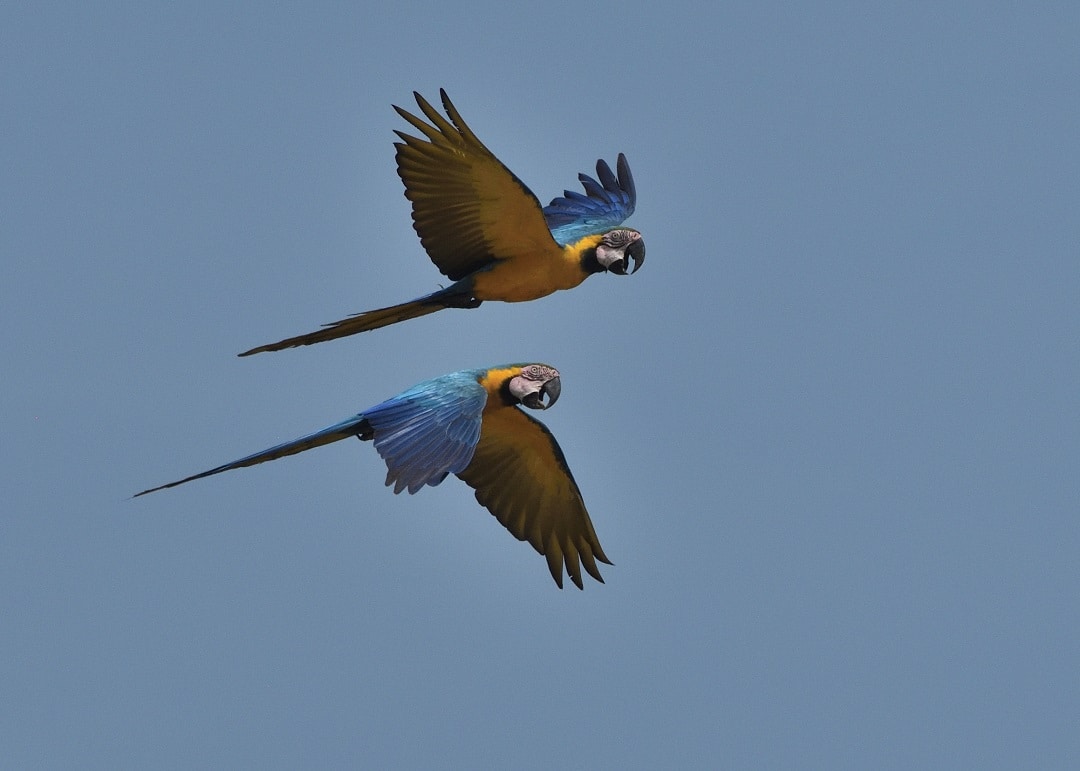
Blue-and-yellow macaws by Carl Safina for Rainforest Expeditions
A journey through the Peruvian Rainforest is an unforgettable adventure that allows you to connect with nature, witness incredible wildlife, and experience the magic of the Amazon. IT truly is one of the best places to see Amazon in Peru.
From the moment you board the boat to the serene nights at your chosen lodge , every moment in this tropical paradise is an opportunity to create lasting memories. So, pack your sense of adventure and embark on a journey into one of the world’s most biodiverse and captivating ecosystems. No matter when you go, there really is no best time to visit the Amazon in Peru; any time is good!
Don’t forget to download your Amazon Rainforest packing list!
If you enjoyed my post, follow me on social media or subscribe to my newsletter below, so you can stay connected on future posts, hiking trips and more.
Melanie is the founder of The World Travel Girl. She has been traveling for over 12 years and decided to share her passion with others. She is a travel writer and travel planner who also loves hiking, birdwatching and watching wildlife. Her mission is to help every day people explore the outdoor world and connect with nature.
Leave a Reply Cancel reply
Your email address will not be published. Required fields are marked *
Save my name, email, and website in this browser for the next time I comment.
Unlock Exclusive Content Delivered Directly to Your Inbox!

Book With Leading Tours While Protecting Habitat
- Amazon Rainforest
- Galapagos Islands
Puerto Maldonado
- South Africa
- Tours & Lodges
- Cruises in the Tropics

Hi, I'm Ash, your tour advisor. I hope you find this post helpful. If you want my help deciding on an experience, send me an message .
The Best Areas of Amazon Jungle To Visit In Peru: Make The Most Of Your Experience

Peru’s Amazon Rainforest offers one of the best areas of Amazon to visit.
To provide a summary:
- Peru has the second highest amount of rainforest after Brazil.
- Peru offers one of the most thought out tourism industries in Amazonia.
- There are more claylicks in the Peruvian Amazon than anywhere else in South America.
- Along with Ecuador, Peru’s rainforest is located in western Amazonia. This offers the most wildlife (linked to the nearby Andes Mountains).
With these things in mind, the Peruvian rainforest is an incredible place to visit. Enjoy beautiful scenery, relaxing cruises, adventure tours and fantastic wildlife.
But where in the vast Peruvian jungle do you visit?
First, let’s first have an introduction to this tropical forest and cover:
- Protected rainforest areas
- Differences between regions
- Recommended Amazonian attractions
- Gateways to the Peruvian Amazon
- Our recommended lodges, cruises and tours to experience Amazonia
Jump straight to our recommended tours for Peru’s Amazon Rainforest
An Introduction to the Amazon Rainforest
Crossing nine nations, the Amazon Rainforest covers 40% of the South American continent.
This is the world’s largest rainforest. And it’s home to more life than anywhere else on Earth.
The next largest forests of the Congo in Africa and the tropical wilderness of New Guinea can fit comfortably inside the Amazon.
The vast tropical forest is fed by the mighty Amazon River. This ranks as one of the world’s largest rivers. Fed by over 1,000 tributaries and crossing the continent, the Amazon is the world’s largest river by volume and the second longest after the Nile.
Beginning as a trickle in the Ecuadorian and Peruvian Andes, the giant river travels the continent to its mouth in Brazil. Near the Brazilian city of Belem, the Amazon expels an incredible quantity of water into the Atlantic Ocean. It’s even said that early sailors could drink fresh water from the ocean before sighting the South American shoreline.
The majority of the Amazon Rainforest is contained within Brazil, Peru, Colombia, Bolivia and Venezuela. Within these areas, you can enjoy some incredible wildlife. See the iconic Amazon Rainforest animals, such as macaws, tapir, monkeys and even jaguar.
The Amazon contains several different types of vegetation. And it isn’t just limited to rainforest. Dispersed within the Amazon, you can find seasonal forests, flooded forests and even grasslands. These areas contain their own wildlife communities and add to the diversity of Amazonian life.

Peru’s Amazon Rainforest
Peru contains the second highest amount of Amazon Rainforest after Brazil. And the Peruvian rainforest is one of the best regions to visit.
There are two main gateways for the Peruvian Amazon. These are Iquitos as a port of the Amazon River in Peru’s north and Puerto Maldonado in the south. Puerto Maldonado provides access to the incredible Tambopata National Reserve and Manu lowlands.
The southern Peruvian Amazon offers more claylicks than anywhere in South America. This is the rainforest accessed from Peru’s gateway town of Puerto Maldonado. From here, you can enjoy visiting the licks to see hundreds of colorful birds.
The parrots visit these areas to eat clay. This is thought to provide essential salts and to help neutralize toxins found in the birds’ diet of unripe fruits and seeds.
You can experience the claylicks from fantastic lodges. These offer guided tours to Tambopata’s claylicks. And two recommendations are the Tambopata Research Center and Refugio Amazonas Lodge .
In addition to the claylicks, within the Peruvian Amazon you can find beautiful lakes home to lake-living wildlife. Some of these are even home to endangered giant river otters.
In Peru’s north from Iquitos you can enjoy fantastic cruises to enjoy the Amazon River. There are also jungle lodges for guided expeditions of the Iquitos rainforest .
To make the most of Peru’s Amazon Rainforest, you can see our selection of the top Amazon tours in Peru .

Protected areas in the Peruvian Amazon
Peru has protected around 15% of its land area.
And among these parks and reserves are some fantastic protected areas of Amazon Rainforest. Some favorite regions of protected rainforest include:
The Tambopata National Reserve
The manu national park, the pacaya samiria national reserve, the tamshiyacu tahuayo reserve.
Tambopata is found in southern Peru near the gateway jungle town of Puerto Maldonado. The Tambopata National Reserve offers a fantastic area of Amazonia to visit.
Protecting 274,690 hectares, the reserve includes forest fed by the Tambopata and Heath rivers.
Because Tambopata is so close to the gateway jungle town of Puerto Maldonado, this is often the best choice for a short 2 or 3-day rainforest tour. This is because you can be in areas of high diversity after a relatively short amount of travel time.
The reserve offers continual forest with other protected areas. Connected areas include the Madidi National Park and Bahuaja Sonene National Park. This allows wildlife to move freely in a vast area of protected tropical forest. As a reference, when taken together this protected areas mosaic is about the same size as Belgium.
On guided tours, enjoy an abundance of wildlife. See many tropical birds, several different monkeys, tall emergent trees and many different flowers. You can also enjoy many claylicks where you can watch colorful parrots.
And to experience the rainforest, there are some fantastic lodges in the Tambopata region. These offer professionally guided rainforest tours.
A favorite recommendation is the Tambopata Research Center . This is a great option for deep jungle adventures and for the best wildlife opportunities. It’s also the only lodge actually inside the Tambopata National Reserve.
Click the video below for an introduction.

There are also lodges closer to town, such as the Posada Amazonas for giant river otters and the Refugio Amazonas in the Tambopata buffer zone.

The Tambopata Research Center
Positioned in the middle of the wildlife-rich Tambopata National Reserve, near one of the largest macaw clay licks in the ...
Includes: all meals, accommodation, selection of guided tours, transfers from and to Puerto Maldonado airport. | 4, 5, 6 days+
Let’s have a look at the wildlife you can see from these three lodges. The percentages represent your chance to see each animal.
The Manu National Park is one of the more famous areas of Peruvian Amazon. This vast expanse of forest covers 1.7 million hectares of lowland rainforest and Andean forest.
An incredible diversity of species are found in Manu National Park and the park has won world records for diversity. Although visitors are not permitted inside the national park itself, you can tour the reserved zone and connected Amarakaeri Communal Reserve.
Lake Salvador in the Manu Reserved Zone is one of the main attractions of the area. In and around the lake, enjoy spotting giant river otters, many different birds, and different monkeys in surrounding rainforest.
Like Tambopata, the Manu region is also famous for claylicks and you can see many colorful macaws gathered at the clay. From the Manu Wildlife Center, enjoy a large macaw claylick and have a high chance of spotting tapir at the tapir lick.
Located around 150 km from Iquitos, a port city of the Amazon River in northern Peru, you can find the Tamshiyacu Tahuayo Reserve.

The reserve was founded for local initiatives as well as protecting the range of the rare red uakaris. These are monkeys that have red fur and a bald head. And they live in the middle of the Tamshiyacu Tahuayo area.
The Tamshiyacu Tahuayo Reserve contains both flooded and non-flooded forest. And you can find many different emergent trees, bromeliads and orchids.
There are many monkeys that live in the reserve. On expertly guided tours from the Tahuayo Lodge, you can spot howler monkeys, capuchins, tamarins, pygmy marmosets, titis, and saki monkeys.
For an introduction, click the video below.

The reserve is also home to an impressive diversity of birds. Species to see include hoatzins, oropendolas, macaws, toucans, and colorful cotingas and tanagers.
Although rarely seen, camera traps have revealed a healthy population of jaguar. The cameras have also captured images of very rare black jaguar visiting the area.
To enjoy guided tours of the Tamshiyacu Tahuayo Reserve, you can check availability with the Tahuayo Lodge (the only tourist lodge for the reserve) by clicking the tour bubble below.

The Tahuayo Lodge
From the Tahuayo Lodge, you will explore the Amazon Rainforest’s wildlife-rich Tamshiyacu Tahuayo Reserve with a private guide on a ...
Includes: all meals, accommodation at 2 rainforest lodges, private guide, custom activities, transfers from and to Iquitos airport. | 4, 5, 6, 7, 8 days+
Accessed from Iquitos in Peru’s northern Amazon, the Pacaya Samiria National Reserve is one of the largest of Peru’s protected areas. This is a mostly flooded area of Amazon Rainforest best experienced on a rainforest cruise.

The reserve protects just over 2 million hectares of tropical forest. Within this vast expanse of rainforest, you can find an incredible diversity of animals and plants.
The tributaries here are often blackened by nutrient-rich waters. This causes the water to perfectly reflect the trees and sky giving the Pacaya Samiria its other name of ‘The Forest of Mirrors.’
In addition to spectacular scenery, enjoy watching many different animals. Spot pink river dolphins, colorful birds and several different monkeys. You will also find giant trees with orchids and bromeliads perched on the branches.
There are some fantastic cruises for the Pacaya Samiria flooded forest. Our favorites are the Delfin cruises, such as the Delfin III , which is a luxury Amazon River cruise.

You can also choose the Delfin I , which is one of the most exclusive luxury cruises in the Amazon Rainforest.
The cruises offer high-end comfort, delicious cuisine and excellent guided tours. From the vessels, you will explore Amazonia to enjoy fantastic wildlife opportunities with skilled naturalist guides.

The Delfin I
Offering an on-board experience second to none, the Delfin I Luxury Cruise begins in Iquitos, north Peru, and takes you ...
Includes: all meals, accommodation, all excursions, alcoholic beverages, juices, house wines, luxury transfers from & to Iquitos airport | 4, 5 days

The Delfin III
The Delfin III provides a luxury cruise of the Amazon River. The vessel features hardwood floors, designer furniture and is ...
Includes: all meals, accommodation, all excursions, select alcoholic beverages, juices, house wines with meals, luxury transfers from & to Iquitos airport | 4, 5 days
Attractions in Peru’s Rainforest
The Amazon Rainforest is a fantastic places to visit. Within this vast forest, lodges have often been built near the best areas for wildlife viewing. Because of this, lodges are often placed near oxbow lakes or claylicks.
Claylicks are areas of exposed ground, usually on the riverbank, where different animals come to feed from salt-rich and medicinal clay.
In the Amazon Rainforest, the most famous animals that visit the licks are the large and colorful macaws. However, many other animals, including parrots, monkeys, peccary, capybara and tapir also visit the different licks.

Because of the draw to parrots and herbivores, predators such as margays, ocelots and even jaguar patrol the claylicks looking for an easy meal. It’s not unusual to see these animals catch their prey when watching the birds.
The claylicks offer guests almost guaranteed wildlife spectacles with hundreds of colorful parrots seen at one time.
Enjoy seeing the many different species of Peruvian macaws. These include blue-and-yellow macaws, scarlet macaws, red-and-green macaws, chestnut-fronted macaws, red-bellied macaws, blue-headed macaws, and red-shouldered macaws.
Some favorite lodges to enjoy the claylicks are the Tambopata Research Center and Refugio Amazonas Lodge from Puerto Maldonado in Peru’s south.

The Refugio Amazonas Lodge
The best end to a fantastic intrepid trip in Peru…!! Wish we had of spent more time there… Staff were ...
Includes: all meals, accommodation, selection of guided tours, transfers from and to Puerto Maldonado airport. | 3, 4, 5 days+

The Posada Amazonas Lodge
We went to Posada Amazona in August and we were not expecting this place. This is a beautiful lodge, incredible ...
Amazon Lakes
Lakes in the Amazon Rainforest are often oxbow lakes. These are areas where tributaries of the Amazon River once flowed but have since changed direction.
This has left behind bodies of water cut off from the rest of the tributary. And they often have an oxbow shape due to the river once curving its way through the forest.

These lakes attract a wide variety of Amazon Rainforest animals. Different trees and plants start to grow, which attract a variety of monkeys as they fruit and flower. The lake itself provides home to caiman crocodilians and many different fish, including the giant arapaima. Cormorants, herons, and hoatzins then patrol the lake edges.
Sometimes, the lakes also provide home to endangered giant river otters. The otters can often be seen at the fantastic community-owned Posada Amazonas Lodge.
Two fantastic examples of oxbow lakes include:
- Lake Tres Chimbadas from Posada Amazonas Lodge (Giant otters)
- Lake Condenado from Refugio Amazonas Lodge (Hoatzin, Horned Screamers)
Where To Visit In Peru’s Rainforest
There are some fantastic areas in Peru to experience the tropical forest and to find fascinating animals and plants.
The two best regions to experience the Peruvian Amazon Rainforest are Iquitos in the north and Puerto Maldonado in Peru’s south.
Puerto Maldonado is a fantastic gateway to Peru’s Amazon Rainforest. This is the best choice if you’re interested in a short rainforest experience of 2 or 3 days. The incredible diversity of animals and plants are found in the nearby Tambopata National Reserve.
The protected areas from Puerto Maldonado to visit are the Manu National Park region and Tambopata National Reserve. Both of these areas offer outstanding levels of wildlife.
When to visit Puerto Maldonado
Puerto Maldonado offers a consistent temperature with a tropical climate. The year is mainly separated into a wet season and dry season. Although rain can fall at all times of year, which nourishes the trees and plants, the rain is more intense over the wet weather months.
Puerto Maldonado also experiences cold fronts blown up from Argentina. You will experience these over the months of May through September when temperature can get down to 43° F (5° C) for a few days at a time.
When to visit Puerto Maldonado • in/°F | mm/°C
As with other tropical environments, the main temperature difference is between day and night. This is instead of between months. For more information on Puerto Maldonado, you can see the Puerto Maldonado travel guide .
Recommended lodges to experience the Amazon Rainforest from Puerto Maldonado are:

The Tambopata Research Center is one of the deepest lodges in the Amazon Rainforest. And it offers comfortable accommodation with different suite types, including luxurious deluxe suites.
From this comfortable lodge, enjoy expertly guided tours deep in Tambopata National Reserve.
Due to the lodge’s position, the surrounding rainforest is at carrying capacity for wildlife. Visitors even enjoy a 20% chance of seeing jaguar by the river.
Click the video below for a quick intro.
The lodge is also located near one of the largest macaw claylicks in the Amazon Rainforest. You can see hundreds of parrots gathered at the clay.
Led by skilled guides, explore the rainforest to find many different animals and plants. You’re likely to see spider monkeys, howler monkeys, tamarins, peccary, and a diversity of different birds. You will also enjoy stunning scenery of the Tambopata region.

The Refugio Amazonas Lodge offers a fantastic experience for a 3 or 4-day tour of the Amazon Rainforest.
This is a comfortable lodge in the buffer zone of the wildlife-rich Tambopata National Reserve. Enjoy guided small-group expeditions in the Peruvian Amazon.
The lodge offers one of the only children’s trails in the Amazon, which makes it a great place for families with small children.
Enjoy a canopy tower to spot toucans, parrots and other birds flying over the rainforest canopy.
You will also visit small claylicks and have a chance to visit a large macaw claylick. Pick from a range of activity options offered from the Refugio Amazonas. These include the canopy tower, ethnobotanical trail, lake visits and a number of others.

The Posada Amazonas is a community-owned lodge near a fantastic lake for spotting endangered giant river otters. The lodge is a great option for a 3 or 4-day experience of the Amazon Rainforest.
Enjoy guided tours led by members of the Ese-Eja community to explore the surrounding rainforest. See several different monkeys, colorful birds, different reptiles and amphibians. You will also find tall rainforest trees and delicate flowers.
In addition to the resident giant river otters, the nearby lake is home to hoatzin birds, caiman crocodiles and horned screamers.
From Posada Amazonas Lodge, you will also visit a working community farm and enjoy the ethnobotanical trail. You can also visit a small claylick to watch colorful parrots.
On tour from Posada Amazonas Lodge, there are different activities. These include the tall canopy tower for watching birds over the rainforest canopy, rainforest walks and night hikes.
You can also enjoy a selection of add-on activities, including jungle mountain biking.
Iquitos is a port city of the Amazon River to enjoy guided tours of the Peruvian Amazon. Choose from different lodges for the rainforest and multi-day cruises of Pacaya Samiria National Reserve.
Famous as the largest city on Earth unconnected to any other by road, you can visit the city aboard a direct flight from either Lima or Cusco.
The main attraction here is enjoy a tour from an Amazon Rainforest lodge or cruise. However, there are also some different things to do in Iquitos itself.
A favorite thing to do in Iquitos city is to enjoy visiting the Manatee Rescue Center.
Here, you can see manatees and turtles being cared for before their release into nearby protected areas. This option is included on many cruises and different rainforest lodges can add this to your itinerary.
When to visit Iquitos
Like many other tropical areas, Iquitos is a fantastic place to visit no matter when you wish to travel. However, there is a wetter season from October to June.
Note that wet weather can be expected at all times of year. The rain often falls towards late afternoon and evening then clears by the next morning. This means it doesn’t usually affect your experience. But sometimes the rain can last for a few days at a time.
When to visit Iquitos • in/°F | mm/°C
For more information, you can see the Iquitos Travel Guide .
There are some fantastic tours from Iquitos, including deep jungle lodges and Amazon RIver cruises.
Our recommendations to experience the Iquitos Amazon Rainforest are below. These offer exploration of the Pacaya Samiria Reserve and Tamshiyacu Tahuayo Reserve:

This is a Rainforest Alliance certified lodge and one of the favorite lodges in Amazonia for wildlife lovers. On this Amazon tour, you can experience both the main Tahuayo Lodge and Tahuayo River Amazon Research Center.
Enjoy a deep rainforest experience to see fantastic wildlife on guided walks. Spot pink river dolphins in the Amazon’s tributaries, many different monkeys, toucans and macaws. You can also find anaconda, blue morpho butterflies, poison dart frogs and caiman crocodilians.
The monkeys you can find are particularly diverse. Your guide will lead you along trail walks in the rainforest to find many different monkeys. Spot capuchins, squirrel monkeys, titi monkeys, sakis, howler monkeys, pygmy marmosets and tamarins. A few lucky visitors are even fortunate to see the rare red uakari monkeys deep in the reserve.
The Tahuayo Lodge offers itineraries from 4-days and over. However, 6 days are required to visit both the Tahuayo Lodge and Tahuayo River Amazon Research Center.
Tours of 4 and 5 days will be restricted to the main lodge, which still offers abundant wildlife and a range of activities.
Enjoy a private and custom tour as standard to explore the Tamshiyacu Tahuayo Reserve. Head out on walking trails, traditional canoes, boat trips and night spotting excursions.
The Delfin I Amazon Cruise

The Delfin I offers you not just a cruise, but a floating boutique luxury hotel in the Amazon. And with only four opulent, oversized suites, exclusivity is your reality. Imagine the space, the comfort and the intimate connection with the Amazon Rainforest, all wrapped in the cocoon of unparalleled luxury.
After incredible excursions, lay on your large luxurious bed watching the rainforest and colorful birds from the privacy of your suite.
Cuisine aboard the Delfin I is an experience in itself and the quality and flavors complement the beauty of Amazonia and the elegance of the vessel.
Deserving the attention, the cruise has graced the pages of CNN Money, Conde Nast Traveler, National Geographic Traveler, and Travel+Leisure. Picture yourself in one of the two suites boasting a private whirlpool as you voyage deep into the wildlife-rich rainforest of the Pacaya Samiria.
Click the video below for a short introduction.

But remember, with only four suites, the Delfin I books quickly. And to ensure your space, act swiftly. We advise booking your journey 3 to 6 months in advance. Don’t just dream about luxury in the Amazon — embrace it on the Delfin I.
Send your request to the Delfin I cruise to check availability for your travel dates and receive your itinerary using the tour bubble below.
The Delfin III Cruise

The Delfin III offers a luxury Amazon River cruise from Iquitos and is the larger small-group sister vessel of the Delfin I.
Although the Delfin III offers the advantage of a lower rate then the Delfin I, service, cuisine and comfort are equally high. And you can also choose the premium suite options at the front of the vessel.
The cruise vessel features hardwood floors and designer furniture. And there is also handmade Peruvian artifacts decorating the interior.
The Delfin III provides four classes of accommodation. The lower deck features the Suites, which offer floor-to-ceiling windows to stay connected to the rainforest. This level then has two spacious Corner Suites at the front of the vessel for fantastic views. On the upper deck, you can find the Upper Suites and one very large Owner’s Suite as the premium accommodation option.
On the upper deck, you can then find the indoor and outdoor lounge, a sundeck with plunge pool, bar, gym and spa.

From the vessel, you will head out with your professional guide for rainforest exploration to see a variety of animals. See several different monkeys, toucans, parrots and many other animals.
To check availability for your travel dates, send the Delfin III a request with the tour bubble below.

Want inspiration for future adventures?
Join our community for monthly selections of the world’s best tours, lodges, and cruises.
Easily unsubscribe at any time.
Thanks. You have been added to the mailing list.

- Adventure Travel

9 Best (and Life-Affirming) Amazon Tours and Excursions

Jessica grew up in California, where she learned to love the beach and sunny weather...and then s...
- button]:border-none [&>button]:bg-white [&>button]:hover:cursor-pointer [&>button]:hover:text-cyan-400"> button]:hover:text-cyan-400 [&>button]:bg-white hover:cursor-pointer" height="1em" width="1em" xmlns="http://www.w3.org/2000/svg">
Visiting the Amazon Rainforest is hugely popular, and for good reason. It’s one of the most bio-diverse areas in the entire world. From sloths to monkeys, one of every ten known species lives in the Amazon. That’s worth a visit! But surely you’re now wondering how to visit the Amazon rainforest.
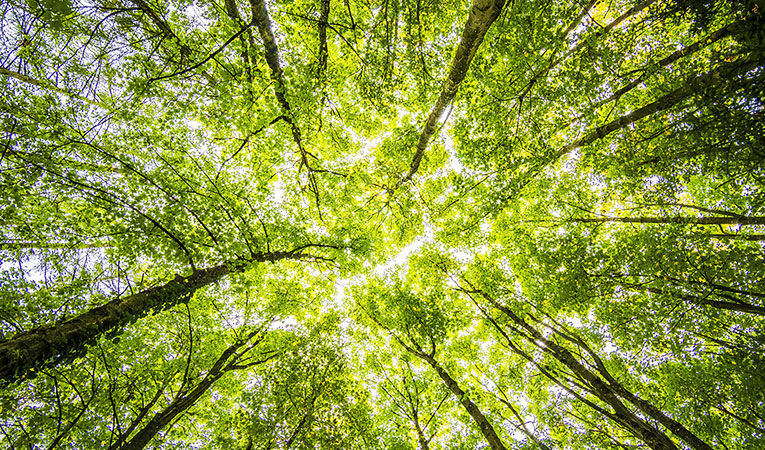
The best Amazon tours will leave you feeling stunned.
Amazon Rainforest tours in Brazil are typically the first thing people think of as Amazon destinations, but you can (and should!) visit the Amazon in Peru or Ecuador as well. The Amazon isn’t the only place to see rainforests, either! There are tons of other rainforest adventure travel tours you can consider.
Can you visit the Amazon Rainforest?
Yes, but since the Amazon is such a popular and amazing destination, it’s important to visit in an ethical way. This means going with a tour or a well-trained guide. The best Amazon tours have local guides to help you navigate the forest so you don’t get lost. Plus, they know a ton about the wildlife and fauna! They can also take you to visit indigenous tribes that they have pre-existing relationships with, so you’re not just barging in on a tribe that may not be interested in contact with tourists.
So, can you go to the Amazon Rainforest? Absolutely, but make sure you go with a tour and have a guide with you. Guides will help your visit and experience in the Amazon Rainforest reach its fullest potential while still ensuring that your visit is ethical and not damaging to the area or the wildlife.
[Related: Brazil Adventure Travel: 9 Things to Know Before You Go ]
How to visit the amazon rainforest.
Editor’s note: This information on visiting the Amazon Rainforest was accurate at the time of publishing. Please refer to each individual program for current data.
1. AFS Brazil Global Prep: Amazon River Odyssey — Leave the first review!

This isn’t any regular Amazon tour; it’s an incredible river odyssey in the Amazon Rainforest. This trip includes a stay in the capital of the Amazonas region, Manaus. You’ll see the sights and dance with the locals! You’ll also stop by the Terra de Cachoeiras or Land of Waterfalls. After that, it’s a six-day river odyssey down the Amazon River. Accommodation includes hammocks in the jungle (how cool is that?!). You might even spot some wildlife like alligators or piranhas.
- Where? Brazil
- Duration? 10 days
- Read AFS USA reviews
2. Amazon Jungle Survival — Leave the first review!
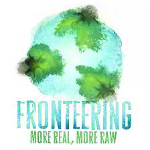
Are you tough enough to survive in the Amazon jungle by yourself? This survival excursion spends over a week teaching participants essential skills like how to locate a clean water source, construct traps to catch food, and even hunt with a bow and arrow!
You’ll also learn skills like starting a fire without a match or lighter, building a shelter, and finding your way out of the jungle. Then, you’ll have the chance to prove yourself during the Isolation Phase — two days where you’re completely on your own! You’ll come away from this incredible tour with new skills and new self-confidence to top it all.
- Where? Guyana
- When? Year-round
- Duration? Two weeks
- Read Fronteering reviews
3. Amazon Rainforest Wildlife Rescue in Ecuador — 10

Are you especially excited about the wildlife in the Amazon forest? This tour features the rehabilitation of wild animals that went through abuse and trafficking. Participants will stay at a beautiful property located deep within the forest and interact with animals such as parrots, monkeys, turtles, and even wild cats! What better way to tour the Amazon than to care for its residents? You’ll have a blast working with wildlife rescue on this Amazon forest tour.
- Where? Ecuador
- Duration? 2-12 weeks
- Read Kaya Responsible Travel reviews
4. South America Semester: Andes & Amazon — 9.33

Looking for Amazon Rainforest tour packages that are longer than just a couple weeks? Look no further. This “gap year” tour lasts about 3 months! Participants will spend at least 2 weeks trekking through the Amazon forest, learning about conservationism and rubber-tapping along the way. The program also includes a visit to Mt. Tunupa, a multi-colored volcano that overlooks the Salt Flats in Bolivia, and even a hike up Machu Picchu! Well-rounded and packed with incredible experiences, this gap-year will transform you as a traveler and person.
- Where? Peru and Bolivia
- Duration? 3 months
- Read Where There Be Dragons reviews
5. South America Gap Year Semester | Pacific Discovery — 10

Speaking of programs that allow you to explore a little bit longer, this gap year helps participants to travel around South America, especially Peru and Ecuador. You’ll have incredible opportunities like snorkeling in the Galapagos Islands, biking Machu Picchu, and helping with service projects for local villages. Once you make it to the Amazon portion of the trip, you’ll be rafting down the Jatunyacu River in the Amazon Basin. As if that wasn’t cool enough, you’ll also see tons of wildlife and maybe even learn about how chocolate is made. Yum!
- Where? Ecuador and Peru
- When? Fall or Spring
- Duration? 9-12 weeks
- Read Pacific Discovery reviews
6. 15 Day Spanish Language + Amazon Experience Tour — Leave the first review!

This program has a heavy focus on the Spanish language, a huge plus for travelers looking to become bi- or even trilingual. You’ll get incredible language immersion and opportunities to practice Spanish with the locals while you explore Ecuador. This trip features an Amazon excursion for three days — enough time for you to experience the incredible natural beauty, but short enough that you’ll have plenty of time for other Ecuadorian adventures such as a coffee tour, South American cooking class, and salsa dancing!
- Duration? 15 days
- Read Worldaway Learning Tours reviews
7. Volunteer: Amazonas Explored — 9

This Amazon tour combines the best of both worlds: volunteer work that will make a difference and amazing adventures in the Amazon forest! One week of this program is spent in local villages (that are occupied by “a playful troop of monkeys”), helping residents to build bathrooms and other necessary structures as well as teaching children English. The other week(s) are spent exploring the Amazon jungle further by hiking, canoeing, tubing, visiting an Amazonian animal refuge, and meeting with a shaman. If you stay an extra week, your tour can also include hiking two active volcanoes, visiting the ocean, swimming with whales and dolphins, and finishing off at the "Center of the World", the equator line!
- Duration? 1-4 weeks
- Read Volunteer Eco Students Abroad reviews
8. 8-Day Indigenous Cultures & Amazon Rain Forest Tour — Leave the first review!

If you’re interested in visiting the Amazon Rainforest, chances are you’ll love touring the Cloud Forest in Ecuador. This tour gives you both in one trip! Plus, you’ll spend time with indigenous tribes of Ecuador like the Otavalos People of Imamabura, a Pre-Incan Tribe in the Cloud Forest, and an original Amazonian Tribe. You’ll experience both incredible forests firsthand and connect further by getting to know the people and culture. Plus, you’ll probably get to try some common local foods, such as a rainforest tree slug (we’re not kidding!).
- Duration? 8 days
9. Traditional Plant Medicine, Herbalism, and Ethnobotany — 9

This is a great Amazon tour for our travelers with a knack for or interest in natural medicine and herbalism. Participants are housed with a local family who practices herbalism. You’ll get to see firsthand what practices and plants are used! You won’t just see the Amazon forest; you’ll also learn how to use its resources to help people who are sick. You can fulfill your lifelong dream of touring the Amazon while simultaneously helping people. It’s a win-win!
- When? Summer
- Read Amazon Learning reviews
Can’t pick? Compare These Programs Side-by-Side for FREE with MyGoAbroad
Visit the amazon rainforest and meet our planet’s lungs.
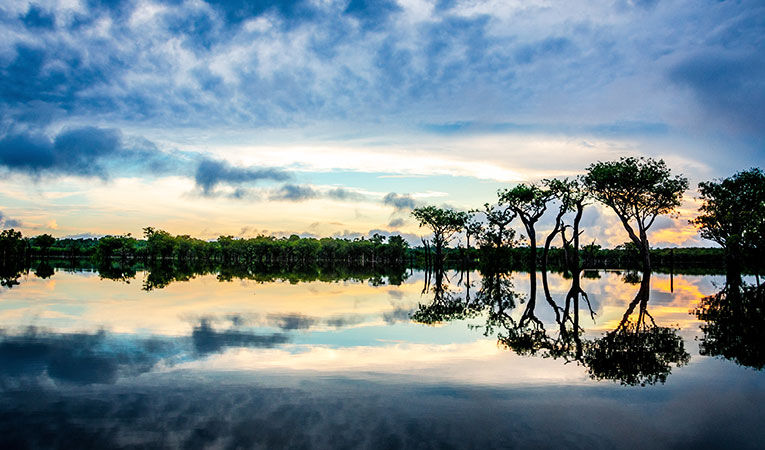
This is a once-in-a-lifetime event — enjoy every moment of responsibly visiting the Amazon Rainforest.
There are tons of awesome ways to visit the Amazon Rainforest! You can go on a tour with a local guide who can help you get the most out of your trip. You can amp things up and make it a river tour where you cruise down the Amazon river in style. There’s tons of volunteer tours where you can see the forest and make a difference in conservation efforts. You can even help rehabilitate the wildlife! The best Amazon tours all have amazing pros, so you really can’t go wrong.
Whatever ethical way of traveling you choose, you’ll love the Amazon! From lush forests to big woven roots, elephants to poison dart frogs, you’ll see amazing things. Basically, touring the Amazon guarantees that you’ll have an incredible and life-changing experience.
Look for the Perfect Adventure Travel Program Now
Related Articles
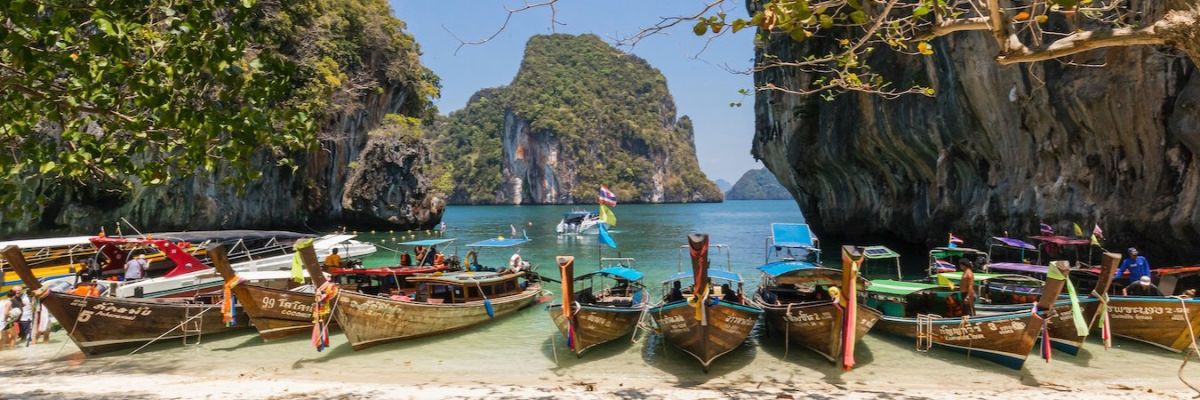
By Farryl Last | June 6, 2024

By Julia Zaremba | June 6, 2024

By Jacquie Truckey | June 6, 2024

By Steph Dyson | May 30, 2024

Popular Searches
Recommended programs.
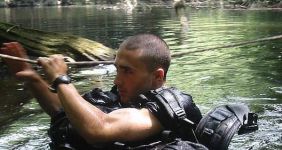
International Volunteer HQ [IVHQ]

Raleigh International
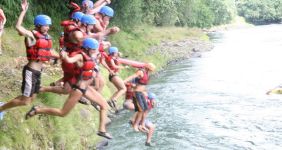
Outward Bound Costa Rica
Top Adventure Program Providers
Popular opportunities to check out
Join us on our exceptional photographic journeys with a do-good twist!
Come join us on the ultimate horseback holiday adventure, program fees from $180 join ivhq's incredible and affordable volunteer programs, join ethical small-group adventure tours in uganda, for travelers, travel resources, for partners.

© Copyright 1998 - 2024 GoAbroad.com ®
- Study Abroad
- Volunteer Abroad
- Intern Abroad
- Teach Abroad
- TEFL Courses
- Degrees Abroad
- High School Abroad
- Language Schools
- Jobs Abroad
- Online Study Abroad
- Online Volunteer Programs
- Online Internships
- Online Language Courses
- Online Teaching Jobs
- Online Jobs
- Online TEFL Courses
- Online Degree Programs
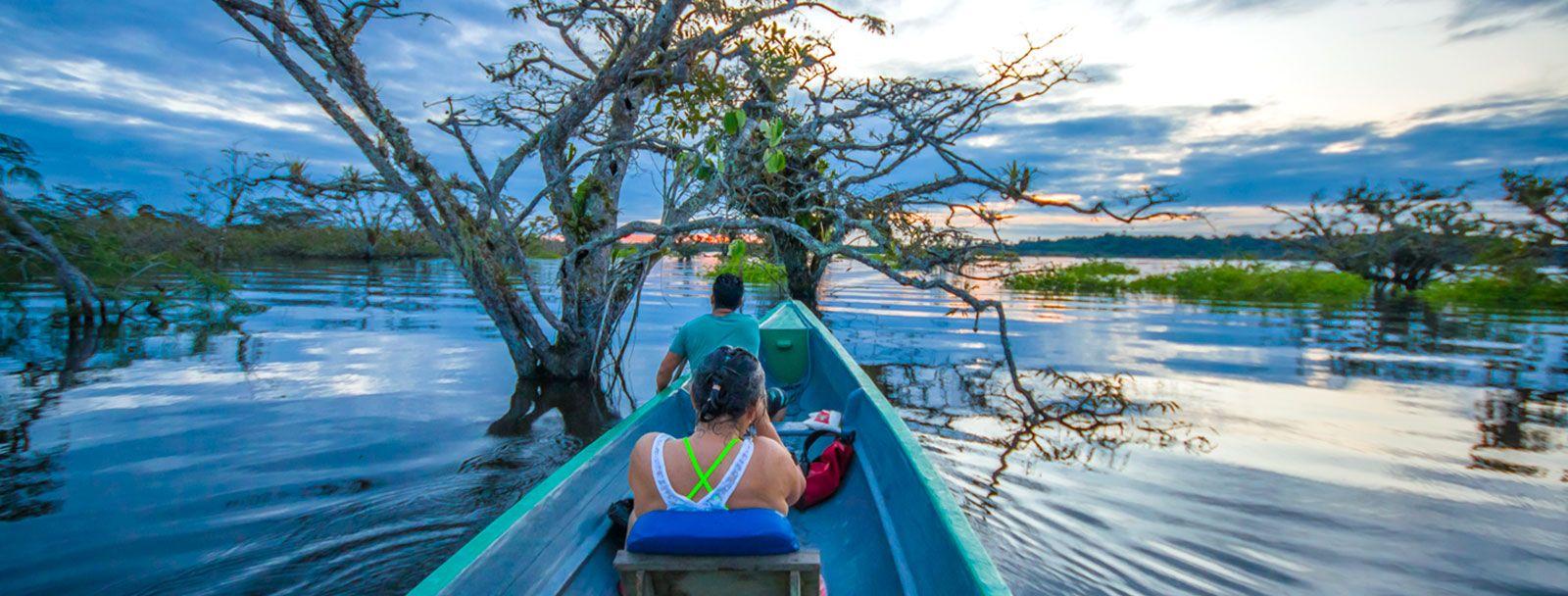
Amazon Rainforest
When it comes to nature and wildlife in Peru, the Amazon Rainforest is the place to be. The lush rainforest covers nearly two-thirds of the country, but is home to only 5 percent of its population. Adventurous travelers can explore this region with a professional guide at a jungle lodge. Cruise remote Amazonian waterways, make friends with local communities, swim with pink river dolphins, and walk under the canopy tree homes for flitting birds, snoozing sloths and swinging monkeys.
For nature lovers, a trip to Peru is not complete without exploring the largest rainforest in the world. Wherever you go, you’ll have a chance to spot wildlife, visit lush jungle lodges and participate in ecotourism. There are different highlights depending which part of the rainforest you visit.
Let’s explore the three most popular destinations in the Peruvian Amazon:
Puerto Maldonado
Why choose here? Puerto Maldonado is at the southern gateway to the Amazon jungle, with Madre de Dios River weaving through it. A visit to this region affords visitors with easy access to Tambopata National Reserve , a wide array of excellent jungle eco-lodges, and glimpses of oxbow lakes, macaws at clay licks, and maybe even a giant river otter. This part of the Amazon has Bolivia just to the east and Cusco to the west.
Why choose here? To the northeast of the country, you’ll find the very remote city of Iquitos deep in the Peruvian jungle and only accessible by flight. This is the easiest place to see the Amazon River in Peru, and it also offers quick access to the Pacaya-Samiria National Reserve. As Peru’s largest natural protected area, this is a wonderful place to spot monkeys, sloths and majestic pink river dolphins or have rich cultural experiences meeting those who call the reserve home.
Manu National Park
Why choose here? Manu National Park is a treasure in and of itself. Located between Puerto Maldanado and Machu Picchu, this is a wonderful spot for wildlife viewing, bird watching and river exploring on Manu River. Elevations in the park range from 500 to 14,000 ft (150-4,200 m) so you can see different biospheres from the forest floors to the mountain peaks. It’s a very unique place with a rich cultural heritage, where the Andes and the Amazon meet.
Peru Amazon Map
The jungle city of Puerto Maldonado represents a different side of Peru. Temperatures are warmer than in the frigid Andean highlands. Boats are the easiest mode of transportation. And the waterways provide entry into nature reserves where exuberant greenery flourishes and rare fauna frolics.
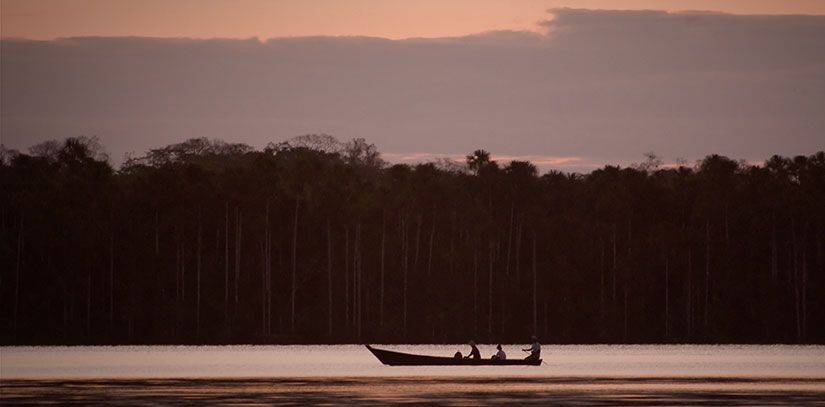
For a full jungle immersion, spend 2 or 3 or more nights at a rainforest lodge. By day, enjoy excursions along jungle trails, to the tops of canopy towers, and into the corners of hidden lagoons where caimans and otters and sometimes jaguars bathe in the sun. After dark, relax in a hammock rocked by a warm jungle breeze and marvel at the mysteries of the rainforest’s nocturnal world.
Best Time to Visit
Puerto Maldonado is broken up into a dry season (May-October) and a wet season (November-April). However, being that it is a tropical rainforest, even the dry season tends to have some rain. While many would opt for the drier season, in reality there are pros and cons of both.
Pros of the dry season are that trails are less muddy and there is a higher probability of seeing parrots and macaws at the clay licks. Cons of the dry season are hotter temperatures – and sunny days usually see less bird activity and amphibians can be harder to spot.
Pros of the wet season are that temporal wetlands make it easier to see reptiles and amphibians and there is a cooler temperature. Cons of the wet season are muddy conditions, less likely to see birds at the claylicks and a higher chance of flight delays.
Climate & Weather
The southern Peruvian Amazon rainforest climate is broken up into two distinct seasons: the dry season and the wet season.
May through October are usually the driest months in the Amazon. Between June to September there are periodic cold spells called friajes that can drop the temperature to 10°C (50°F) for a couple days at a time. Friajes are cold fronts the blow up from Patagonia and then whip down over the southern jungle from the Andes.
The Amazon is a rainforest, so really there's a chance of rain throughout the year. But more constant rains that define the region’s wet season begin in November and continue to April. November and December usually receive the most rainfall.
Jungle Immersion
Puerto Maldonado is the main hub for exploring the southern Peruvian Amazon where the Madre de Dios River intersects with the Tambopata. For a proper Amazon adventure introduction, hop aboard a wooden boat powered by a small motor in Puerto Maldonado and cruise winding Amazon waterways to your remote jungle lodge. Ecotourism is a cornerstone of the developing travel industry in Peru’s Amazon.
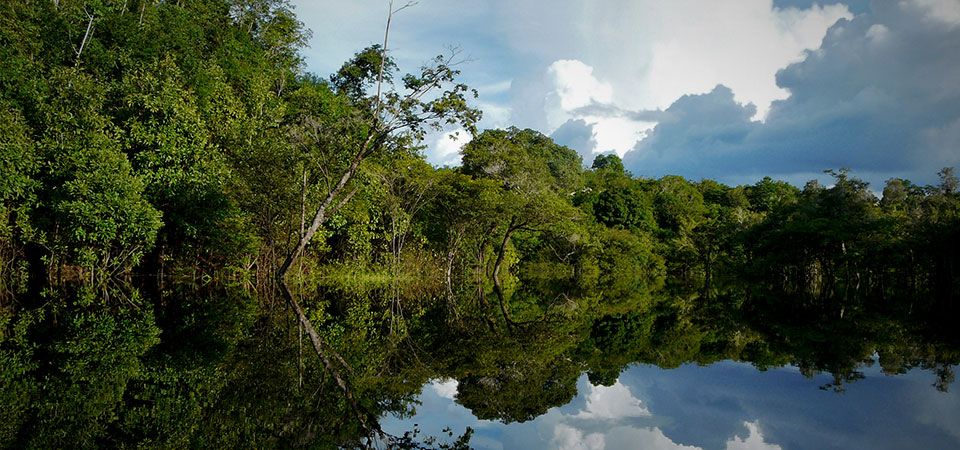
Our team proudly partners with lodges that practice low-ecological footprint programs (recycling, use biodegradable bath and cleaning products, utilize low-to-no energy devices). Jungle lodges not only help support native communities, but also help spread awareness about the continued need for conservation efforts amid the looming threats that cause irreversible damage.
National Parks
Tambopata National Reserve encompasses 275,000 hectares (680,000 acres) of protected Amazon rainforest in the southeastern part of Peru. A sanctuary of incredible biological diversity, the reserve features stunning Oxbow lakes and different forest habitats. More than 670 bird and 1,200 butterfly species join a long list of endangered animals, such as giant otters, harpy eagles, and jaguars, who call this place home. The reserve boasts numerous clay licks along exposed riverbanks where macaws and parrots congregate.
Bahauja-Sonene National Park hugs the southern part of the Tambopata National Reserve. The enormous 1 million hectare (2.47 million acre) park protects the country’s only tropical humid savanna and some of its most biodiverse tracts of rainforest. Access to Bahauja-Sonene National Park is very limited.
Intense Wild Diversity
Did you know that two-thirds of the world’s plant and animal species make their home in the rainforest? And new species are always being discovered! The Amazon is the largest rainforest on earth and its crazy cool biodiversity sparks a cord of fascination with almost every adventurous traveler!
From cute and fuzzy to downright bizarre, the critters of the Amazon are a major highlight of any jungle adventure! Howler monkeys swing overhead, families of 1.8-m (6-ft) giant otters make their homes in the Oxbow lakes, and three-toed sloths, when present, are hard to miss! Though rarely seen, even by long-stay researchers, endangered pumas and jaguars call these tropical forests home too. In southern Peru, the clay licks in the Tambopata and Manu national parks are privileges sites to observe a high diversity of rainbow colored macaws, parrots, and parakeets.
How to Get to Puerto Maldonado
- By Air: The Puerto Maldonado airport is small and a short drive from the town plaza. Flying is definitely the most convenient and time-saving transport option. LAN Airlines, Star Perú and TACA offer service to Puerto Maldonado. Flights are daily. A nonstop flight to Puerto Maldonado from Lima is 1 hour 30 minutes. Puerto Maldonado is a direct 55-minute flight from Cusco.
- By Road: The recently completed Transoceanic Highway now connects Cusco to Puerto Maldonado on a mostly comfortable, though winding, paved road. What was once an arduous 15-hour drive has been shaved down to about 10 hours. Taking the bus from Cusco to Puerto Maldonado is a good option for travelers with a longer, more flexible travel itinerary.
- By Boat: The waterways connect Puerto Maldonado to jungle lodges and remote indigenous communities.
Once you arrive in Puerto Maldonado, your tour guide will pick you up and guide you to the dock to board the open air boat to your jungle lodge. Usually around 1-3 hours to reach jungle lodges near Puerto Maldonado.
There’s plenty to see and do in the jungle city of Iquitos . Explore the local floating market at Belen. Sail to Isla de los Monos for fun with mischievous monkeys. Swim with dolphins. Wander the city seeking out the architectural legacy of the early 20th century rubber boom. Visit museums or book a tour to learn more about indigenous Amazonian cultures.
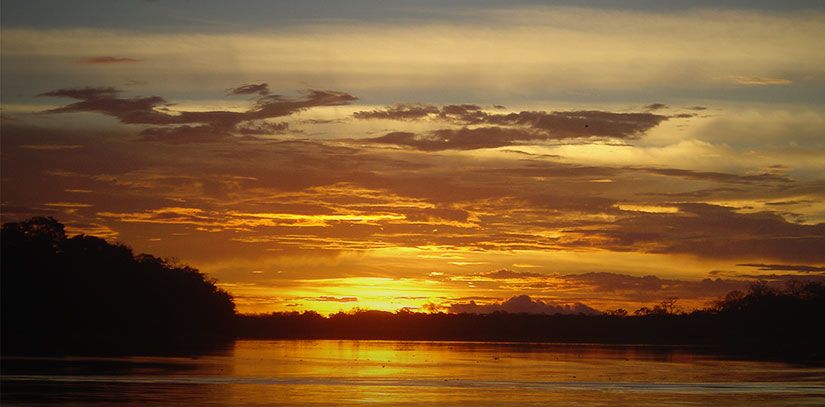
Away from the city, Iquitos provides access to excellent jungle lodges located up and down river. It’s also the point of departure for cruise ships destined for the Amazon headwaters.
Like any other area in the Amazon, the best time to visit the rainforest depends on your preference. The Amazon is a year round destination, with rainfall expected throughout the year. However, Iquitos is broken up into high water and lower water seasons, each of which have their pros and cons to consider.
Pros of high water season (December to May) is that it allows boats to venture deeper into remote parts of the jungle. During this time, you’re likely to see more birds and mammal species living in the canopy. Cons is that rainfall is usually heavier (December through March), there are generally more mosquitos, there aren’t as many usable hiking trails
Pros of low water season include more trails to explore the jungle on foot, fewer mosquitos, higher chance to see migratory birds and peak season for fishing. The main con of low water season is that remote lakes and small creeks (only accessed by boat) cannot be visited.
The Amazon experiences a warm, tropical climate with high humidity. Rainfall occurs throughout the year. Seasons in northern Peru’s Amazon Basin are divided between months with high water and low water. Water level of the rivers fluctuate as much as 12 meters (40 feet), resulting from the rain and snowmelt runoff flowing down from the eastern slopes of the Andes Mountains.
High Water Season
- When: December to May
- Daily Temperature Average: 30°C (86°F)
Low Water Season
- When: June to November
- Daily Temperature Average: 37°C (98°F), slightly warmer than the high water months
Amazon River
The Amazon River, or Rio Amazonas, is the second longest river in the world. The river and its tributaries wind through dense tropical jungle in Peru, Brazil, Bolivia, Ecuador, and Colombia. From the city of Iquitos, travelers can take a luxurious cruise on the mighty Amazon River, which flows across northern Peru, or stay at a jungle lodge along its shores. Water activities include wildlife spotting from a canoe, swimming with pink river dolphins, paddle boarding, and piranha fishing.
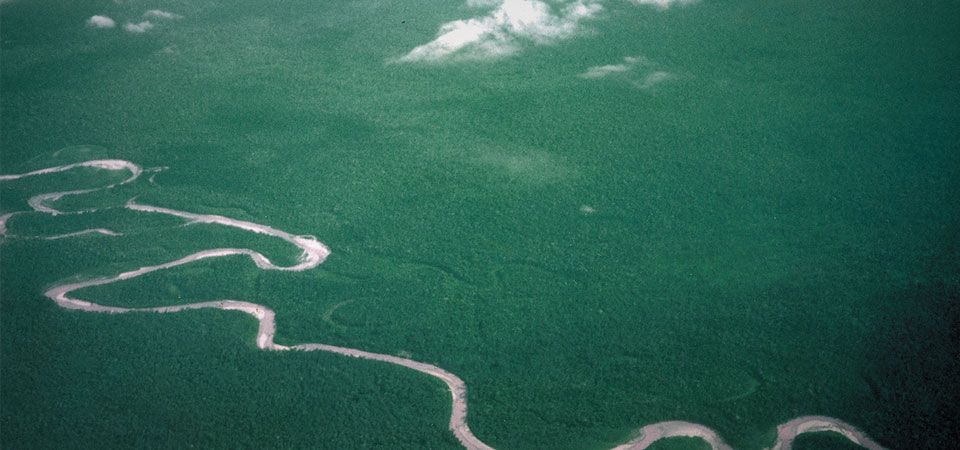
Amazon Cruise
Amazon cruise packages are generally more expensive than a jungle lodge stay, but the additional cost comes with definite perks, including luxury facilities and endless rainforest and river panoramas from your private cabin. Ask your travel advisor for more information about cruising the Amazon in style.
Wildlife Diversity
Life in the Amazon rainforest takes many forms below, within, and above its leafy green canopy. It is home to big-eyed monkeys rustling amid trees, bright bird species, stealthy river creatures and other ecological oddities. In northern Amazon tributaries, pink river dolphins are but one unique animal that can be spotted in the national parks surrounding Iquitos. Keep your eyes peeled and camera in hand because seeing these Amazon rainforest animals in their natural habitat may well be the highlight of your jungle adventure. Jungle lodges surrounding Iquitos are the perfect hub for convenient access to remote jungle reserves.
Things to Do

Experience Local Jungle Culture
Travel by boat from Iquitos to the Yaguas and Bora communities for a unique cultural experience. A guide from the community will explain the local way of life and the history. During a visit, the local men, women, and children share aspects of their culture, including language, dance traditions, and artistic expression, with visitors. Beautiful jewelry, weavings, and art pieces are made by local artisans and available for sale.

Stay at a Jungle Lodge
The best way to experience the stunning beauty of the Amazon rainforest and see wildlife is at a remote jungle lodge accessible by river boat from Iquitos. Don’t worry, you don’t have to sacrifice comfort to have a true jungle adventure! The jungle lodges recommended by our team have running water, cushioned beds, and serve tasty meals. See the Hotels section on this page for more information. During the day, explore the nearby national reserves on a variety of guided wildlife, canopy, walking, cultural, and river tours.

Wander the Streets of Iquitos
The city sprawls outward from the Plaza de Armas, surrounded by streets dominated by moto-taxis. The Iron House, located on a corner of the main plaza, and the numerous beautiful mansions lining the city’s riverfront malecon are evidence of the wealth brought to Iquitos during the rubber boom era. Visit one of the city’s museums for a dose of Amazon culture. During your city exploration, take a break in a shady seat at a local cafe or restaurant to soak in the energy of this busting jungle hub at a slower pace.

Explore the Belen Neighborhood of Iquitos
A tour to the shanty town of Belen market and its residential area offer travelers a truly unique cultural experience. Morning visits to the Belen market are the best because it’s less crowded. Your guide will point out exotic fruits and veggies used in jungle cuisine, and likely lead you down Shaman’s Alley, where medicinal and spiritual Amazon remedies are sold. Next, hire a boat or canoe and explore the waterways of the Belen neighborhood where houses are built on stilts over the Itaya River or on top of balsa wood rafts.
How to Get to Iquitos
- By Air: Flights to Iquitos touch down at the Coronel FAP Francisco Secada Vignetta International Airport serves Iquitos. The airport is located on the outskirts of the city, about 10 km (6 mi) southwest of the Plaza de Armas. Facilities include tourist shops, eateries, and ATM machines. LAN, Star Perú, and Peruvian Airlines offer daily flights to Iquitos. By plane, nonstop service from Lima to Iquitos takes 1 hour and 40 minutes.
- By Boat: The Amazon River and its waterways connect the city of Iquitos to jungle lodges and other small port towns in Peru's northern Loreto region.
- Iquitos is not accessible by road. Traveling to Iquitos by bus or car is NOT an option.
Once you arrive in Iquitos, your tour guide will pick you up and guide you to the dock to board the open air boat to your jungle lodge. Usually around 20 minutes to 1 hour to reach jungle lodges near Iquitos.
With elevations spanning between 150 m and 4,200 m of elevation, Manu National Park encompasses an astounding variety of climates and a bewildering number of plant and animal species. So many, in fact, that researchers continue to find undiscovered flora and fauna even after decades of intensive research. Accessible from Cusco and from Puerto Maldonado , Manu and its handful of lodges provide a chance to experience a wonderland of habitats from cloud forest to lowland rainforest in a setting unlike any other in Peru or the world.

Keep in mind that this is the rainforest and showers are possible at any time of year. Officially, the rainy season is from December to March. May to August is comparatively drier, though also much warmer.
Manu’s extreme topography creates multiple microclimates. Lower elevation areas are hotter with average temperatures ranging from 35 C during the day to 25 C at night. In Manu’s higher elevation areas, temperatures are generally cooler. Expect warm temperatures during the day and cool nights.
Temperatures can drop after heavy rains, reaching as low as 10 C (50 F). Another weather phenomenon, called “surazo” or “friaje,” occurs when polar winds from Patagonia sweep up the mountains and into the rainforest. Temperatures can be as low as 8 C (46 F).
Manu National Park Facts
- covers entire Manu River basin
- spans eastern Andes mountains (cloud forest) and Amazon basin (tropical lowland rainforest)
- 2,000 to 5,000 species of plants, including 250 species of trees
- more than 1,000 vertebrate species including 200 species of mammals and 850 species of birds, 68 species of reptiles, 77 species of amphibians
- 1,300 recorded species of butterflies
- 13 species of primates
- rare species: giant otter, giant armadillo, jaguars, puma, Andean mountain cat
- pre-Inca and Inca ruins and petroglyphs indicate long history of indigenous settlement
- small communities of the Matsigenga Amazonian tribal group, largely along the Manú River or one of its main tributaries

Manu Biosphere Reserve
The Manu Biosphere Reserve is divided into 3 zones:
- Parque Nacional Manu (Zone A) – the core and largest zone. Access is highly restricted. Within this area, Cocha Cashu Biological Station is an important site for tropical rainforest research center.
- Reserved Zone (Zone B) – the Buffer Zone set aside for research and tourism. Located mainly within lowland rainforest, it harbors diverse microclimates and quantities of flora and fauna by the side of rivers and cochas (lagoons formed in the bends of rivers) as well as clay licks.
- Cultural Zone (Zone C) – the Transitional Zone with small settlements of indigenous people. Allows organized visits with guides. Restrictions in place to protect animal and vegetable life.
Paucartambo
Located 2.5 to 3 hours from Cusco, Paucartambo is a point of transit on the overland route between the imperial Inca city and Manu National Park. Paucartambo is also famous for a 5-day festival in mid-July that draws revelers from all over the region in celebration of the Virgen del Carmen Festival.
Kosñipata River Valley
From Paucartambo, continuing past Acjanaco Pass (12,630 ft / 3,850 m) and the turnoff to Tres Cruces, the road begins its ascent into the gorgeous Kosñipata Valley dropping thousands of meters in elevation. This the place to go for river rafting and mountain biking tours through Peru’s gorgeous cloud forest mountains. It’s also the route to rainforest lodges in Manu including Paradise Lodge, Gallito de las Rocas Lodge, and Erika Lodge. The Quechua word kosñipata means “place of smoke” in reference to the heavy mists that shroud the eastern flanks of the Andes as they plummet to meet the Amazon.

Located at the meeting point of the Madre de Dios and the Manu river, the village of Boca Manu has a small airport that receives charter airplanes. It’s also a stop on the route over land and by boat from Puerto Maldonado. The checkpoint to go further into the park is in nearby Limonal.
Things To Do in Manu National Park
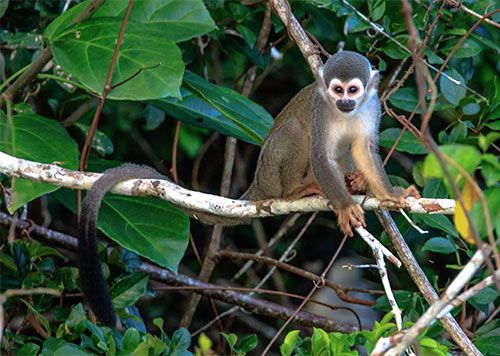
Wildlife Spotting
Monkeys, bugs, and reptiles abound in the rainforest. If you’re lucky, you might also see the otorongo (jaguar), black panther, tapir, collared peccary, deer, and capybara. Forest trails and cochas (secluded lagoons) are the best place to spot wildlife while learning about life in the rainforest, medicinal plants and food.
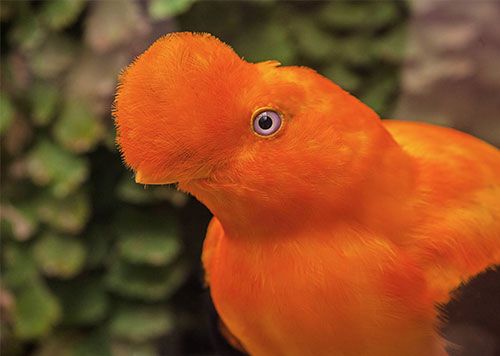
Bird Watching
Many travelers come to Manu specifically for the birds. And with one of the largest bird lists in the world, Manu certainly merits such a specific interest. Airborne residents include the harpy eagle, jabiru, roseate spoonbill, and the cock of the rock.
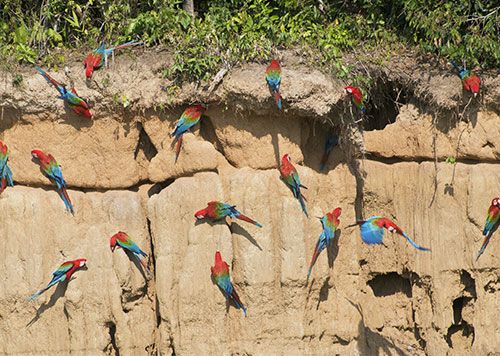
Special attraction in Manu where travelers can see macaws, parrots, and parakeets flock by the thousands for morning meals of clay.

Canopy Towers
See the rainforest from the perspective of creatures who live at canopy level. Scattered tree towers in Manu range from 30-40 meters (100-130 feet) tall. Standing on the platform reveals a alternate dimension of rainforest activity that can’t be seen from the forest floor.

Tres Cruces Lookout Point
An additional 60km from Paucartambo, Mirador Tres Cruces is a lookout point over the meeting place of the Andes and the Amazon. On clear days, it’s possible to see the peak of the massive Ausangate all the way down into the depths on the jungle basin.
How to Get to Manu National Park
There are three routes to get to Manu:
- From Cusco: by car to Paucartambo, through the Kosnipata Valley to the Manu River
- From Puerto Maldonado: by car to Santa Rosa Village 2.5 hours, cross Inambari River to Puerto Carlos, to Boca Colorado 45 minutes, up Madre de Dios river.
- To Boca Manu: charter flights land at small airstrip, river transport to lodge.
Travel Tips
What to Pack
For a jungle tour, it is important to pack light and bring only the necessary equipment and clothing. Space on the river boat to your lodge is limited.
- Shirts and pants made of light, breathable material
- Long pants and shirts to keep insects off (made of light, quick-dry material)
- Loungewear for the lodge
- Comfortable, closed shoes – sticky, slippery, sometimes muddy rainforest trails make sandals and heels impractical
- Water resistant shoes (especially during the wet season)
- Insect repellant
- Sun protection (hat, sunblock, glasses)
- Reusable water bottle
- Cellphone. You won’t have service at your lodge, but good to have at airport and for photos if you don’t have a camera.
- Local currency for small purchases and tips
- Head lamp (and extra batteries, just in case).
- Water-resistant binoculars are an added plus.
Wifi Access
Not all jungle lodges have WiFi, so if this is a necessity of yours, you will want to check with your travel advisor or directly with the lodge before traveling. However, even if WiFi is available, it is usually spotty and slow. A visit to the Amazon is more of an “off-the-grid” kind of experience. To keep your loved ones in the know, simply inform them of which days you’ll be in the jungle and alert them to the possibility that you will have little to no service.
Safety Tips
Most of your free time will be in the comfort of the grounds of your lodge. If out on an excursion, be sure not to wander off but rather to stay with the group. It is best not the wander off alone at night, as it is, in fact, a jungle with potential of confronting a range of wild animals. Be sure to have a reusable water bottle with you for day trips and hikes.
For travel to tropical forest regions, the US Travel Advisory recommends malaria medication and the yellow fever vaccine. Talk with your doctor before a trip to the Amazon in Peru to discuss the best option for you.
Protect yourself from the itchy bites of mosquitoes by wearing loose fitting long shirts and pants. Apply insect repellant to exposed skin. At night, use the mosquito net hanging over your bed.
Amazon Wildlife
Guided excursions into the Amazon rainforest to spot unique animals are included in a stay at almost every jungle lodge in the Iquitos region. Naturalist guides point out unique wildlife, and teach you how to observe them without disturbing them or possible endangering yourself. Stay on designated footpaths and do not get separated from your tour group.
Drinking Water
Bottled water and safe filtered drinking water are provided to jungle lodge guests. A reusable water bottle is always handy in the jungle.
Getting to your lodge
Many jungle lodges are only accessible by river transport. In Iquitos and Puerto Maldonado, lodge representatives greet travelers at the airport and then accompany them all the way into the jungle. River boats are typically open-air with a covering, much like a pontoon boat.
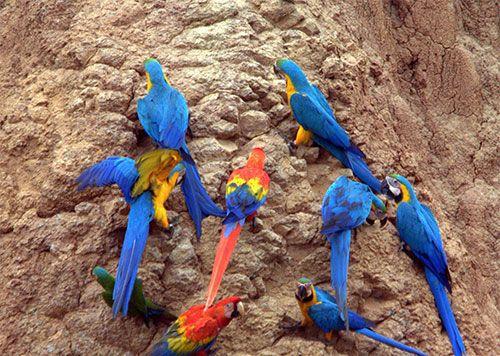
Oxbow Lakes
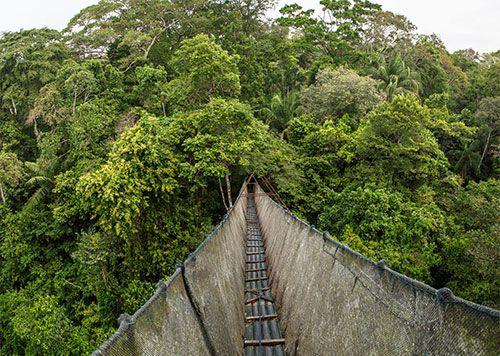
Canopy Tour
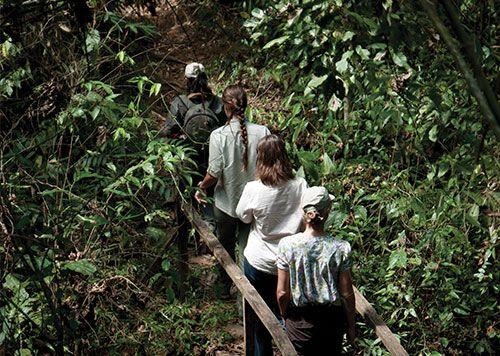
Jungle Walk
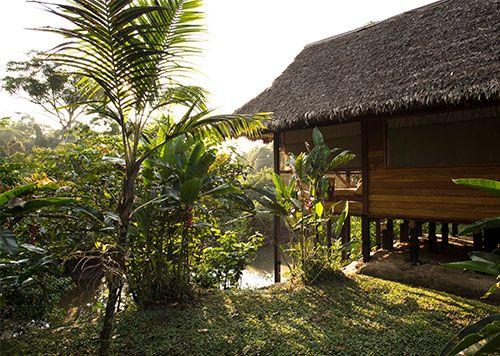
Local Community Visit
Many jungle lodges work closely with local communities. Posada Amazonas is a popular jungle lodge near the Tambopata National Reserve that’s owned in partnership between the native Ese’eja community and Rainforest Expeditions. Visiting a local farm or traditional community clinic offers great insight to how locals live in harmony with the Amazon.

Inkaterra Reserva Amazonica
Situated about 45 minutes by boat from Puerto Maldonado
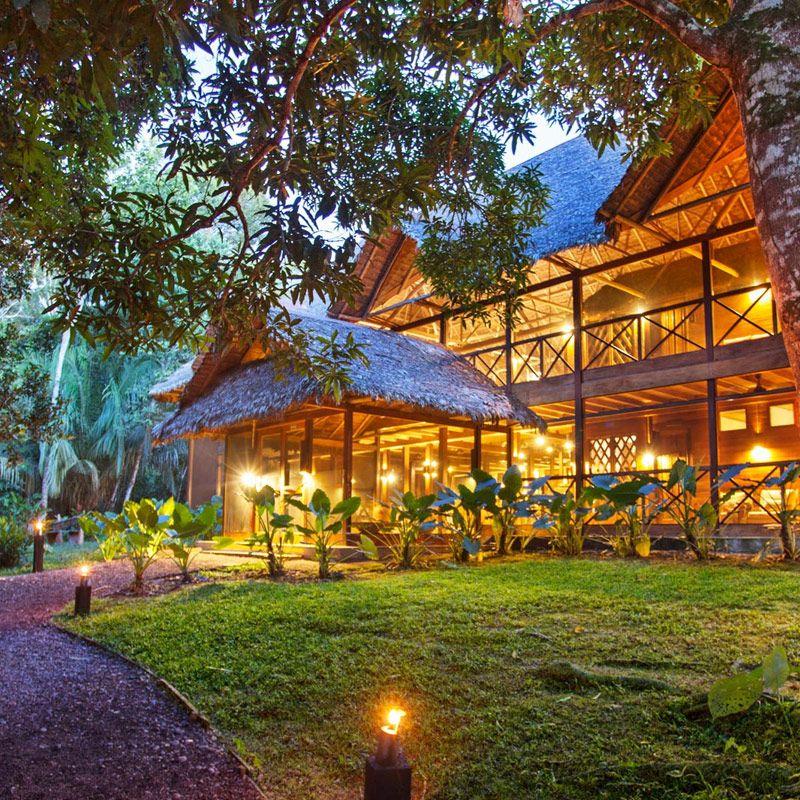
Inkaterra Hacienda Concepcion
Situated about 25 minutes by boat from Puerto Maldonado

Eco Amazonia
Situated about a 2-hour transfer (drive + boat) from Puerto Maldonado
Tour Packages
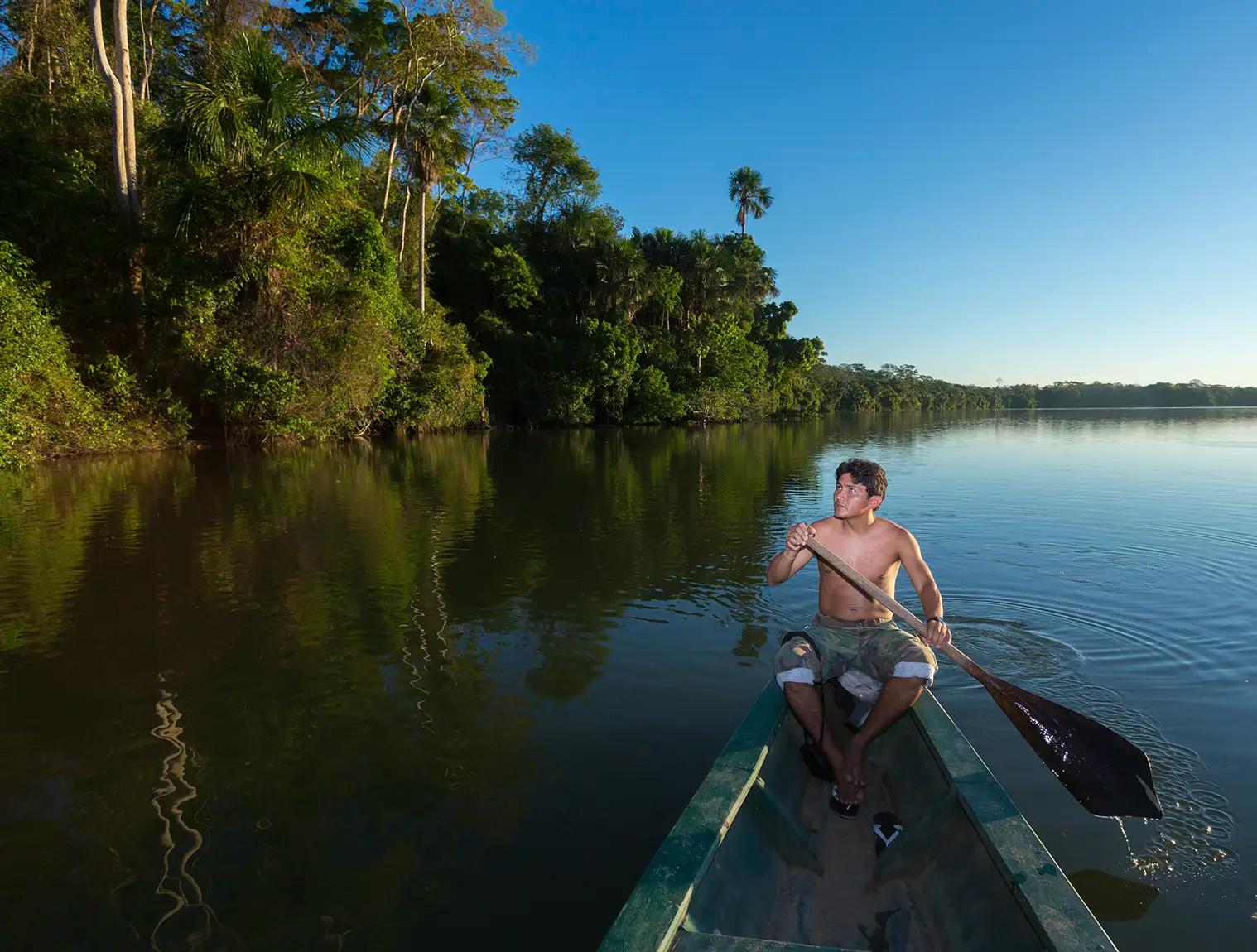
9 days from $ 1919
Amazon, Cusco, Sacred Valley and Machu Picchu
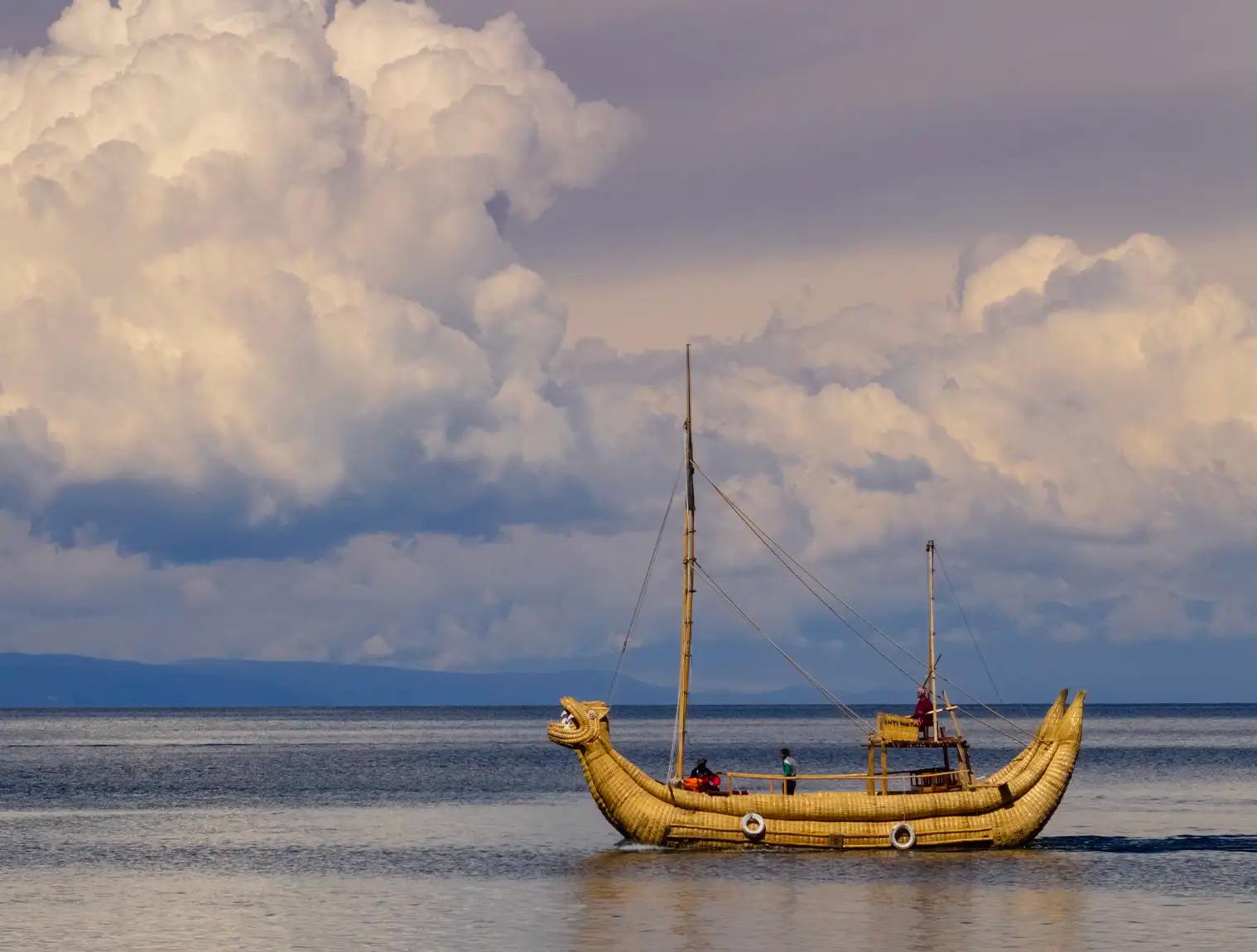
11 days from $ 2379
Amazon, Cusco, Machu Picchu & Titicaca
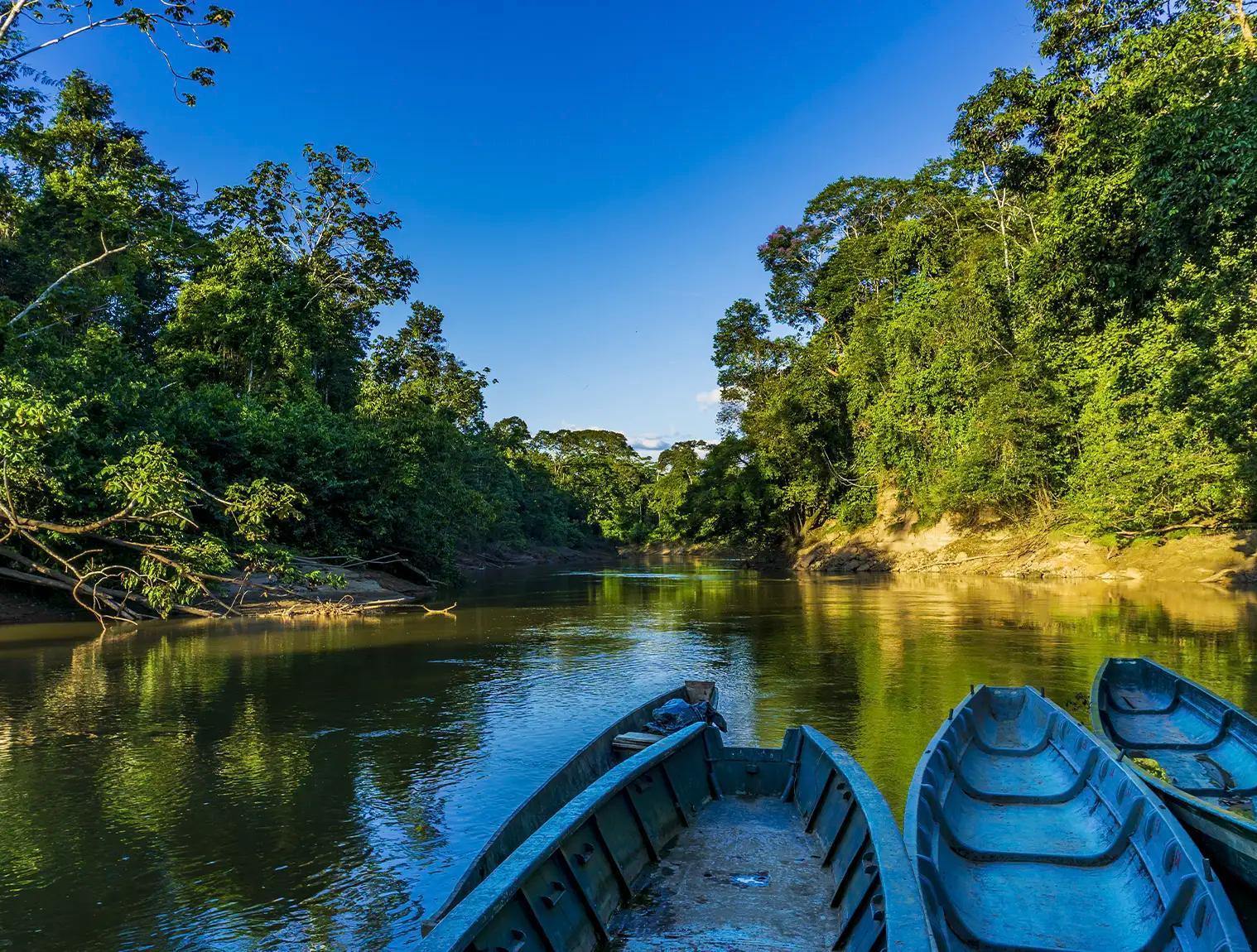
12 days from $ 2549
Machu Picchu, Sacred Valley, Cusco, Amazon, Arequipa & Colca Canyon
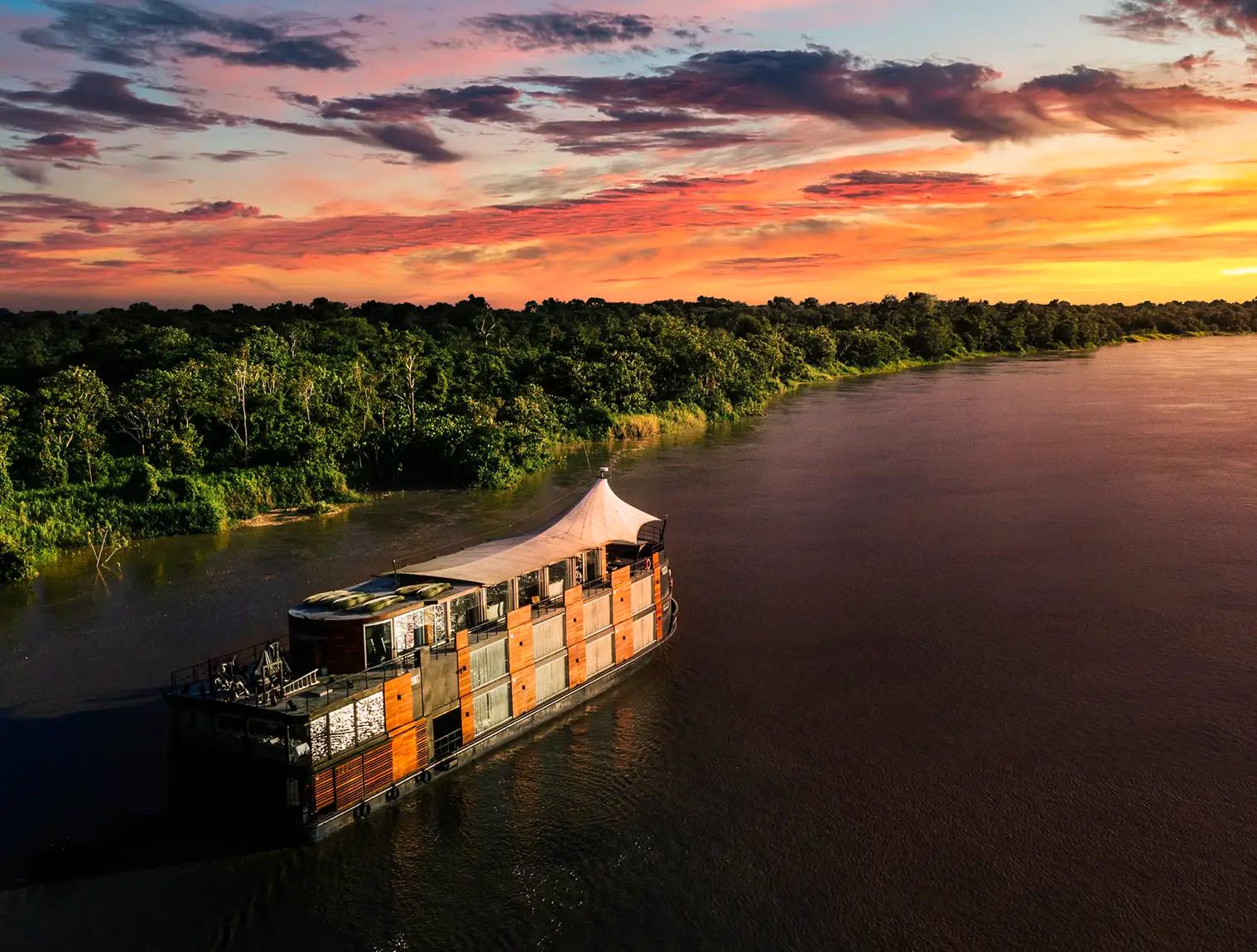
9 days from $ 3649
Cusco, Sacred Valley, Machu Picchu, Lima & Amazon Cruise
Is the Amazon Rainforest worth visiting?
Where is the amazon rainforest, when is the best time to visit the amazon, how big is the amazon rainforest, how much of the amazon is in peru, which is better – manu or tambopata or iquitos, is the peruvian amazon safe, do i need any vaccines before i travel to the amazon in peru, what is it like to stay at a jungle lodge, what’s the best way to protect myself from mosquitoes in the jungle, what animals live in the amazon rainforest.

Book With Confidence
We're flexible! Postpone your tour with zero cost up to 10 days prior to departure.
Email: [email protected]
Sign up to receive our newsletter for great articles, stunning photos, and special deals.
1-817-230-4971
Sales & travel support
14 Things To Know Before Visiting The Amazon Rainforest

Your changes have been saved
Email is sent
Email has already been sent
Please verify your email address.
You’ve reached your account maximum for followed topics.
10 Scenic, But Underrated Mountain Towns That Are Great Alternatives To Aspen
9 scenic, but underrated casino cities that are great alternatives to las vegas, 10 small towns to retire in florida, ranked by cost of living, read update.
The Amazon rainforest is the largest jungle in the world, covering 5.5 million square kilometers . This mesmerizing piece of heaven is crossed by the Amazon River, the largest lowland in Latin America . There are thousands of species of plants and wildlife and millions of insects! So there is a lot to learn before visiting the Amazon rainforest, especially to help tourists keep safe and prepared. Therefore, it is very important for visitors to know about the following things before heading to the Amazon rainforest.
UPDATE: 2023/04/17 14:28 EST BY MARIA BOU INK
What is better than reconnecting with Mother Nature and taking a few days to explore the splendid Amazon, the largest rainforest in the world? However, some tourists avoid it due because some areas are dangerous. Therefore, this list was updated to add more things to know before visiting the Amazon rainforest, so tourists can properly plan their vacation and have the safest trip ever!
Related: 10 Interesting Details About Bolivia's Amazon Forest
14 Phone Signal Coverage
Before tourists enter the Amazon rainforest, they should know that there is no phone service or WiFi. Although almost all smartphones, including iPhones, function flawlessly in Peruvian cities, tourists will probably only get a weak signal in the Amazon, and that is for the best, so they can soak up the whole beauty of their surroundings.
13 Wildlife Sighting
Each tour in the Amazon is unique by itself. It is impossible to have two Peruvian Amazon expeditions with the same animal encounters due to the habitat's incredible biological diversity, which includes thousands of distinct varieties of blooming plants and butterflies, as well as hundreds of birds, fish, mammals, etc. If tourists have some patience and binoculars, they might be able to regularly see macaws, sloths, howler monkeys, and pink dolphins when visiting the Amazon rainforest.
12 How To Get There
The huge rainforest is spread throughout nine nations in South America, including Bolivia, Brazil, Colombia, Ecuador, and Peru. However, Brazil is where it is most noticeable and popular . Each country offers a unique way to visit the Amazon rainforest and learn about it . If considering a trip to the Amazon of Peru, tourists should head to Cusco, from where flights may be scheduled to Iquitos, Puerto Maldonado. If they are interested in visiting the Brazilian Amazon, they should take a flight into Manaus in the north. If they want to see the Ecuadorian Amazon, they may take a five-hour bus ride from Quito to Tena City, where they can board a pickup truck. They may also take a 45-minute flight from La Paz to Rurrenabaque and then take a motorboat upriver to Madidi if they are anxious to experience the Bolivian Amazon.
11 Spoken Language
The majority of people working in the tourism sector are English-speaking, but if tourists want to communicate with people in the villages, they will need to practice their best Spanish. If tourists are not familiar with the romance dialect, they may download Google Translate's Spanish language package before traveling to use it offline and on days without WiFi.
10 Vaccinations
Before visiting the rainforest, all travelers will need to make sure to get a full set of vaccinations to prevent many common diseases, including malaria, meningitis, rabies, and many more. If tourists catch these diseases, they can develop serious problems and become ill. Being in a jungle, there will be limited facilities for medical and urgent transport. Therefore, for safe traveling to the Amazon, it is better to be well-prepared!
RELATED: Explore Malaysia's Tropical Rainforests On These Expeditions
9 Eating And Drinking
Tourists need to make sure they only drink bottled water and nothing from the tap or a source from the forest. Foreigners often don’t have the ability to handle different bacteria which can be present in the water. Eating food from the streets here is not recommended as the Amazon has unique bacteria which will cause fevers and an upset stomach.
8 What To Wear
When in the Jungle, tourists need to prepare and always cover their skin to protect from the bites, and stings from the insects that are here as well as rashes caused by the many plants; trousers, and a long sleeve T-shirt will be fine. A very good pair of waterproof boots are essential for exploring the forest, and it is suggested to always check boots before putting them back on as poisonous creatures can hide in them. Always tuck the cuffs of the trousers to reject pests from crawling up.
7 Mosquitoes
The rainforest is full of insects, including mosquitoes which can be quite dangerous to humans and is the main reason why all tourists need to make sure they are vaccinated. Mosquitoes are known for carrying and passing harmful diseases which is why visitors should be prepared. Tourists should pack mosquito repellent and keep this topped up and sprayed all over, and sleep in a mosquito net to avoid the insects biting and stinging the skin.
RELATED: Osa Peninsula: Visiting The Last Remaining Lowland Rainforests In Central America
6 What To Take
There are many things tourists should pack for their visit to the Amazon rainforest, but the most important things include a hat to avoid sunstroke. Additionally, hiking boots are essential. Sunscreen is needed and will need to be reapplied constantly to avoid burning. Bug spray is recommended to keep bugs away, but sometimes they still get to the skin and bite or sting, so after a bite, lotion should be packed too, along with a flashlight which will really come in handy as there is no electricity in the rainforest.
5 The Best Time To Go
The Amazon jungle can be visited all year round, and the weather never really changes, with it usually just being warm, humid, and rainy. The wet season is from January to June, and rain showers happen daily during this time which makes it feel cooler, but river levels are higher and it will be harder to get around and explore, unlike the dry season, which stretches from July to December.
- Best time: Dry season
4 Where To Stay
The most used accommodation in the Amazon rainforest is the jungle lodges . They usually include single or shared rooms with en-suite bathrooms, and rooms are usually accommodated with mosquito nets and sprays which is a big bonus! Another option is to stay on a riverboat or cruise where tourists can sleep onboard instead of inside the jungle, and these last around 10 days. Tourists can also spend their night at a treehouse in the heart of the Amazon .
- Lodges: Sani Lodge, Ecuador; Cristalino Jungle Lodge, Brazil; Refugio Amazonas, Peru; etc.
RELATED: There's An Entire Rainforest Inside Of This Vietnam Cave, And It's Worth Touring
3 Tips For Exploring
Tourists should always make sure to pick up any rubbish they have and never leave it lying around the Amazon rainforest! They should also respect that they are in the home of all the wildlife there and should keep a good distance from them, especially the dangerous and poisonous ones. Tourists should always carry a water bottle that can be filled up and taken along when exploring, and most importantly, they should always listen to the guide and follow the routes they suggest to stay extra safe.
2 How Long To Go
The Amazon Jungle has a lot to be explored; tourists can decide to stay in one place or explore different parts each day. About one week is enough time for a trip here; this would leave around two to three days for traveling and five days for exploring and activities. To walk around the whole of the jungle would take 869 days! So tourists should choose wisely about how to spend their trip.
1 What To Do
There are so many choices of activities, things to see, and places to explore in the Amazon jungle, which is the largest jungle in the world. A long jungle walk is one of the top things to do here since it is full of wildlife and greenery to admire and explore. Tourists can also go on a kayak down the Amazon River and spot all the marine life too. There is also a very high canopy bridge here, which is an exciting experience; tourists can walk across and see all the beautiful scenery below them. Additionally, they can book tours to have the ultimate experience.
- Destinations
5 Best Places To Visit The Amazon Jungle To See Wildlife

Introduction
Welcome to Aventuras Naturales, your go-to source for an extraordinary wildlife experience in the Amazon jungle. If you are a nature enthusiast, this comprehensive guide will showcase the top 5 places to visit in the Amazon rainforest where you can witness diverse and thriving wildlife in their natural habitats.
1. Yasuni National Park
Yasuni National Park, known as one of the most biodiverse places on the planet, offers unparalleled opportunities to spot incredible wildlife species. Explore the dense jungles and rivers as you encounter playful monkeys swinging through the treetops, colorful macaws soaring overhead, and fascinating pink river dolphins gracefully swimming in the water.
2. Manu National Park
Venture into the remote corners of Manu National Park, a UNESCO World Heritage Site, for an authentic Amazonian experience. Immerse yourself in the untouched wilderness as you navigate the winding trails, encountering elusive jaguars, giant river otters, and iconic anacondas. Marvel at the mesmerizing sight of vibrant parrots taking flight from the ancient trees.
3. Tambopata National Reserve
Tambopata National Reserve, home to astonishing biodiversity, presents an incredible opportunity to witness the wonders of the Amazon rainforest. Embark on an unforgettable journey through the dense vegetation, where you can spot unique wildlife such as the charismatic giant river otters, capybaras, and exotic bird species like the stunning toucans and vibrant morpho butterflies.
Iquitos, the largest city in the Peruvian Amazon, serves as the gateway to the Amazon rainforest. Explore the surrounding areas on a guided expedition, where you can encounter Amazonian pink river dolphins, playful squirrel monkeys, and incredible birdlife including the striking harpy eagle and the elusive hoatzin. Immerse yourself in the local culture and experience the rich biodiversity this vibrant city has to offer.
5. Cuyabeno Wildlife Reserve
Nestled within the heart of the Amazon rainforest, Cuyabeno Wildlife Reserve is a hidden gem that offers an extraordinary wildlife experience. Explore the winding black-water rivers by canoe, and keep your eyes peeled for fascinating creatures such as caimans, giant anacondas, and elusive jaguars. Marvel at the breathtaking sight of colorful bird species like the vibrant Amazonian parrots and the striking roseate spoonbills.
Aventuras Naturales, a trusted name in travel and tourism, provides exceptional guided tours to these top 5 places in the Amazon jungle. Whether you are an avid wildlife enthusiast or simply looking to awe-inspiring natural beauty, our expert local guides and extensive knowledge of the region will ensure an unparalleled experience. Immerse yourself in the marvels of the Amazon rainforest, witness its thriving wildlife, and create memories that will last a lifetime.

Where To Stay In Manaus: The Best Hotels - A Comprehensive Guide

Top 7 Blue Footed Booby Facts
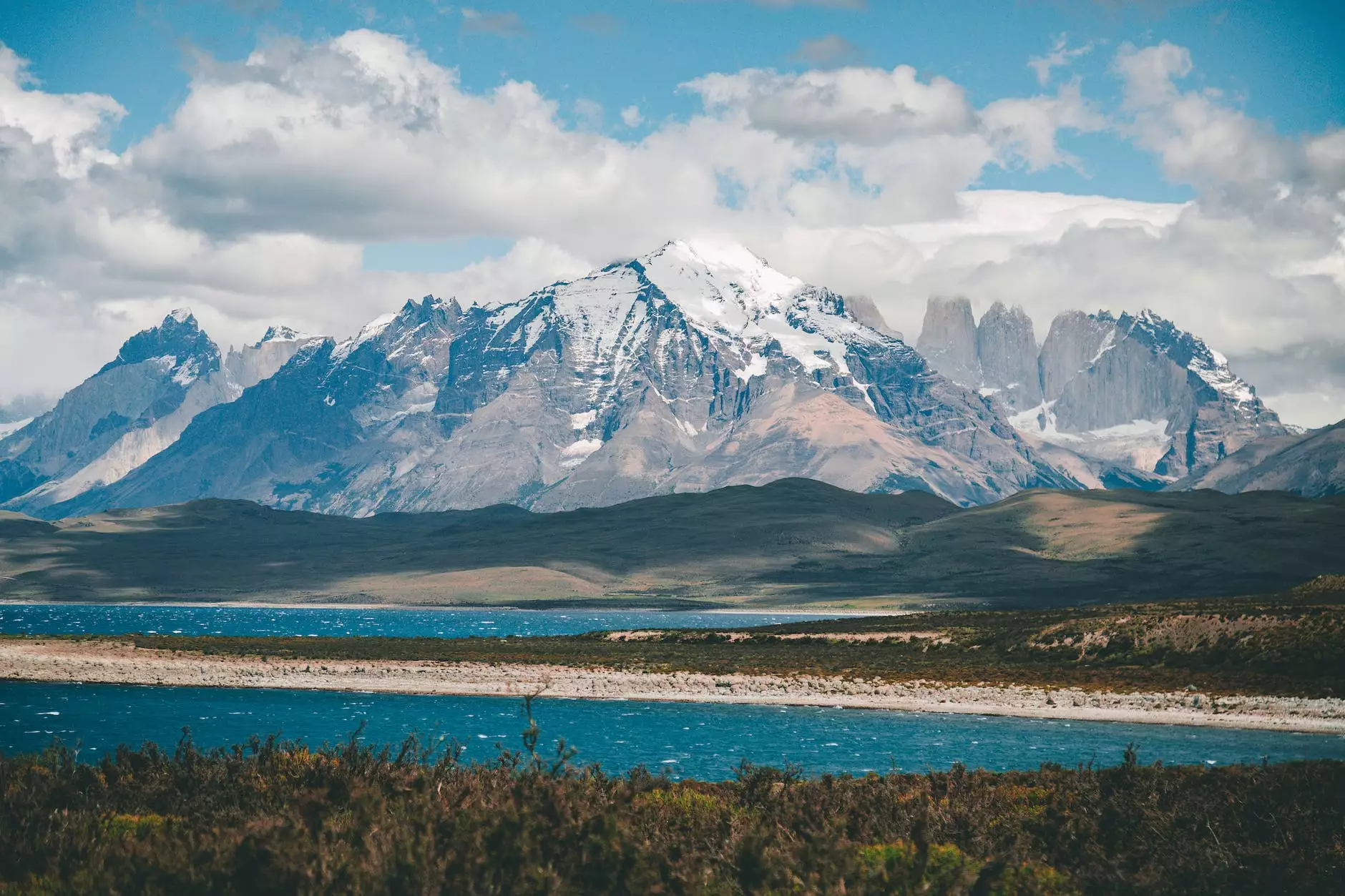
Explora Torres Del Paine - Salto Chico Hotel 2023/24
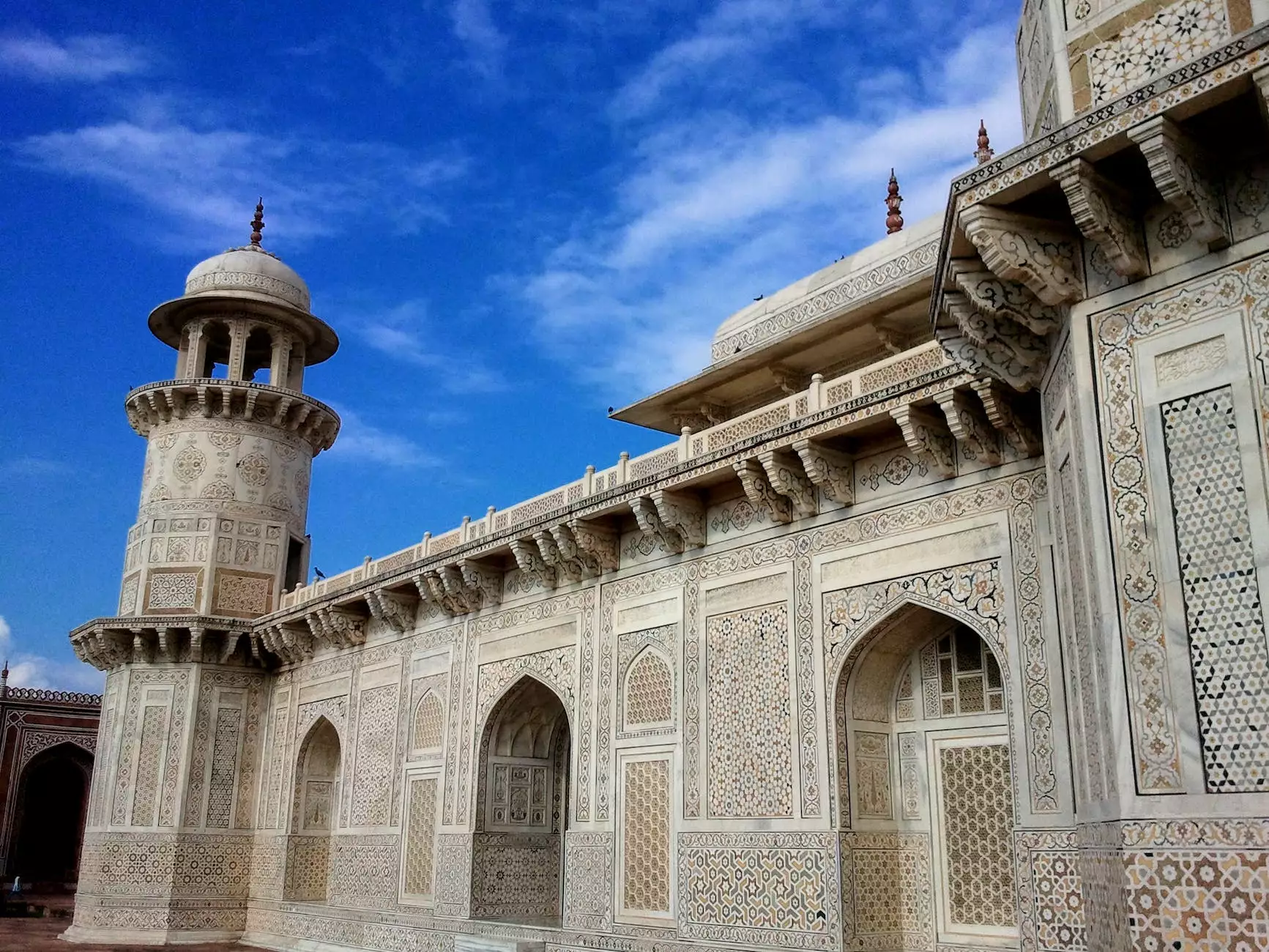
A Guide To The Top Vietnam War Sites - Rainforest Cruises
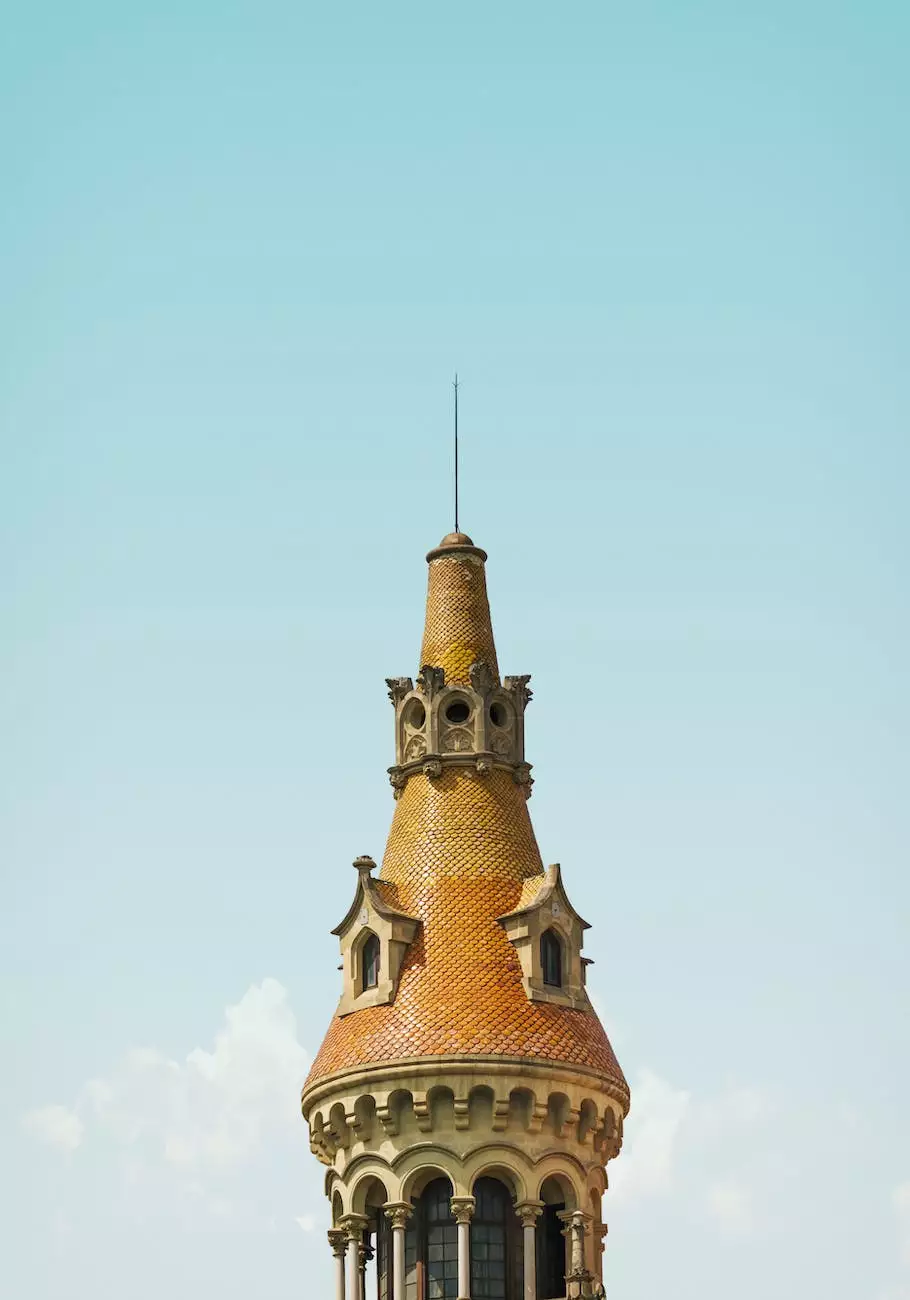
10 Best Tourist Attractions In Thailand You Have To See

The Story Of Juliane Koepcke: Surviving The Amazon
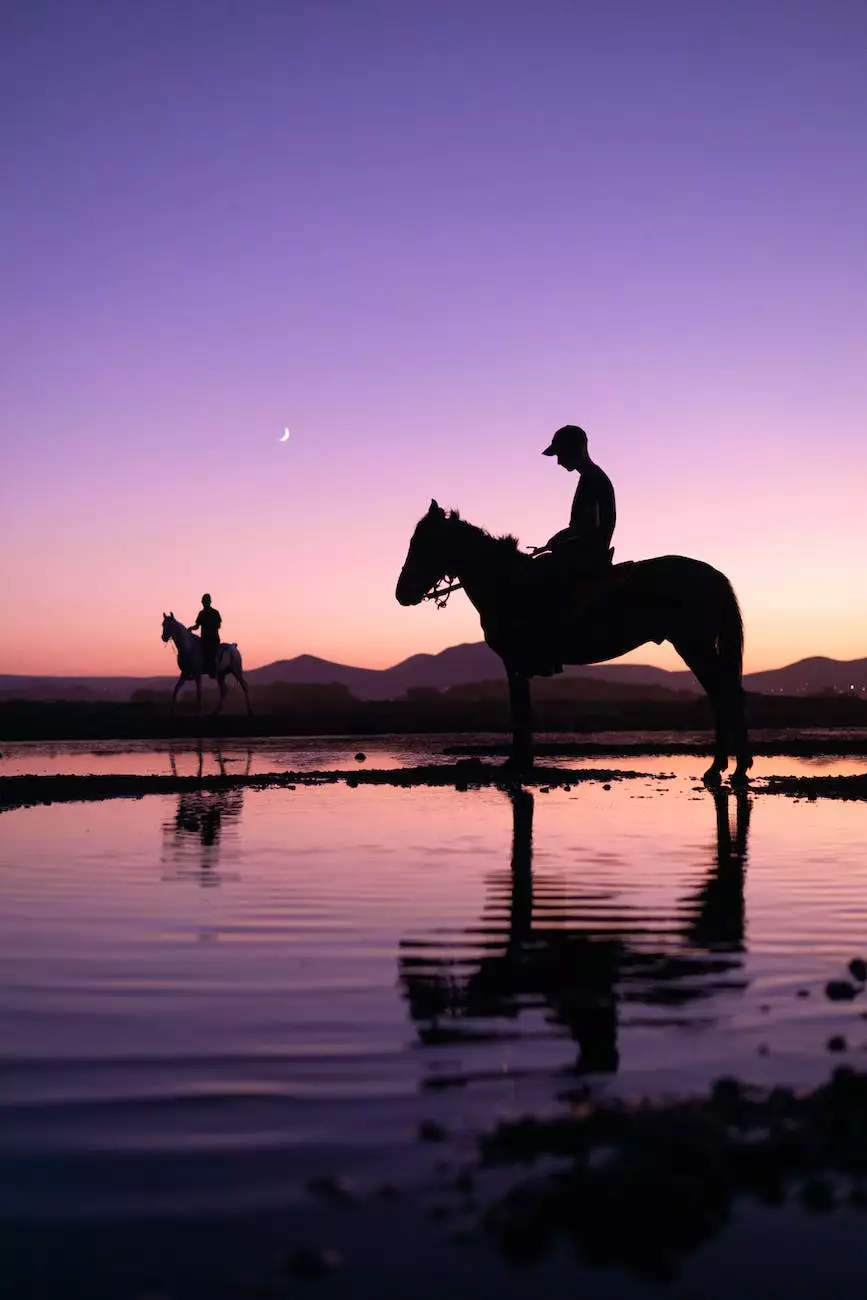
A Guide To Tonle Sap Lake
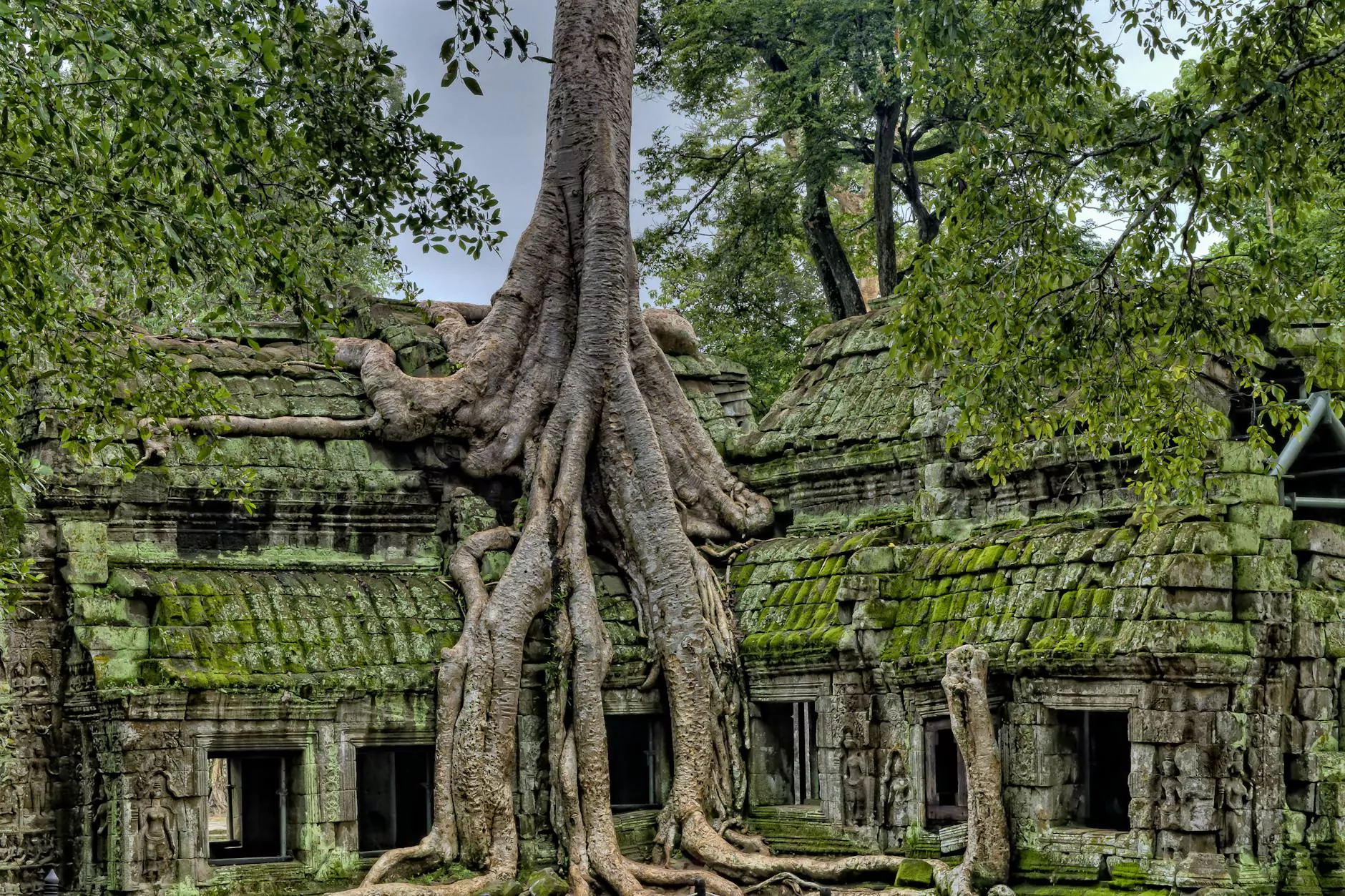
10 Best Peru World Heritage Sites

Welcome to Aventuras Naturales

The Coolest Plants In The Amazon Rainforest

- Amazon River
- Galápagos Islands
- Indonesian Archipelago
- Mekong River
- Irrawaddy River
- India Cruises
- Pacific Coast
- Patagonia Cruises
- Machu Picchu
- Iguazu Falls
- Amazon Travel Guide
11 Tourist Attractions In The Amazon Rainforest You Must See

When it comes to untouched nature in a wildlife-rich environment, the Amazon Rainforest is one of the last places on earth to explore. Even hearing the word Amazon conjures up images of exotic landscapes and menacing animals, yet the mystery of it all can be explored by anyone and in different ways. Whether you are seeking a family vacation spot , a unique honeymoon , or looking for something new to do as a couple, a trip to the Amazon Rainforest will undoubtedly become a trip of a lifetime.
Choose to embark on an Amazon River cruise into the far reaches of the rainforest or experience luxury at an exciting jungle lodge. Enjoy Amazon River attractions or explore towns and unique architecture from the past rubber boom in the area. With its lush flora and fauna and incredible wildlife, it’s no wonder that people are choosing to vacation in this remote landscape in South America. Whether you choose to explore the parts located in Peru, Brazil, Ecuador, or Bolivia, you’ll revel in the surroundings of this adventurous locale.
Here are 11 Amazon Rainforest tourist attractions to add to your must-see itinerary.
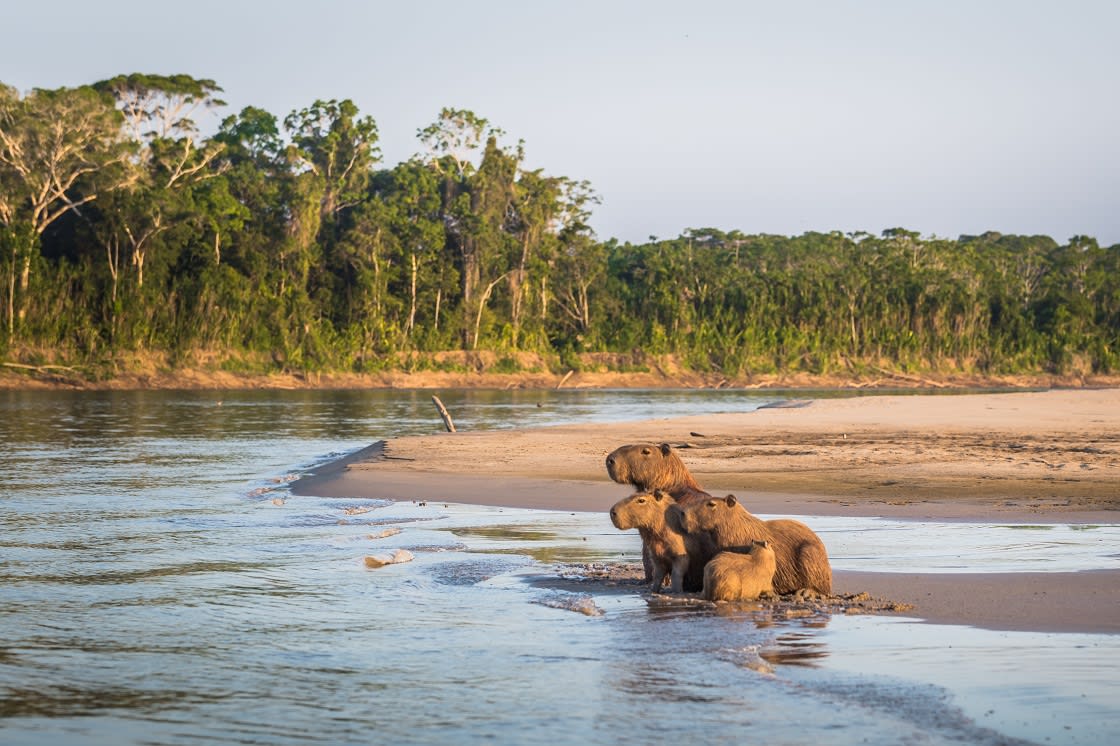
Family Of Capybara, Manu Natural Park
1. Manu National Park (Peru)
Located in the Amazon of southeastern Peru, the Manu National Park is a designated UNESCO World Heritage Site . This park, also called the Manu Biosphere Reserve, is chock full of amazing wildlife, including giant otters, wattled jacanas, jaguars, and various monkeys. It is also home to some 20,000 plant species, including significant water lilies. If you’re a birdwatcher, this is the place to be to admire tanagers, macaws, and toucans. You may also encounter a hoatzin, an odd bird unique to the Amazon.

Plaza De Armas In Iquitos
2. Plaza de Armas de Iquitos
In addition to exceptional wildlife viewing, you can also explore the towns within the Amazon. Head to the port city of Iquitos in Peru for a fascinating visit, including a stroll around the Plaza de Armas. This busy central plaza sits among European-styled buildings built during the historic rubber boom. Relax here in between your trips to the jungle and shopping along with the open-street markets. Sit beside the fountain, admire the public garden, enjoy the shade of a palm tree, or check out the monument to those Peruvians who died during the 1879-83 Pacific War.

Cloud Reflects Over Pucate River In The Pacaya Samiria Reserve, Peru
3. Pacaya Samiria National Reserve
Explore what it feels like to be enveloped in a jungle canopy at the Pacaya Samiria National Reserve in Peru. Wildlife lives in the tops of the trees here, and you’ll be able to get a closer look at them. If you’re feeling particularly brave or looking to experience an extra thrill, make your way across the La Posado canopy bridge for a spectacular view of this diverse ecosystem.
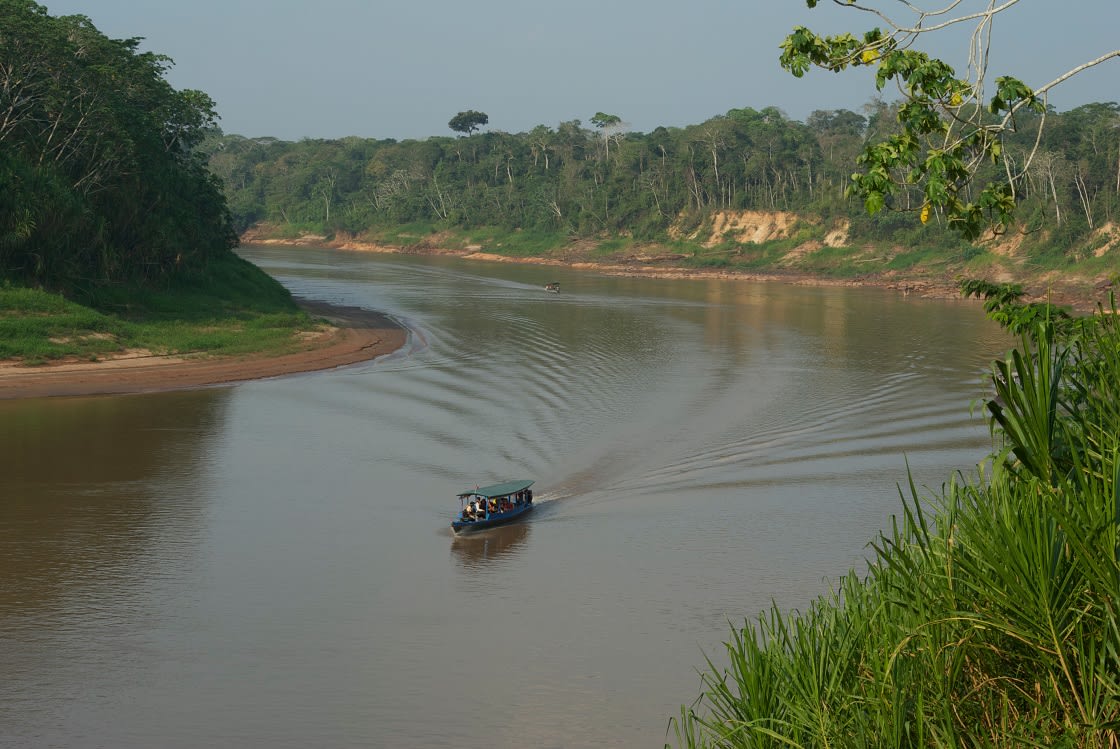
Boat Sailing On The Tambopata Natural Park, Peru
4. Tambopata National Reserve
For a study in the plant life of Amazonia, head to the Tambopata National Reserve inside Peru. Here you’ll stand in awe of the 50-meter tall Ceiba tree, the 40-meter-high Brazil Nut tree, and the ironwood trees that are 500 years old. Stroll along the well-marked trails as your guide reveals details of the various plant life located underneath the jungle canopy. Take your time admiring the delicate orchids, grassy ferns, vibrant bromeliads, and various twisting and tangled vines. You can access the reserve from the city of Puerto Maldonado in the southeastern part of Peru.

Forest Trees Are Mirrored In The Waters Of The Sandoval Lake
5. Sandoval Lake
Located inside the Tambopata National Reserve is Sandoval Lake, an oxbow lake of profound beauty. An oxbow lake is a spot where a river ran in one direction then switched to the other direction, leaving behind an arc shape which then fills up with water to create a lake. Wildlife flocks to these lakes, and you’re sure to see a variety of fascinating ones during your visit. Laugh at the antics of the giant otters. See how many kinds of monkeys you can find on the lake’s edge, including capuchins, squirrel monkeys, and the rambunctious howlers. Gaze at the strange hoatzin birds and look within the waters for the huge Arapaima fish.
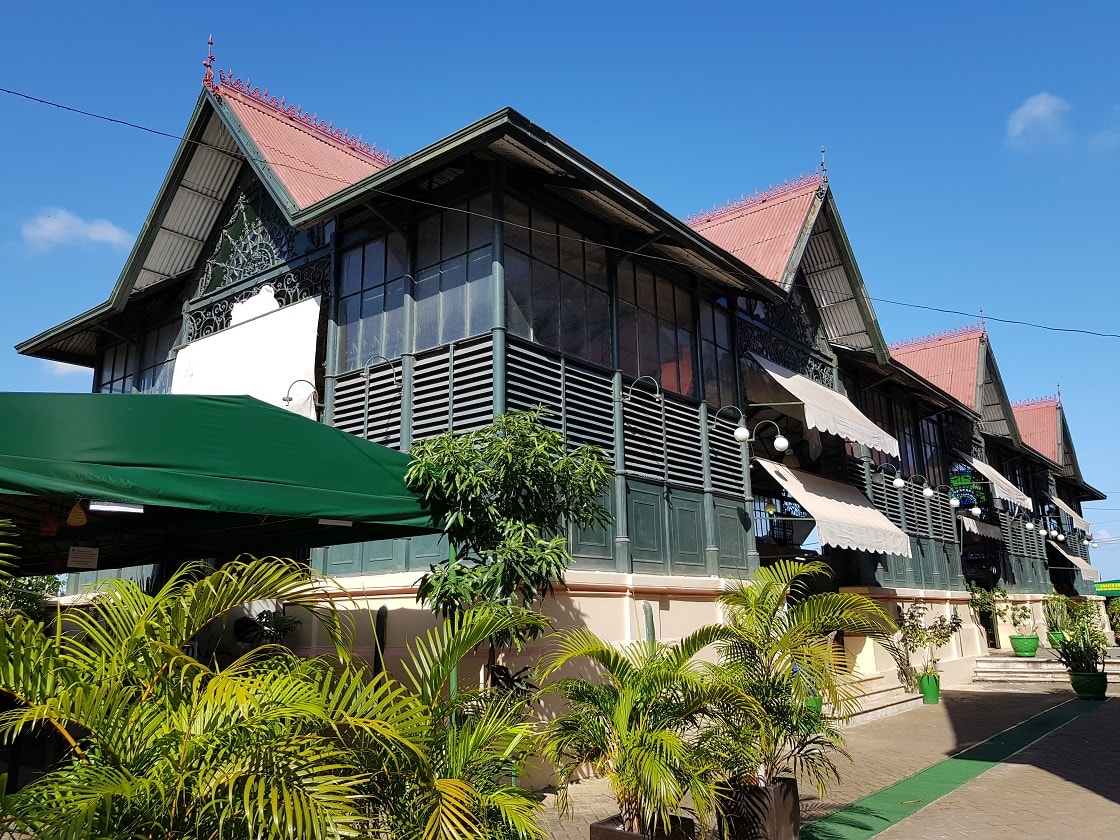
The Mercado Adolpho Lisboa, Also Called Mercado Municipal
6. Mercado Adolpho Lisboa
Located on the Rio Negro riverbanks in Brazil, the Mercado Adolpho Lisboa, or Municipal Market, will delight those enthralled by European architecture. Constructed during the Amazonian rubber boom, the interior of the building is characteristic of the Brazilian Amazon, a contrast that works well. Located in the port city of Manaus , this main market sells everything from local produce to Indio-handicrafts to Amazonian medicines.

Amazon Theater Manaus, Brazil
7. Teatro Amazonas
Also located in Manaus is the Teatro Amazonas. Known as the Manaus Opera House, this Belle Epoque-style building is a delightful surprise. Surrounded by the thick Amazon Rainforest, it may seem a confusing contrast but one not to be missed. Enter inside and be inspired by its hundreds of Italian chandeliers and European charm. Learn about its history on a tour and maybe even catch a concert. The Amazon Philharmonic orchestra calls it home, and an annual film festival is also held here.

The Palácio Rio Negro Was Built In 1910
8. Palácio Rio Negro
The last site you might expect to see in the mysterious Amazon is a palace. Yet, there is one. Built as the residency of Karl Waldemar Scholz, a German rubber tycoon, today it is a Brazilian Amazon cultural center containing performance spaces and galleries. Wander through its fine art gallery or the unique coin museum. Join a docent-led tour to fully grasp the history of the location.

Tourist Watching The Beauty Of IRacema Waterfall
9. Cachoeira de Iracema Waterfall
Deep within the Brazilian rainforest, you’ll find thundering waterfalls descending from up above and creating awe-inspiring pools below. This area is known as the Land of Waterfalls, or Terra de Cachoeiras. One waterfall in particular to visit is the Iracema Waterfall. Hire a guide and head into the forest to explore along the Urubui River before reaching the Iracema, where you’ll catch glimpses of the indigenous wildlife there. At the bottom of this waterfall, you can cool off and relax in the shallow waters. You also might enjoy exploring the sandstone caves nearby. A truly astounding ecological adventure, you’ll be glad you came.
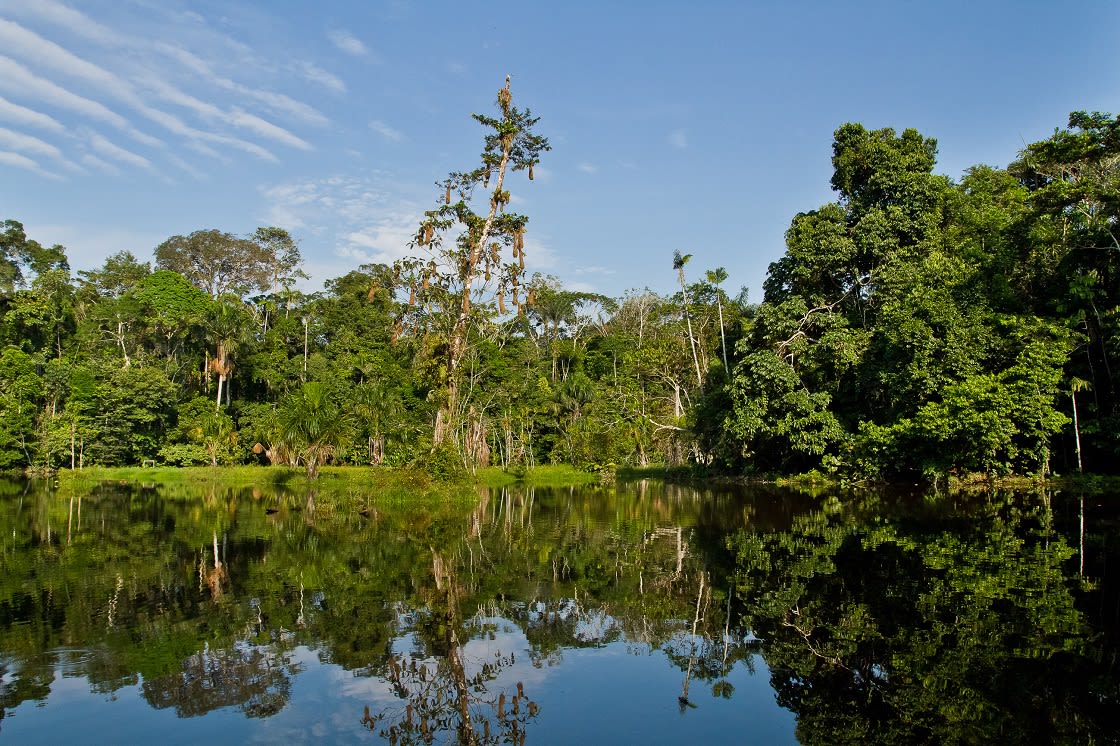
Beautiful Green Landscape Of The Yasuni National Park
10. Yasuni National Park and Biosphere Reserve
Explore the protected environment of the Yasuni National Park and Biosphere Reserve in the Ecuadorian Amazon. Claimed to be the most biologically diverse location on the planet, it is home to a high number of amphibians, reptiles, birdlife, and mammals, as well as plant life. Within its parameters flow various rivers, including the Tiputini and Cononaco, on which you can explore by canoe. You may also catch sight of caimans, anacondas, and dolphins along the way. For a truly unique experience, check out the clay licks where lively macaws and parrots return again and again. Clay licks serve as a way for animals and birds to neutralize the toxic foods they eat with salts and other chemicals found in these licks and also top many travelers’ list of best Amazon rainforest attractions to see.

Local Tour Guide In Madidi National Park, Bolivia
11. Madidi National Park
Part of the largest protected area on earth, Madidi National Park is the jungle jewel of Bolivia and one of the top Amazon River tourist attractions. Its biodiversity is astounding and home to a wide variety of wildlife. In birds alone, there are 1,254 different species and most likely many more not yet discovered. Indigenous people also live here in their own communities in this park, and you may interact with some of them on your visit.
Planning your trip to the Amazon is an adventure in itself. And, once you arrive, what you find may entice you to return again and again. These 11 must-see attractions are a great way to start.
While Rainforest Cruises aim to provide accurate and up-to-date information, we make no representations as to the accuracy or completeness of any information herein or found by following any link on this site. Rainforest Cruises cannot and will not accept responsibility for any omissions or inaccuracies, or for any consequences arising therefrom, including any losses, injuries, or damages resulting from the display or use of this information.
You may also like
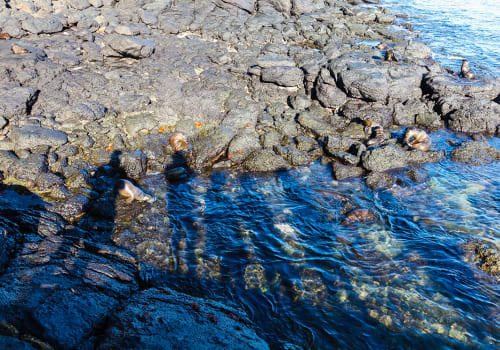
Protecting The Galapagos Islands: Key Conservation Projects
The Galapagos Islands have been protected under a national park status since 1961, but what exactly does that mean? How many creatures are still endangered on the islands and what are the […]
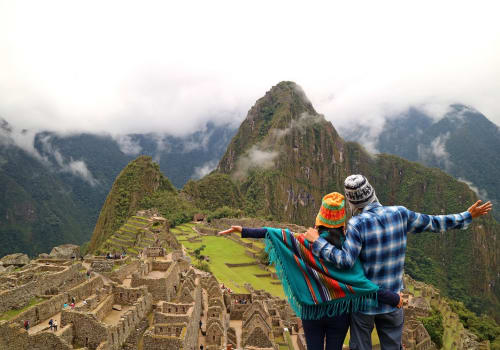
Machu Picchu Honeymoon: A Romantic’s Guide To The Ruins
Congratulations! You are married and now ready to set off on your Machu Picchu honeymoon. Your honeymoon to Machu Picchu will have you surrounded by mountainous landscapes, which offer the perfect romantic […]
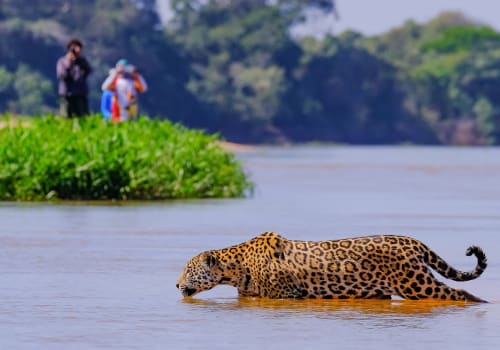
Best Places To Visit In The Pantanal To See Wildlife
One of the largest, most pristine, and most biologically vibrant wetlands in the world, the Pantanal offers South America’s all-around best wildlife-viewing opportunities. The “Kingdom of Waters,” as it’s sometimes called, easily […]
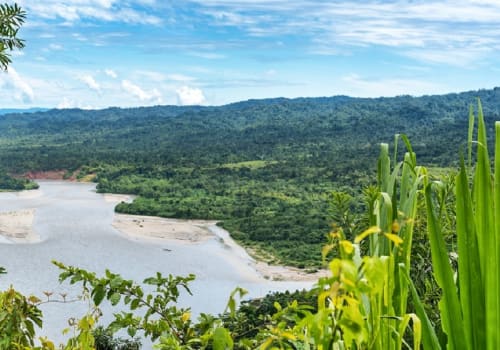
5 Best Places To Visit The Amazon Jungle To See Wildlife
One simply runs out of superlatives describing the rainforest of the Amazon Basin (the so-called “Amazon jungle” of popular conception). About the size of the conterminous United States, this biggest river basin […]
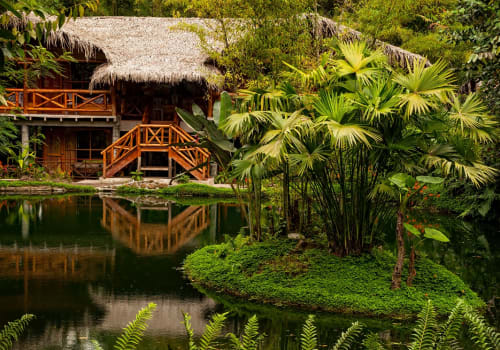
8 Luxury Amazon Rainforest Hotels: Where To Stay In The Amazon
The Amazon Rainforest is by far one of the most mysterious and exciting locales to visit in all of South America. Teeming with abundant wildlife, exotic trees and plants, and even indigenous […]
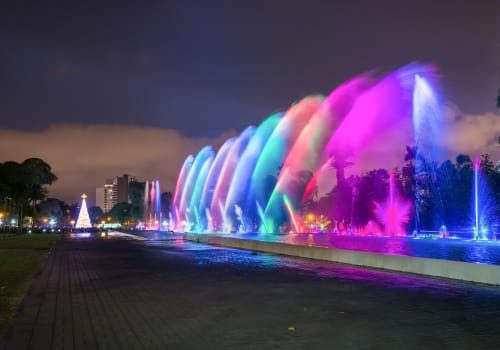
11 Top-Rated Peru Tourist Attractions To Visit
When it comes to discovering the history, culture, and natural features of South America, one country in particular offers all three and so much more. Located on the west coast of the […]
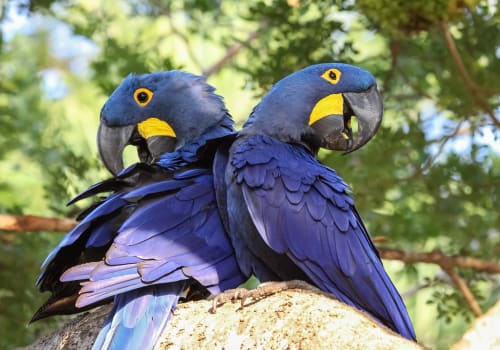
Pantanal Honeymoon | Lodges & Itinerary Ideas For Lovers
Are you looking for a honeymoon destination full of romance and adventure at the same time? Perhaps one in a remote location in a South American country full of different landscapes and […]
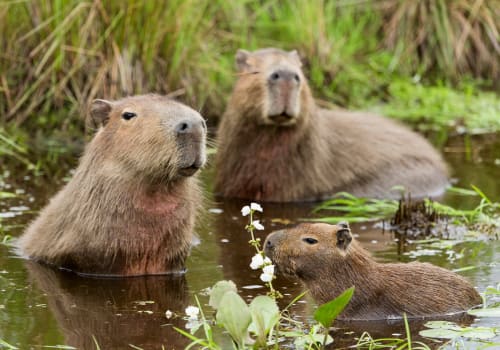
Pantanal Family Travel: Top 7 Things To Do With Kids
If you’re looking for a new destination for your family vacation this year, why not consider one of the most remote and naturally unique regions in all of South America? The Pantanal […]
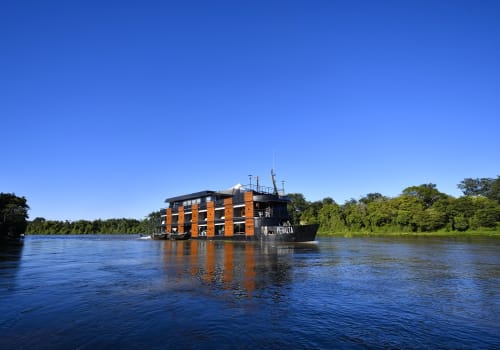
Where To Stay In The Pantanal
While exploring the Pantanal wetlands region in Brazil, where you lay your head at night is an important decision to make. While you may worry your options are limited, consider that several […]
On the Lookout for Expert Advice & Offers?
Join over 20,000 discerning travelers and be the first to receive our monthly exclusive discounts, inspiring travel content and expert tips, straight to your inbox.

- Charter (Private)

DEAL FLASH: 30% Off + Free Flights For 4-Day Thanksgiving Departure
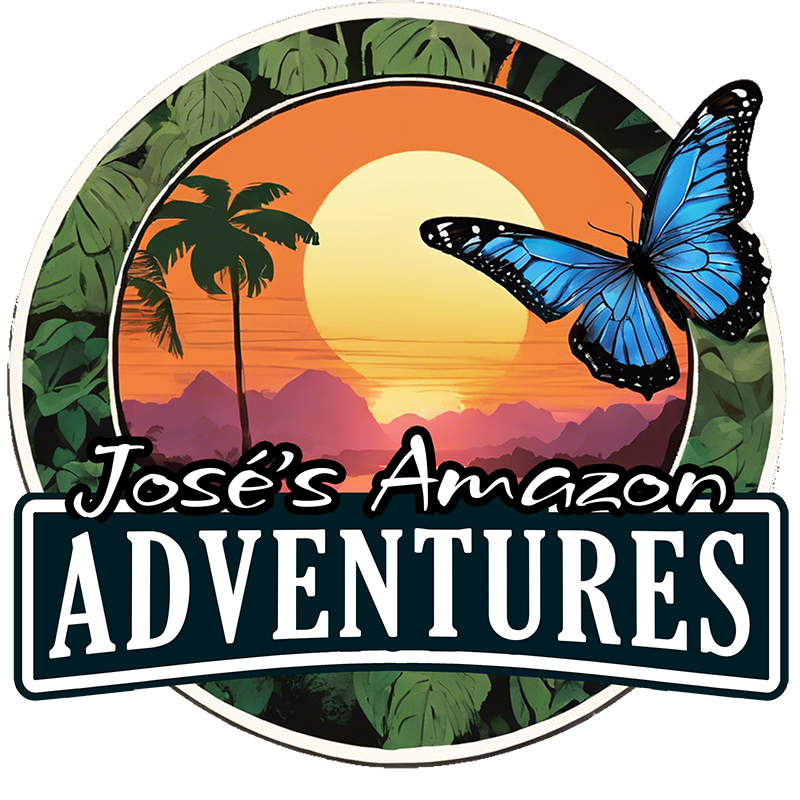
Amazon Jungle Tours in Iquitos
Join josé for an unforgettable tour experience in the amazon rainforest..
Discover the wonders of the Amazon with José’s Amazon Adventures. From vibrant markets to exotic wildlife encounters, embark on unforgettable journeys in the heart of Peru’s lush rainforest.
Located In Iquitos
Group & private tours, expert local guide, english speaking, welcome to josé’s amazon adventures.
Welcome to José’s Amazon Adventures, where the incredible beauty of the Amazon rainforest awaits your exploration. Based in the vibrant city of Iquitos, Peru, our tours offer an immersive journey into the heart of this biodiverse paradise. Led by José, a seasoned local guide with a deep connection to the jungle, our adventures promise unforgettable experiences and authentic encounters with the wonders of the Amazon.
Whether you’re seeking thrilling river excursions, cultural immersion in indigenous communities, or a chance to sample exotic fruits and crafts at bustling markets, José’s Amazon Adventures has something for every adventurer. Our sustainable and responsible approach ensures minimal impact on the environment while supporting the livelihoods of local communities.
Join us as we navigate the labyrinthine waterways of the Amazon, marvel at the vibrant colors of Belen Market, and uncover the secrets of ancient tribes. From the tranquil beauty of the rainforest to the exhilarating wildlife encounters, every moment with José’s Amazon Adventures is an opportunity for discovery and connection with nature.
Embark on a journey of a lifetime with us and let the magic of the Amazon captivate your soul.
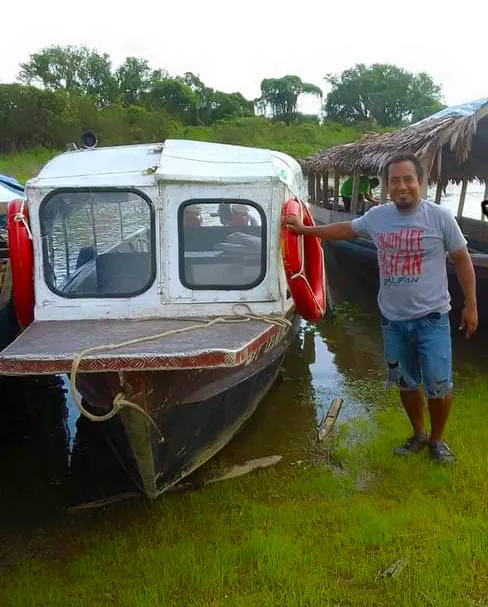
José’s Amazon Adventures
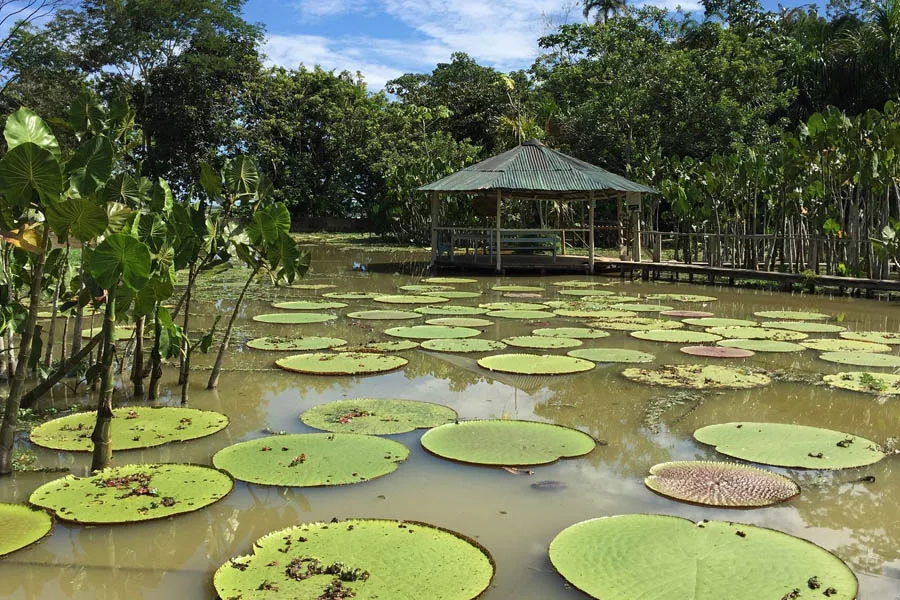
Visit Fundo Pedrito
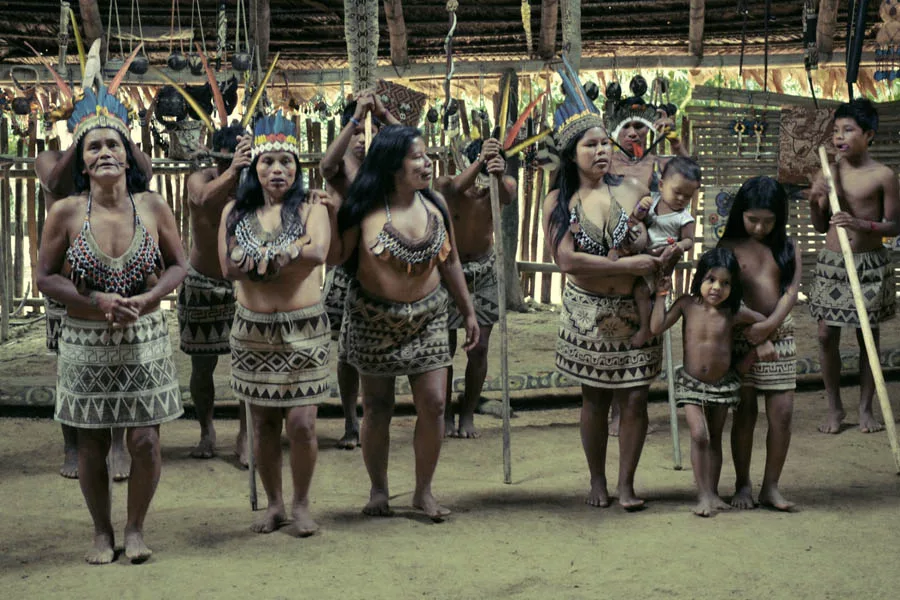
Bora Tribe & Butterfly Farm

Belen Market Tour
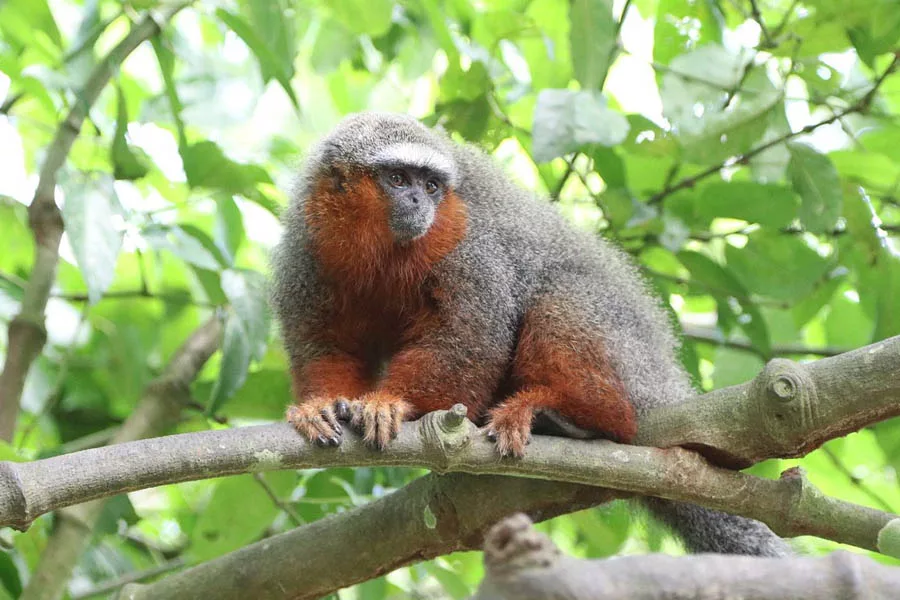
Trip To Monkey Island
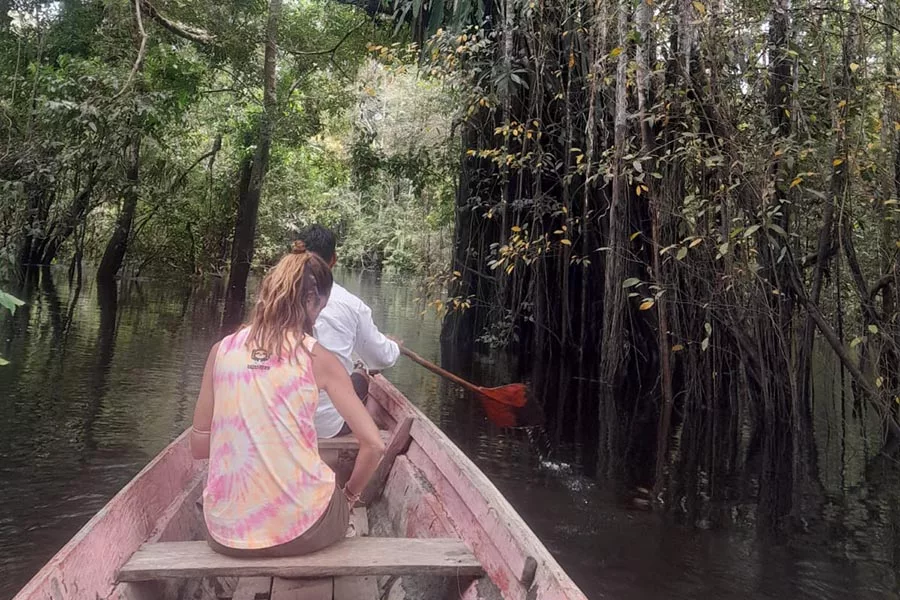
Mazanillo Creek
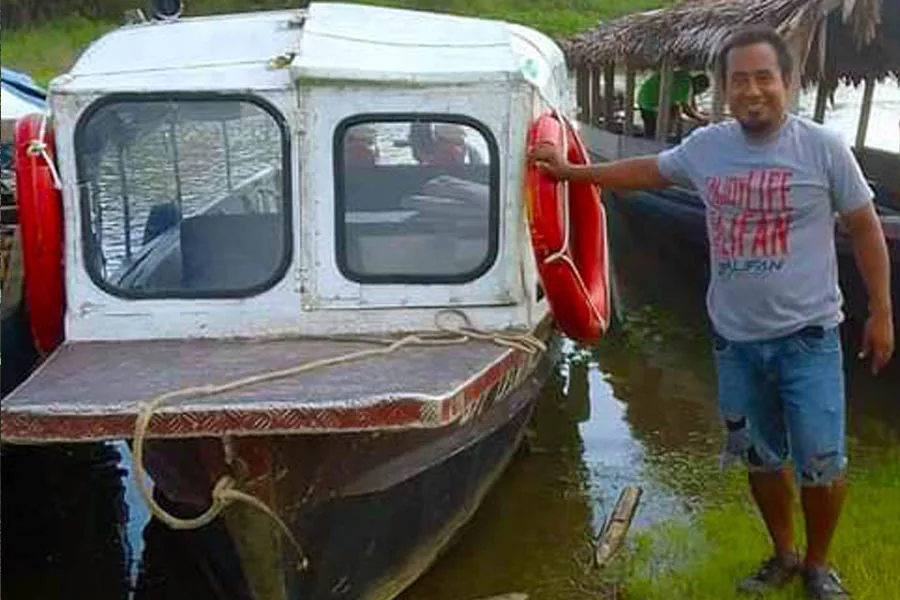
Book your adventure today!
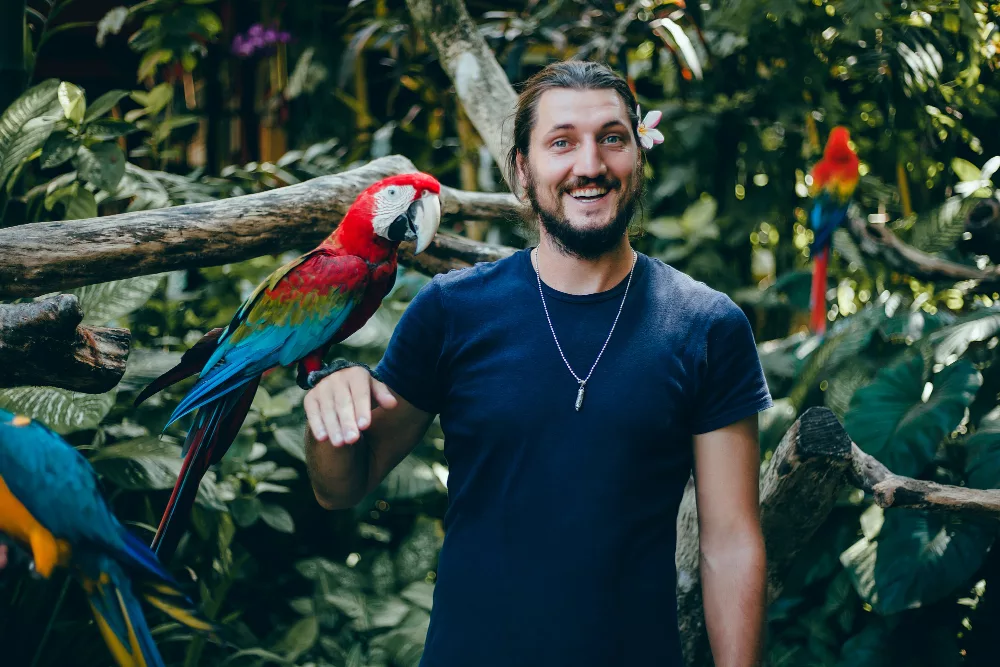
Why Iquitos, Peru Should Be Your Next Amazon Adventure Destination
Nestled in the heart of the Amazon rainforest, Iquitos, Peru, beckons adventurers with its unparalleled biodiversity, rich cultural heritage, and untamed natural beauty. As one of the largest cities in the world inaccessible by road, Iquitos serves as the gateway to the Peruvian Amazon, offering visitors a truly unique and immersive experience. Here are just a few reasons why this vibrant city should be at the top of your travel bucket list:
1. Biodiversity Beyond Compare: The Amazon rainforest is often hailed as the “Lungs of the Earth” for its vital role in regulating the planet’s climate and harboring an astonishing array of flora and fauna. In Iquitos, you’ll have the opportunity to witness this biodiversity firsthand, with countless species of plants, animals, and insects calling the region home. From iconic creatures like jaguars, sloths, and pink river dolphins to elusive birds and insects, every corner of the jungle teems with life waiting to be discovered.
2. Immersive Cultural Encounters: Beyond its natural wonders, Iquitos is also a melting pot of diverse cultures and traditions. Indigenous communities have inhabited the Amazon for centuries, preserving their unique way of life amidst the lush greenery. Visitors to Iquitos have the chance to engage with these communities, learning about their customs, beliefs, and traditional practices. Whether sharing a meal with a local family, participating in a traditional ceremony, or shopping for handicrafts at a bustling market, the cultural richness of the Amazon is sure to leave a lasting impression.
3. Unforgettable Adventures Await: Iquitos is a playground for outdoor enthusiasts, offering a wide range of activities to satisfy every appetite for adventure. Embark on a guided river cruise down the mighty Amazon, where you’ll glide past towering trees, hidden lagoons, and winding tributaries teeming with wildlife. Hike through pristine rainforest trails, listening to the symphony of bird calls and monkey chatter echoing through the canopy. For the more adventurous, zip-lining through the treetops, night safaris to spot nocturnal creatures, and fishing for piranhas are just a few of the thrilling experiences that await.
4. Support Sustainable Tourism: By choosing to visit Iquitos and the surrounding Amazon region, travelers have the opportunity to support sustainable tourism practices that benefit both the environment and local communities. Many tour operators in Iquitos are committed to responsible travel, minimizing their impact on the fragile ecosystem while providing economic opportunities for indigenous populations. From eco-friendly lodges to guided tours led by knowledgeable local guides, visitors can enjoy their Amazon adventure knowing they are contributing to the conservation of this precious natural resource.
In conclusion, a visit to the Amazon rainforest in Iquitos, Peru, is a journey into the heart of one of the most biodiverse and culturally rich regions on the planet. Whether you’re a nature lover, adventure seeker, or cultural enthusiast, Iquitos offers an unforgettable experience that will leave you with memories to last a lifetime. So pack your bags, prepare to disconnect from the hustle and bustle of everyday life, and immerse yourself in the wonder and magic of the Amazon. Your adventure awaits!

Which parts of the Amazon to visit depending on your travel style
When we think of the Amazon , we often envisage Indiana Jones-style adventurists with Bear Grylls survival skills, but it’s not totally out of bounds for ordinary folk. Here are seven places every traveller can visit, writes Eibhlis Gale-Coleman.
If you ever want to be slapped in the face by the paradox of your insignificance , visit the Amazon Rainforest. It’s safe to say it’s massive, with 6.7 million sprawling square kilometres with corners in eight countries. Yet the region is a delicate balance of different ecosystems that demand our protection. It cradles rare wildlife like jaguars and pink river dolphins and houses up to 22% of the Earth’s plant species, many of which are found nowhere else in the world.
With such diversity, which region you pick is of great importance. These are seven spots to keep in mind.
Yasuni National Park, Ecuador
Yasuni National Park attracts the vast majority of Amazon tourism in Ecuador, where the eastern third of the country lies in the Amazon basin. As a result, it’s an optimal choice for those wanting a slick experience, with clockwork transfers to moderate-to-luxury-priced lodges along the Napo River.
Yasuni National Park’s wet season runs from December until June, facilitating better canoe excursions, flowering plants, and primate sightings.
The park houses 600 bird species plus mammals like tapirs, capybaras, and — for the luckiest among visitors — jaguars. However, i ndigenous cultural preservation is where Yasuni flourishes, with the Waorani Nation leading the way in celebrating their traditions and extensive botanical knowledge alongside tourists.
Getting there: Fly to Coca or take an overnight bus from Quito. From Coca, take a motorised canoe.
Why visit: Indigenous culture and upscale lodges.
Accommodation: La Selva Amazon Jungle Lodge
READ MORE: Local Peru women living in Machu Picchu’s shadow visit for the first time
Cuyabeno Wildlife Reserve, Ecuador
Just north of Yasuni National Park is the Cuyabeno Wildlife Reserve, a quieter region of flooded wetlands along the narrower Cuyabeno River. Cuyabeno Wildlife Reserve holds plenty of indigenous culture, including the Siona community, who have shared insights into shaman beliefs and rituals for decades.
Cuyabeno Wildlife Reserve has a quieter appeal and an abundance of budget-friendly lodgings . You can easily find three-day experiences, including meals and activities, for less than $500.
As a wetland complex, essentially a “flooded forest” ecosystem, Cuyabeno has unrivalled access to lagoons and creeks. This is perfect for spotting pink river dolphins, monkeys, birds and caiman. It’s well-suited to wet or dry season travel, although the wet season is better if you want to swim in its largest lagoon.
Access: Overnight shuttle from Quito to Lago Agrio, then a motorised canoe ride.
Why visit: Precious flooded wetland habitats.
Accommodation: Green Forest Ecolodge
Tambopata, Peru
Tambopata is Peru’s top candidate for Amazon tourism as the most convenient region of protected rainforest (at least by Amazon standards). If you’re hitting Peru for a whistlestop visit, Tambopata is the most realistic itinerary addition. With plenty of lodge options and structured tourism experiences, you can easily organise a three- or four-day tour.
As the second-largest Amazon region, the Peruvian Amazon is special due to its varied elevation, creating a cloud forest phenomenon. Shrouded in mist and cloud, this results in near-constant precipitation rather than a reliance on rainfall.
At Tambopata, you can spot wildlife like boas, macaws, caimans, and primates. There’s also Chuncho Macaw Clay Lick, the world’s largest macaw clay lick, at Tambopata Research Centre.
Access: 30-minute flight or overnight bus from Cusco.
Why visit: Easy access to cloud forests.
Accommodation: Tambopata Research Centre
Manu National Park, Peru
Manu National Park is better suited to those who like a challenge. Unlike Tambopata, this region of the Peruvian Amazon is quite hard to access. It’s feasible enough through a guided tour, but it’s better for those with more time on their hands.
However, with superb altitude variation, Manu is a stunning place to witness cloud forests. And with wildlife like capybaras, primates and alligators, you’ll have plenty of incredible sightings.
Avoid the May to October wet season, where temperatures boom, and frequent downpours can make that long journey trickier.
Access: Take a bus from Cusco and a boat transfer. Alternatively, take a flight to Boca Manu or Puerto Maldonado and then a boat transfer.
Why visit: More remote terrain and spectacular wildlife sightings.
Accommodation: Treehouse Inn
Manaus, Brazil
Manaus is “the” place to experience the Brazilian Amazon. It’s a beautiful and practical choice, with a plethora of lodges and organised experiences.
Conservation biologist and Manaus expert Marcelo Goncalves de Lima emphasises its beauty, recommending a boat tour of Anavilhanas National Park, the world’s largest freshwater archipelago. Marcelo also recommends the Museu da Amazonia, a formal botanical garden, and sightseeing excursions to spot pink dolphins and primates.
“It is best to avoid the rainy season, from January to June”, Marcelo adds,” The rivers will be full as well, so you will miss the nice white sandy beaches of the Rio Negro and Tapajos”.
Access: Fly from Sao Paulo to Manaus.
Why visit: Flooded wetlands and established tourism infrastructure.
Accommodation: Amazon Ecopark Jungle Lodge
Cristalino Reserve, Brazil
Cristalino is the wallflower of the Brazilian Amazon, sitting on a private reserve of 11,000ha and accessible only by boat. Public reserves aren’t your only choices when visiting the Amazon Rainforest. Cristalino Reserve is a prime example of more exclusive areas you can access. Only open to guests of Cristalino Lodge, it experiences a pin-drop of foot traffic compared to Manaus.
Unlike Manaus, which is predominantly a wetland forest, Cristalino is a mixed forest reserve. As a quieter reserve, the likelihood of more elusive mammal sightings like jaguars also increases. Brazil holds 60% of the Amazon Rainforest, so researching these private reserves is worthwhile for more privacy and less condensed areas of tourism.
Access: Fly to Cuiaba and then Alta Floresta, followed by two hours by road and boat.
Why visit: Off-the-beaten track on a mixed forest reserve.
Accommodation: Cristalino Lodge
Leticia, Colombia
Colombia holds only approximately 10% of the Amazon Rainforest, but of that 10%, Leticia is the gateway. The border city has an international airport and borders Brazil and Peru. Unlike other options, Leticia sits directly on the banks of the Amazon River, not its tributaries.
The whole city lives and breathes an urban Amazon lifestyle, with parrots roosting amid the sound of motorbikes in its Santander Park and indigenous culture displayed at the Ethnographic Museum. It blends urban sightseeing with a launchpad for wildlife immersion experiences further along the river. Wildlife includes pink and grey dolphins, primates and even sloths.
Access: Fly from Bogota to LET Airport.
Why visit: Urban Amazon living.
Accommodation: Chunaki Ecolodges
Discover more
- Exploring the Amazon - Aucklander News
- South America: Peru with G Adventures takes you from ...
- A guide to cruising the Pacaya Samiria National Reserve ...
- The Z to A of river cruising, from the Zambezi to the ...
- Young explorer conquers Amazon's uncharted jungle route ...


- Amazon Adventures
- Rainforest Trips
- Jungle Excursions
- Manaus Jungle Tours
- Swimming with Dolphins (Private Day Tour)
- 2 days Jungle Tour
- 3 days Jungle Tour
- 4 days Jungle Tour
- 5 days Jungle Tour
- 9 days Adventure Tour
- 9 days Indigenous Community
- Our Tour Guides
- Photos & Videos
- Amazon Rainforest Trips
- 2 days Jungle Lodge & Adventure Tour
- 3 days Jungle Lodge & Adventure Tour
- 4 days Jungle Lodge & Adventure Tour
- 5 days Jungle Lodge & Adventure Tour
- 9 days Amazon Adventure Deep Jungle Tour
- 9 days Indigenous Community Deep Jungle Tour

Jungle Tours in the Amazon Jungle
We do jungle tours to Maçarico which is located 90 kilometers from Manaus. You can choose between 2 to 5 days. You will sleep in a nice jungle lodge at night and go on adventures during the day. We will go animal spotting in the jungle, you will learn basic jungle survival skills, and gain some cool knowledge about the plants and animals of the Amazon river and rainforest. The jungle lodge tours always start and end in Manaus and all transportation is included in the price.
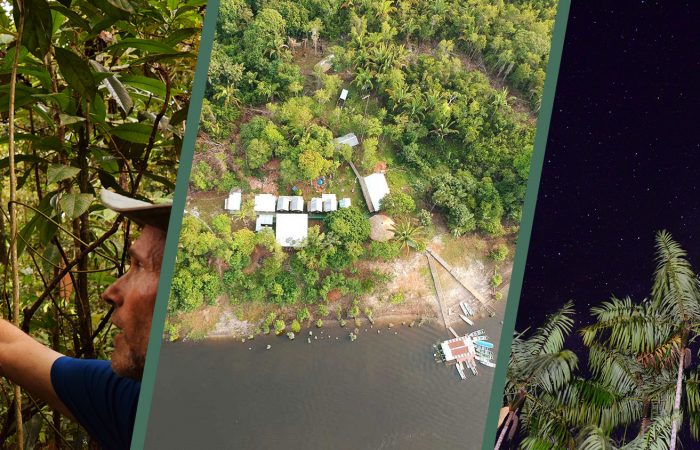
Jungle Lodge & Adventure Tour (5 days / 4 nights)
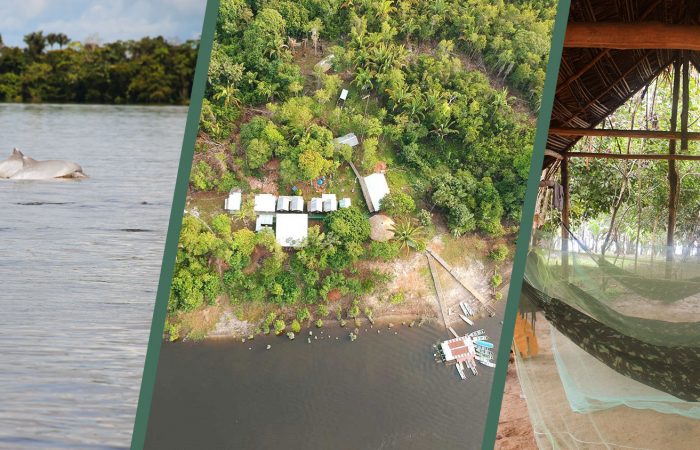
Jungle Lodge & Adventure Tour (4 days / 3 nights)
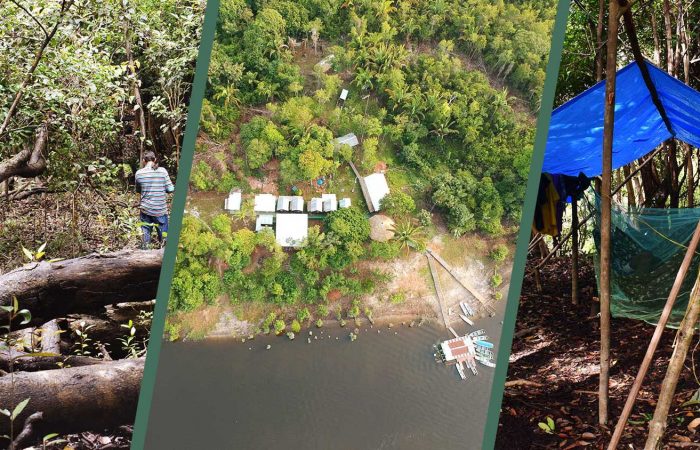
Jungle Lodge & Adventure Tour (3 days / 2 nights)
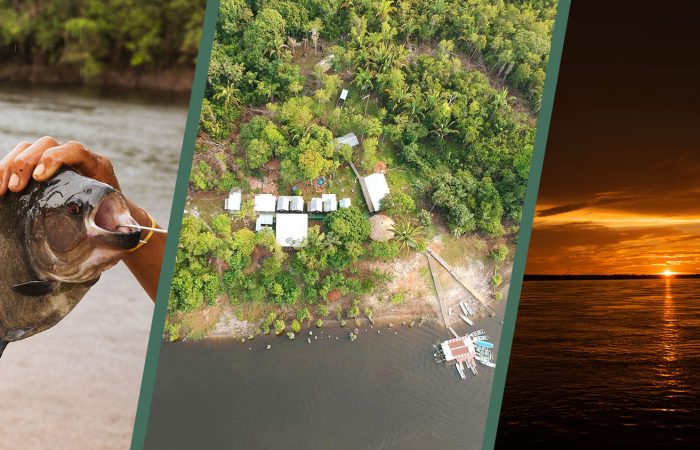
Jungle Lodge & Adventure Tour (2 days / 1 night)
Deep jungle tours from manaus.
We also offer extraordinary deep jungle tours to Maraã which is located 900 kilometers from Manaus. These tours always start and end in Manaus and all transportation is included in the price. You will get to experience some of the most pristine and untouched parts of the Amazon rainforest. We guarantee that this experience will stay with you for the rest of your life.
You can choose between two deep jungle tours. The adventure tour focuses on jungle trekking, survival skills and learning about the flora and fauna of the Amazon jungle. The indigenous community tour focuses primarily on the culture of the native inhabitants of the Amazon rainforest, but you will also get to experience some of the amazing animals of the jungle.
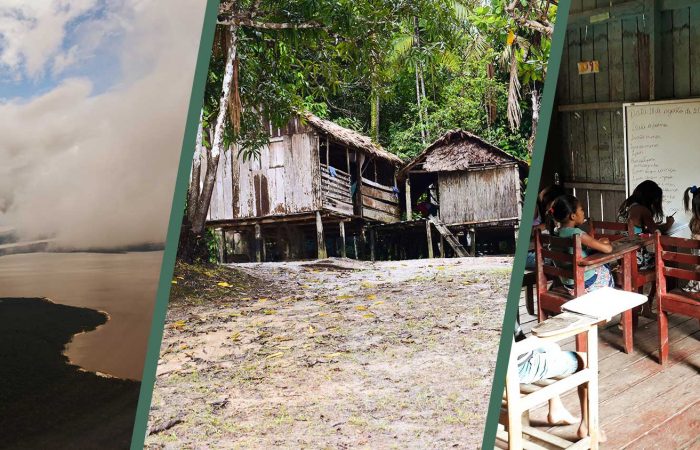
Indigenous Community Deep Jungle Tour (9 days)
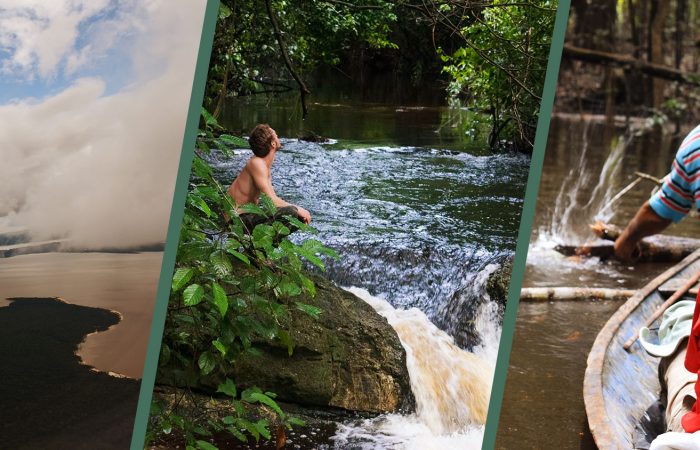
Amazon Adventure Deep Jungle Tour (9 days)
Swimming with dolphins.
Exclusive private day tour packed with activities. You will see The Meeting of the Waters, visit Parque Ecologico January, meet an indigenous tribe and last but not least you will get to swim with the amazing pink dolphins of the Amazon.
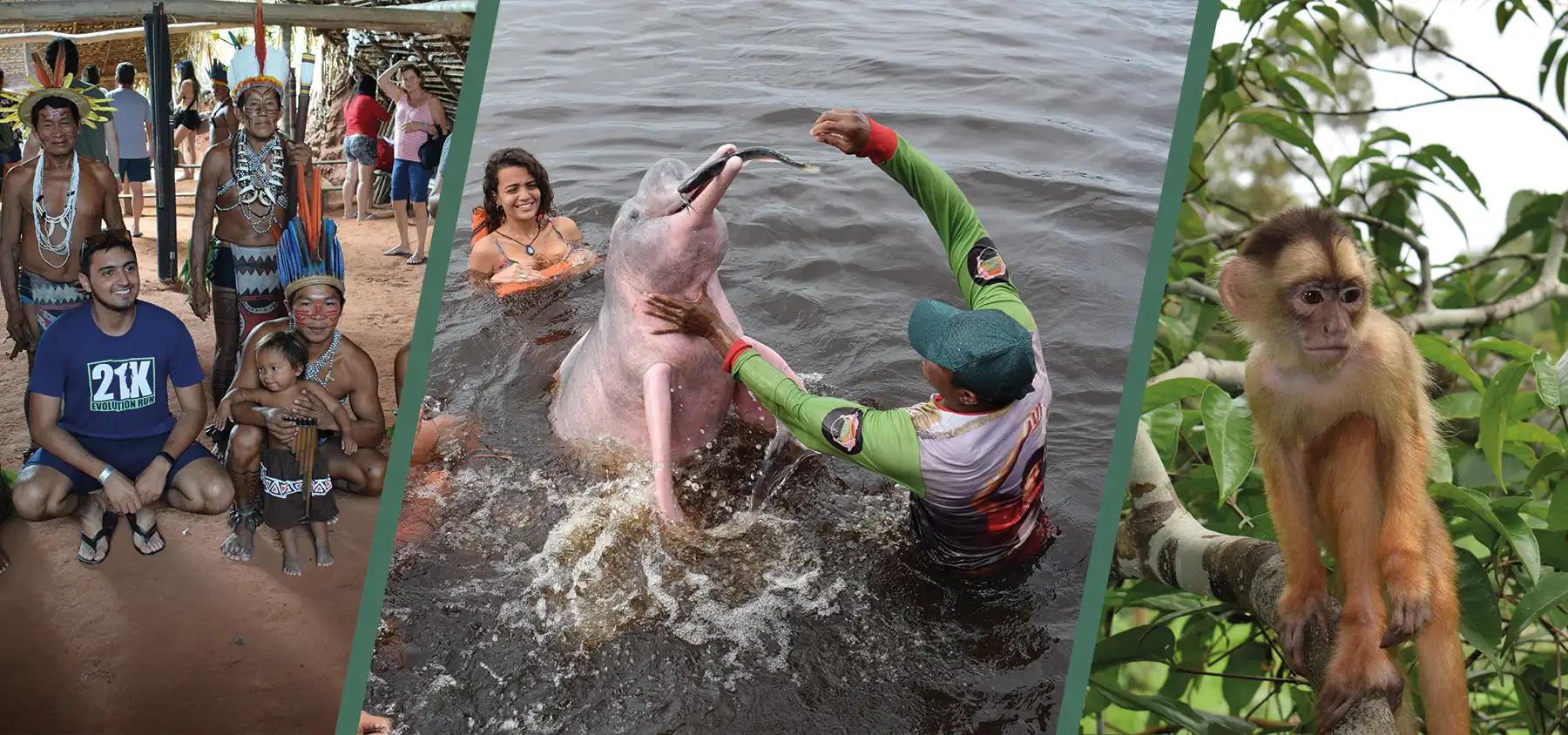
Swimming With Dolphins (Private Day Tour)
Follow us on instagram.

The Best Amazon Tours in Brazil
When traveling abroad, there are often two sides to every destination. On the one side, you can visit the typical spots of interest and see the more polished, high-traffic areas that cater to tourists. This is the most popular way to experience a destination, and it can certainly offer plenty of unique memories. However, the other side of traveling abroad is taking a more immersive approach. Instead of going where everyone else has been, you can choose to go where the locals go, live how they live and enjoy a richer slice of culture by diving deeply into a brand new experience.
This second option is at the heart of Amazon Deep Jungle Tours, and it’s what sets us apart from other Brazilian tour agencies that offer Amazon rainforest tours. Amazon Deep Jungle Tours is the result of one man’s deep passion for his Amazonian roots combined with a lot of hard work and dedication. Eduardo Tenhave is a native of the small, remote village of Maraã, which is located 920 kilometers from Manaus. His intense love for the Amazon and his family’s way of life, combined with his intrepid spirit and desire to connect with others, has led him to found this unique travel agency.
Amazon Deep Jungle Tours give people the chance to be fully immersed in the sights, sounds and lifestyle of Maraã, and allows you to safely enjoy the breathtaking beauty and wonder of the virgin Amazon jungle that surrounds Maraã. We want to create authentic and unforgettable adventures for visitors from around the world.
Our two destinations: Maraã and Maçarico
Our Amazon rainforest tours are unlike any that you can find anywhere else in Brazil. There are plenty of tour agencies to choose from, but there are none that can offer you a genuine and unique adventure like we can. Amazon Deep Jungle Tours takes great pride in offering a number of exciting tours that range from as little as two days to a full nine-day immersive experiences that will change your life. Regardless of which tour you choose, you will be treated to a trip that is packed full of amazing adventure, breathtaking beauty and wonderful people.
Maraã is the jewel of our Amazon tours, so we offer multiple ways for visitors to experience this unique local community and the surrounding area. Because it is so remote, all of our tours span multiple days so that you can enjoy the trip and absorb as much of the wild beauty of the Amazon as possible during your stay. Each of the 9-day Amazon jungle tours highlights a different aspect of Maraã and the indigenous way of life.
The Indigenous Community Tour
This tour spans nine days and allows visitors to become truly immersed in the culture of Maraã. The primary focus of this tour is to let you experience every aspect of the Maraã way of life, from fishing for your lunch to conversing with the locals about their daily lives.
One of the best parts of this tour is how connected to nature and each other you will begin to feel. The locals will be able to teach you a lot of new things about how their everyday lives go, and you will learn about a broad variety of techniques that the indigenous people use to not only survive but thrive within the depths of the Amazon rainforest.
This Amazon forest tour will also include plenty of opportunities for you to see and experience the jungle in all of its wild glory. The local guides are highly experienced in navigating through the jungle, and they will be able to point out all kinds of flora and fauna that are native to the area.
As a part of this tour, you will get to visit a few of the villages in the Maraã area and even spend a night in the rainforest living off the land just like the locals do. The tour guides are all residents of the area who have spent their entire lives in the Amazon, so you will be in excellent and capable hands the entire time.
The Adventure Tour
If you love adventure and exploration, or you want a truly immersive Amazon jungle tour, the rapids tour is an excellent trip to embark upon.
Instead of spending the bulk of your time becoming acquainted with the Maraã locals, you will spend the majority of the trip camping in the jungle near the Comapi rapids. You and your local guides will explore various fishing and hunting techniques to catch each meal, and you will learn about how to track and hunt animals.
During your treks through the jungle, you will get to learn about various medicinal and edible plants while also learning about the abundant wildlife that you will not see in other, more commercialized portions of the jungle.
Near the end of the tour, you will be able to get a glimpse of the indigenous culture and visit with the Maraã locals. You will get to see how the natives do things like cultivate crops, create food staples and make various other tools that they use to get through each day.
Maçarico is closer to Manaus than Maraã, but it still offers visitors plenty of opportunities for a unique jungle experience. Just 90 kilometers outside of Manaus, the jungle survival lodge in Maçarico is the perfect place to travel for a short, highly memorable adventure.
You can choose an excursion from 2-5 days in length, and your trip will be packed with the amazing sights and sounds of the Amazon rainforest regardless of how long you choose to stay.
During your excursion to Maçarico, you will get to swim and canoe in the Amazon river, search for native wildlife, catch wild caiman, learn to fish for your meals and so much more. You will have the opportunity to camp beneath the stars, meet with native residents of the jungle and experience how the jungle comes alive during the day as well as at night.
What makes us unique?
The Amazon is a true wonder of the world. It spans nearly 40 percent of South America, and it encompasses 1.4 billion acres of tropical forest and over 6,500 kilometers of river. There are 40,000 species of plants, 3,000 kinds of freshwater fish and over 370 species of reptiles, and this staggering list barely scratches the surface.
The absolutely astounding amount of plant and animal life that is found in the Amazon basin means that you could spend a lifetime exploring and still not see everything there is to see. This is why we choose to base our tours out of Maraã.
We take you where nobody else does
There are plenty of well-trodden places that tourists can visit to say that they’ve seen the Amazon, but we choose to take our guests to more remote and untouched locations so that you can get a true glimpse of the forest without human interference.
Our agency is the only one based in Maraã, so our tours are truly unlike any others available to you.
We teach you true Amazon culture
We believe in letting you experience the “back to nature” lifestyle that the people of Maraã live. We will teach you how to thrive as the locals do. The villagers are quite literally our family, and they are thrilled to meet new people and share their culture with you. They have lived in harmony with nature for generations, and they love to teach others how to appreciate the bounty of the Amazon.
No other tour agency has the kind of rapport with the indigenous people that we have, so your experience with us will have a level of authenticity that cannot be found anywhere else.
We are locals
Our authenticity and commitment to supporting the local communities is what sets us apart from other Amazon tour groups. All of our guides are natives, and everything we do is with the intent of bringing as much prosperity as possible to the people whose communities we are visiting.
Because we are a part of the people we are taking you to visit, you will have the privilege of getting to see the true culture of the Amazon rather than a more sanitized and “tourist-centered” experience.
We offer a unique bridge between your way of life and the culture of the Maraã people so that you can expand your horizons and take a small piece of the Amazon home in your heart.
Proceed Booking
Already a member.
Username or E-mail
Forget Password?
Don't have an account? Create one.
Deforestation in Brazil's Amazon rainforest is the lowest since 2016, government says
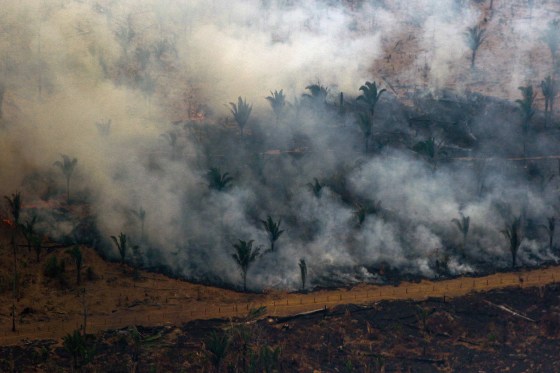
Deforestation in Brazil’s Amazon rainforest slowed by nearly half compared to the year before, according to government satellite data released Wednesday. It’s the largest reduction since 2016, when officials began using the current method of measurement.
In the past 12 months, the Amazon rainforest lost 4,300 square kilometers (1,700 square miles), an area roughly the size of Rhode Island. That’s a nearly 46% decrease compared to the previous period. Brazil’s deforestation surveillance year runs from August 1 to July 30.
Still, much remains to be done to end the destruction, and the month of July showed a 33% increase in tree cutting over July 2023. A strike by officials at federal environmental agencies contributed to this surge, said João Paulo Capobianco, executive secretary for the Environment Ministry, during a press conference in Brasília.
The figures are preliminary and come from the Deter satellite system, managed by the National Institute for Space Research and used by environmental law enforcement agencies to detect deforestation in real-time. The most accurate deforestation calculations are usually released in November.
President Luiz Inácio Lula da Silva has pledged “deforestation zero” by 2030. His current term ends in January 2027. Amazon deforestation has steeply declined since the end of far-right President Jair Bolsonaro’s rule in 2022. Under that government, forest loss reached a 15-year high.
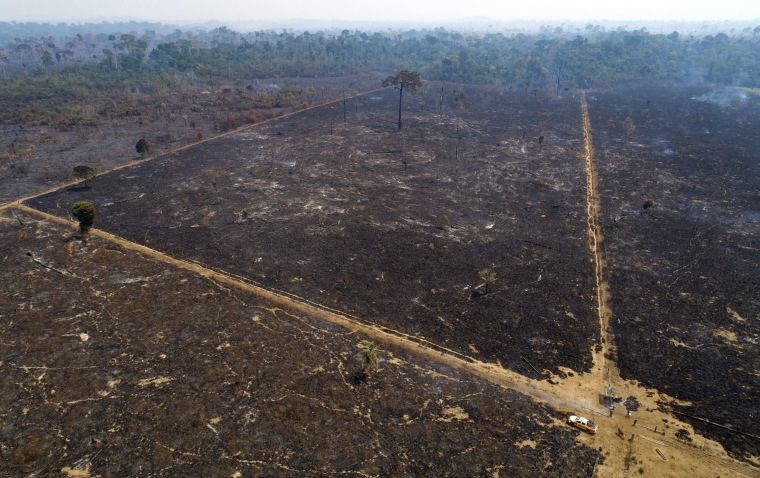
About two-thirds of the Amazon lies within Brazil. It remains the world’s largest rainforest, covering an area twice the size of India. The Amazon absorbs large amounts of carbon dioxide, preventing the climate from warming even faster than it would otherwise. It also holds about 20% of the world’s fresh water, and biodiversity that scientists have not yet come close to understanding, including at least 16,000 tree species.
During this same period, deforestation in Brazil´s vast savannah, known as the Cerrado , increased by 9%. The native vegetation loss reached 7,015 square kilometers (2,708 square miles) — an area 63% larger than the destruction in the Amazon.
The Cerrado is the world’s most biodiverse savannah, but less of it enjoys protected status than the rainforest to its north. Brazil´s boom in soybeans, the country’s second-largest export, have largely come from privately-owned areas in the Cerrado.
“The Cerrado has become a ‘sacrificed biome.’ Its topography lends itself to mechanized, large-scale commodity production,” Isabel Figueiredo, a spokesperson with the nonprofit Society, Population and Nature Institute told The Associated Press. Both Brazilians and the international community are more concerned about forests than savanna and open landscapes, she said, even though these ecosystems are also extremely biodiverse and essential for climate balance.
To control deforestation in the long term, monitoring, such as with satellites, and law enforcement are not enough, said Paulo Barreto via email, a researcher with the nonprofit Amazon Institute of People and the Environment. New protected areas are needed, both within and outside Indigenous territory, as well as more transparency so that slaughterhouses track where their cattle are coming from. Cattle ranching is the leading driver of deforestation in the Amazon. Degraded pasture lands also need to be replanted as forest, Barreto said, and there must be stricter rules for the financial sector to prevent the funding of deforestation.
Interviewed in in Brasilia, Environment and Climate Change Minister Marina Silva conceded said that so far, law enforcement has been the main tool against deforestation, but government action must and will be broader. “From now on, we need to combine continued law enforcement with support for sustainable productive activities, which is one of the pillars of our plan.”
- Cast & crew
- User reviews
The Last Front

Amidst World War I's chaos, a grieving father turns hero, leading villagers to safety while evading a relentless enemy driven by vengeance. Amidst World War I's chaos, a grieving father turns hero, leading villagers to safety while evading a relentless enemy driven by vengeance. Amidst World War I's chaos, a grieving father turns hero, leading villagers to safety while evading a relentless enemy driven by vengeance.
- Julien Hayet-Kerknawi
- Joe Anderson
- 4 User reviews
- 13 Critic reviews
- 56 Metascore

Top cast 27

- Peer Schultz

- Father Michael

- Maximilian Von Rauch

- Thomas Bosmans

- Dr. Janssen

- Camille Maes

- Corporal Weber
- Mother Pascal

- All cast & crew
- Production, box office & more at IMDbPro
More like this

Technical specs
- Runtime 1 hour 38 minutes
- Dolby Atmos
Related news
Contribute to this page.

- See more gaps
- Learn more about contributing
More to explore
Recently viewed.

IMAGES
COMMENTS
We'd recommend setting aside a minimum of three days to visit the Amazon Jungle in Peru. In this timeframe, you can embark on several excursions that provide a glimpse into the captivating offerings of this region. The most popular Amazon Jungle packages are 3 or 4 nights. Sunset views in the Amazon Jungle Peru.
The Peruvian Amazon: A Breathtaking Tapestry of Diversity. The vastness of the Peruvian Amazon, covering 7,000,000 km², with 5,500,000 km² as pristine rainforest, makes it a jewel in South America's crown. A staggering 13% of this ecological wonder belongs to Peru, ranking second only to Brazil. Despite this vast expanse, a mere 5% of Peru ...
The best time to go. In truth, the Amazon jungle can be explored all year round. Even in spite of its enormity, the weather conditions here don't really vary between seasons - expect it to be warm, rainy and humid. January to June marks the wet season, with temperatures sitting between 23 and 30ºC (that's 73 to 86ºF).
The most popular time to visit the Amazon is in July and August. The height of water in the jungle is reasonable, and you have a high chance of spotting wildlife. The advantage of traveling in the dry season is many hiking trails that are not underwater; on the other hand, some river parts do not have to be passable.
This guide features activities in Brazil, Peru, and Ecuador —the best jump-off points for Amazon rainforest trips. 1. Set off on an epic Amazon river cruise. Image: Getty. The Amazon River flows through the entire rainforest, so it's no surprise that most deep Amazon excursions are only possible by boat.
The best way to get to the Amazon rainforest in Brazil is to fly to Eduardo Gomes International Airport in the city of Manaus. Known as the gateway to the Brazilian Amazon, Manaus is the main tourist hub in the region and the capital of the Amazonas state. You can take a direct flight from Sao Paulo to Amazon rainforest (Manaus), which takes ...
The Complete Peruvian Amazon Travel Guide. With amazing wildlife, vibrant flora, and unique local jungle communities, the Peruvian Amazon beholds exciting adventures for any traveler. Let's take a deep dive into the lush Amazon rainforest and discover areas to explore, best time to visit, travel essentials, and top multi-day tours.
The best time to visit the Amazon in Peru, specifically Tambopata, is during the dry season, which runs from May to September. This period offers more stable weather conditions with less rainfall, making it easier to explore the rainforest, go on wildlife excursions, and enjoy outdoor activities.
Peru's Amazon rainforest offers stunning biodiversity, remote villages, and an enormous range of adventures. Our insider Will shares how to visit and helps you navigate your choices. Covering more than half of Peru, the Peruvian Amazon can be roughly divided into three different areas; the southern, central, and northern selva (jungle).
Manu National Park, Peru. 3. Manu National Park (Peru) Another huge protected area that folds into an even bigger complex of preserves, Peru's Manu National Park an absolutely world-class ecotourism destination and definitely a shortlist contender for the best place to see Amazon wildlife. The variety here is spectacular, on account of the 1. ...
5 Best Amazon Rainforest Tours for 2024. Tour Name. Price. Duration. Description. Amazon, Pantanal & Iguazu Falls Tour. from $2189. 10 Days. The Amazon, Pantanal and Iguazu Falls Tour is your ticket to see some of the world's most incredible natural landscapes.
Best places to visit in the Amazon rainforest. As the River Amazon meanders across the continent, it passes different port cities that act as gateways to explore this ecozystem. Although over 60% of the Amazon is located in Brazil, the other main gateways are found in Peru and Ecuador. These gateway cities have the most options for booking ...
The Tambopata National Reserve offers a fantastic area of Amazonia to visit. Protecting 274,690 hectares, the reserve includes forest fed by the Tambopata and Heath rivers. Because Tambopata is so close to the gateway jungle town of Puerto Maldonado, this is often the best choice for a short 2 or 3-day rainforest tour.
Please refer to each individual program for current data. 1. AFS Brazil Global Prep: Amazon River Odyssey — Leave the first review! This isn't any regular Amazon tour; it's an incredible river odyssey in the Amazon Rainforest. This trip includes a stay in the capital of the Amazonas region, Manaus.
Amazon Rainforest Travel Guide. The definitive Amazon Rainforest travel guide with tips on how to visit, expert Amazon River cruise advice, and ideas for planning a trip to the Amazon Rainforest for the most rewarding of Amazon vacations. Cuisine. Culture. Inspiration.
Gain a new perspective of the Amazon on a visit to the jungle canopy. The startling diversity in flora and fauna varies not only by habitat but also by distance from the rainforest floor. The canopy bridge at the Inkaterra Reserva Amazonica jungle lodge swings 31 meters (103 feet) above the rainforest floor.
The huge rainforest is spread throughout nine nations in South America, including Bolivia, Brazil, Colombia, Ecuador, and Peru. However, Brazil is where it is most noticeable and popular.Each country offers a unique way to visit the Amazon rainforest and learn about it.If considering a trip to the Amazon of Peru, tourists should head to Cusco, from where flights may be scheduled to Iquitos ...
5. Cuyabeno Wildlife Reserve. Nestled within the heart of the Amazon rainforest, Cuyabeno Wildlife Reserve is a hidden gem that offers an extraordinary wildlife experience. Explore the winding black-water rivers by canoe, and keep your eyes peeled for fascinating creatures such as caimans, giant anacondas, and elusive jaguars.
As you stand at the confluence, watch the rivers dance beside each other. It's easy to see why this is one of the best things to do in the Amazon, reminding you of the Amazon's grandeur and the many secrets it holds. Rio Negro meets sandy Solimões River, stunning confluence. 3. Amazon's Canopy Adventures.
2. Plaza de Armas de Iquitos. In addition to exceptional wildlife viewing, you can also explore the towns within the Amazon. Head to the port city of Iquitos in Peru for a fascinating visit, including a stroll around the Plaza de Armas. This busy central plaza sits among European-styled buildings built during the historic rubber boom.
In conclusion, a visit to the Amazon rainforest in Iquitos, Peru, is a journey into the heart of one of the most biodiverse and culturally rich regions on the planet. Whether you're a nature lover, adventure seeker, or cultural enthusiast, Iquitos offers an unforgettable experience that will leave you with memories to last a lifetime.
Discover amazing wildlife of Amazon! In this scenic film you will see the most incredible wild animals and birds that call the jungle home! These are some of...
Accommodation: Amazon Ecopark Jungle Lodge Cristalino Reserve, Brazil Cristalino is the wallflower of the Brazilian Amazon, sitting on a private reserve of 11,000ha and accessible only by boat.
Deep Jungle Tours from Manaus. 9 days / 8 nights jungle tours. We also offer extraordinary deep jungle tours to Maraã which is located 900 kilometers from Manaus. These tours always start and end in Manaus and all transportation is included in the price. You will get to experience some of the most pristine and untouched parts of the Amazon ...
In the past 12 months, the Amazon rainforest lost 1,700 square miles, a nearly 46% decrease compared with the previous period. IE 11 is not supported. For an optimal experience visit our site on ...
Brian Connolly is an Amazon seller, ecommerce expert, and writer for Jungle Scout. He lives in the New Jersey Shore area with his wife and cat. When he isn't writing advice online for aspiring and experienced Amazon sellers for Jungle Scout, he spends his free time boating, fishing, and selling boating-themed items on his Amazon business.
The Last Front: Directed by Julien Hayet-Kerknawi. With Iain Glen, Sasha Luss, Joe Anderson, Leander Vyvey. Amidst World War I's chaos, a grieving father turns hero, leading villagers to safety while evading a relentless enemy driven by vengeance.